RETURN OF THE "STEALTH" GLIDER
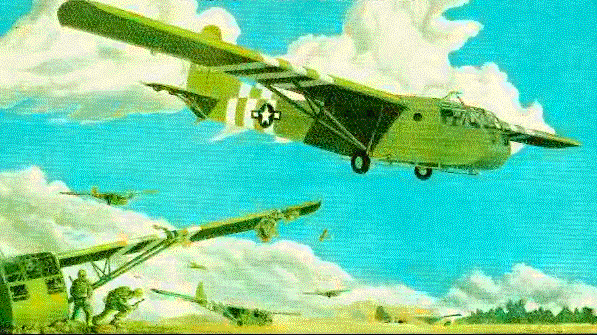
Fortress Eban Emael. 1940.
This impregnable fortress blocks Germany from driving through Belgium like it did in World War I. Formed of huge gun positions with massive thick concrete walls. It would take at least a division to seize, but in the early dawn while the Belgium defenders looked out horizontally, German Fallschirmjaegers(Paratroopers) and gliders did the impossible. A group of less than 100 men land directly on top of the fortress, skidding to a sudden stop. These men jump out of their gliders and with special shaped-charged explosives seized the fortress which is captured for advancing German Forces.
The Orne River Canal bridges. 1944. D-Day.
 www.youtube.com/v/3R9wixc0LKs
www.youtube.com/v/3R9wixc0LKs
Approaching the bridge, the night before D-Day are British Paratroopers in Horsa Gliders, these gliders land at both sides of the bridge. A desperate struggle between elements of the British 6th Airborne division and the German 716st and 21st Panzer Divisions for the vital strategic bridge over the Canal De Caen in Normandy, midway between the villages of Benouville and Le Port, during the night and day of 6th June 1944. The battle commences at 0016 with the daring glider borne coup de main assault on the bridge by "D" company 2nd Ox & Bucks Light Infantry, led by Major John Howard. They kill the the guards and take the bridges. These British 6th Airborne Division Paratroopers hold these positions and the left flank of the entire D-Day invasion---resulting in the bridge being renamed; "Pegasus Bridge".

The mighty Rhine River. 1945.
On the morning of March 24, 1945, an enormous air armada crossed the Rhein River near Wesel in western Germany. The column, two-and-a-half hours long, consisted of more than 1,500 IX Troop Carrier Command airplanes and gliders. To their left were about 1,200 RAF airplanes and gliders. The entire assemblage was supported by 880 U.S. and RAF fighters. This was Operation VARSITY, the Airborne support for the U.S. Ninth and British Second Armies' crossing of the Rhein.
Varsity was unique not only in magnitude. Three weeks before D-Day, Maj. Gen. William M. Miley, commander of the Army's 17th Airborne Division, briefed the glider operations officers of the 53rd Troop Carrier Wing's five groups on the impending operation. His 194th Glider Infantry Regiment needed one more infantry company to carry out its assignment. He asked for one of the troop carrier groups to provide that company, to be made up of glider pilots after they had landed in their designated zones. It would be an all-officer company, maybe the first in the history of modern warfare. Capt. Charles O. Gordon, glider operations officer of the 435th Troop Carrier Group, accepted this unusual assignment. He was to become commander of the provisional company. Personnel of the 194th Regiment trained his glider pilots for two weeks in infantry tactics and weapons.
The vast majority of the glider pilots were second lieutenants or flight officers. None had ever expected to serve as infantry, but they accepted that duty enthusiastically. These men were organized into four platoons, one for each of the group's squadrons. Most squad leaders were second lieutenants. They were to assist the 17th Airborne Division in securing a designated area northeast of Wesel, establish roadblocks, and make contact with British forces northeast of the town. For the first time, each of the 435th's C-47s would be towing two gliders; and, for the first time, their landing zones would not have been secured by Paratroopers.
When the 435th's 144 gliders, loaded with airborne infantry and equipment, cut loose over the landing area, they came under heavy ground fire with substantial casualties among the infantry and glider crews. Once on the ground, they continued to be hit by sniper and mortar fire that had to be subdued before they could move to their assigned area of two crossroads--one that would earn the name "Burp Gun Corner." There they cleared several houses, taking a large number of prisoners before digging in for the night.
Several times, small groups of German Soldiers attempted to infiltrate their defensive positions but were driven off in a series of firefights. The defenders knew that German troops, retreating ahead of British forces, would attempt to overrun their position, probably supported by armor and mobile guns. The ground held by the glider pilots was at the top of a ridge, the country sloping away toward Wesel, the direction from which an enemy attack would come. The reverse slope would allow enemy forces to advance almost to the 435th's area before coming under fire.
About midnight, the first attack by a German tank, supported by a large number of infantry, hit the crossroad defended by the 75th Platoon. They came under heavy fire and retreated. Thirty minutes later, a German tank and approximately 200 German infantry, supported by two 20mm flak guns, attacked the position defended by the 77th Platoon. As soon as the enemy troops were in close range, the glider pilots of that platoon, where the attack was concentrated, opened fire. Small-arms fire took a heavy toll on enemy infantry during the hour-long battle.
Flight Officers Chester Deshurley and Albert Hurley held their positions, firing their machine guns until the tank came within fifteen yards of them, as did Flight Officer Robert Campbell, armed with a tommy gun [Thompson SMG]. At that point, Flight Officer Elbert Jella severely damaged the tank with his bazooka. The retreating tank ran over one of its flak guns; the other was captured by the glider pilots.
At daybreak, the glider pilots defeated several smaller attacks and joined up with British forces coming out of Wesel. Their job was done with the professionalism of veteran infantry troops. They soon were relieved from further duty as ground Soldiers. Overall, they suffered 31 casualties in the operation, killed a large number of enemy troops, and captured several hundred prisoners.
"The Battle of Burp Gun Corner," a unique event in Air Force history, was covered by Stars and Stripes but then slipped into obscurity. In March 1995, Air Force Chief of Staff Gen. Ronald R. Fogleman learned from retired Maj. Charles Gordon of the heroic actions of these glider pilots turned infantry and directed that appropriate awards be made to those who took part in the fighting. At the 435th Troop Carrier Reunion in October 1995, Flight Officers Jella, Deshurley, Campbell, and Hurley each were awarded the Silver Star. All others who fought in the battle were awarded the Bronze Star, but many of those more than 280 men had died before their heroism was recognized.
The Glider.
Most of us think of gliders being towed by C-47 "Gooney Birds" watching the film A Bridge Too Far or The Longest Day. In Operation Burma, a glider is "snatched" from the ground by a low-flying C-47 and towed back to base. In these films, the glider is shown to be a stunning success. You then may ask why we are not using gliders today?

When Hitler needed them, they were ready. So it was that at dawn on May 10, 1940 nine gliders containing 78 German Paratroopers landed on the grassed-over roof of a massive fort at Eben Emael on the Belgian border. The surprise attack was a complete success. Anti-aircraft gunners were quickly overpowered, the gun emplacements were blown up, and within hours the 850 or so defenders, prisoners in their own fort, had surrendered.
 www.youtube.com/user/2bn442RCT#grid/user/C506D01BF22C00AB
www.youtube.com/user/2bn442RCT#grid/user/C506D01BF22C00AB
Impressed by this stunning success, the Japanese and British began their own glider programs. But it was not until almost a year had passed, by which time it had begun to seem more and more likely that America would become involved in the war, that Major General Henry "Hap" Arnold, chief of U.S. Army Air Force, gave the order to begin development of a glider that could carry troops and hardware and land behind enemy lines.
Any lingering doubts about the efficacy of gliders in war were dispelled by the German capture of Crete in early summer 1941. The island was taken from defending New Zealand troops by an entirely Airborne force which either dropped by parachute or landed in gliders. Ironically though, so many German troops were killed that Hitler swore never to use Airborne troops again. And so Germany's pioneering use of gliders ended just as the Allies' was beginning.
 www.youtube.com/watch?v=5zo4PTMg9uA
www.youtube.com/watch?v=5zo4PTMg9uA
In America, the glider program began slowly but received a mighty boost after Pearl Harbor on Dec. 7. Arnold looked around for someone to run it, but there were no military personnel with any experience. And so he chose a civilian champion sports glider pilot, Major Lewis Barringer, whom he brought to Washington, D.C., and gave the rank of major. Soon thosands of glider pilots were trained and their contributions to Allied victory were immense. Gliders saved the day in numerous WWII battles, flying General Orde Wingate's Chindits hundreds of miles behind Japanese lines to flying in doctors to the 101st Airborne Division surrounded at Bostogne. Gerard Devlin's Silent Wings and Milton Dank's The Glider Gang vividly illustrate the epic heroism of our glider troops, who upon landing fought as Airborne infantry. Truly, our glider pilots were the "Forgotten Heroes" of WWII, but this is going to change as you will soon see, as they were just a little bit ahead of their time for technology to fully exploit the military potential of the glider.
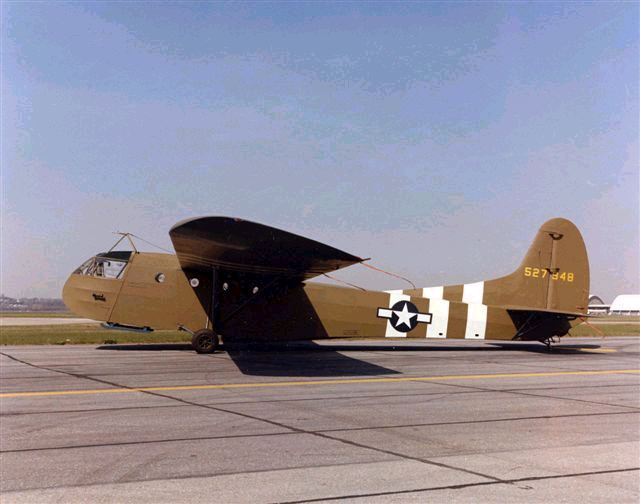
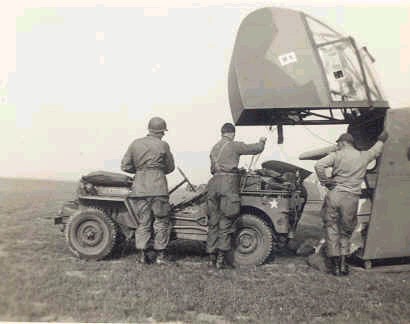
When you study the history of the glider in World War II, you will see the basic purpose of the glider was to either seize objectives by stealth (Coup de main: the top two examples) or to deliver jeeps, light tanks, artillery pieces and heavy supplies that parachutes couldn't deliver at that time (Air-delivered logistics). However, these gliders had to be towed by another airplane very close to the targets and then cut free. This is where all the problems come from. Tow ropes would break. Gliders would get tangled up with the tow aircraft. The entire procedure was very tricky.
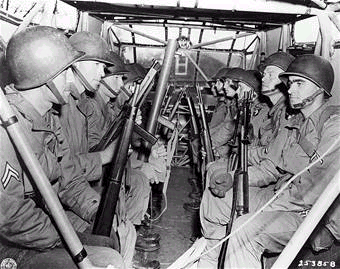
A Retired USAF LTC "Oregon" Jerry Baird USAF with an awesome career flying everything from gliders to jet transports writes:
The original C-123 concept was derived from the YG-18 and was designated YG-20, as I recall. That glider would have been able to carry 10,000 - 16 000 lbs of cargo/pax. It would have been all weather with retractable gear and flaps, elec actuated and a 24 volt system with a put-put. It could be deiced in flight.
The helicopter signaled its death kneel. Could the need for silent insertion resurrect the glider?
Is it feasible? Could it be towed and snatched by a C-130?
I flew the CG-15A into the DZs of FT Bragg and was snatched out by C-47 several times."
"In addition to silence, the glider has the advantage of a portion of a platoon already grouped and ready to fight as you well know. Four gliders landing together and you can have the makings of a small company. If you are devoted to the three concept, six gliders and you can have three platoons and a nearly full company.
The LTC is right. We need gliders today and they can be made to work better than ever before. The C-123 as a powered aircraft served throughout the Vietnam war and is showcased in the films, Air America and Con-Air

The U.S. Army's Mistake that Will Not Go Away: Has Light Tanks--But Often Refuses to Fly Them to Win Battles by Decisive Firepower & Maneuver
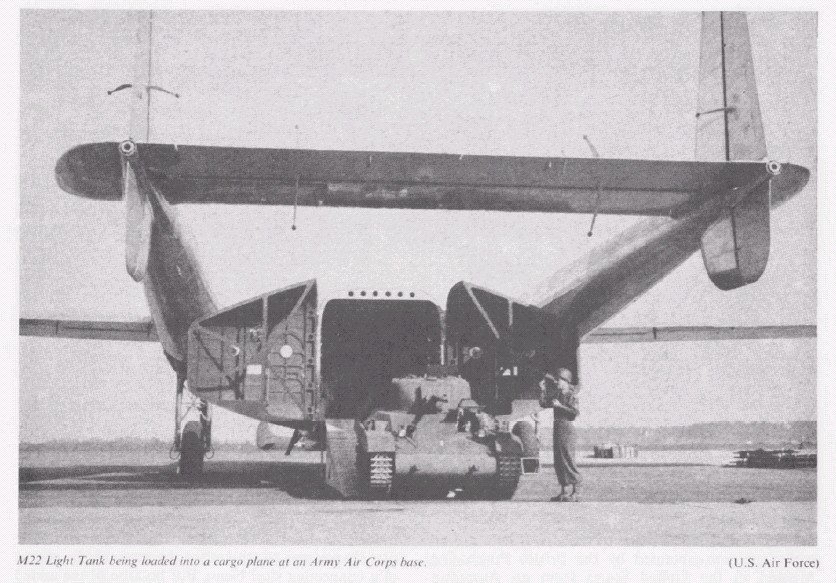
Persistent research into the history of the U.S. Army's misuse of its light tracked tanks continues to reveal new discoveries and horrors; a mistake that refuses to go away.
Battle losses in places like Task Force Smith, South Korea, Mogadishu, Somalia and Wanat, Afghanistan--where light tanks could have been brought to win the fight--but were not--have had no effect on successive generations of Army bureaucrats to fix our force structure.
Even battle victories where light tanks were taken to the fight--in places like the Pusan Perimeter and march to the Yalu river in Korea, Vietnam, Panama and mild successes like in Northern Iraq have also absurdly had no effect on Army bureaucrats and force structure! Since objective reality--negative (-) or positive (+) --has no effect on successive generations of Army bureaucrats--as well as the rank & file, it's clear the problem is a subjective one that keeps being perpetuated in the Army bureaucracy and non-professional culture. This essay will ascertain the blame and propose the needed corrections.
Prologue 1945: We Have Excellent Light Tanks
Our story begins with a generally-agreed by most experts as an EXCELLENT light tank, the 18.4 ton, steel M24 Chaffee
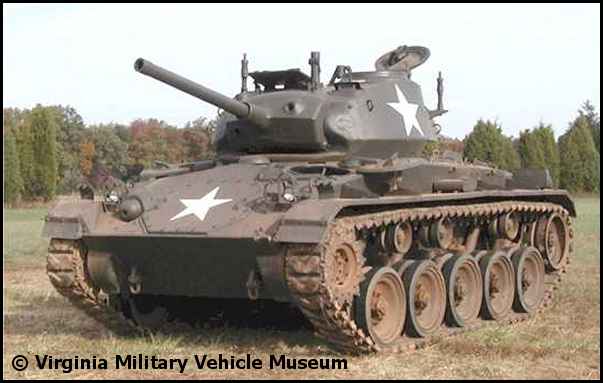
http://en.wikipedia.org/wiki/M24_Chaffee
...introduced in 1944 with the same 75mm gun as on the Sherman medium tank. M24s are still being used today by some of our allies some like Norway upgrade them (NM-116 variant) with safer M113 Gavin diesel engines and 90mm guns with better stabilized optics.
Unfortunately, the second generation of German medium, defensive tanks were impervious to front and side shots from not only the Sherman 75mm gun, but even our increasingly heavier and heavier 37mm and 57mm towed anti-tank guns--ever more difficult for the non-mechanized, walking infantry to man-handle. Recoilless rifles and rocket launchers "Bazookas" were embraced by the infantry as the short-range anti-tank, assault firepower "solution" at war's end. Yet 5 years later the 2.36" bazooka would fail miserably against Communist T34/85 medium tanks during the Task Force (TF) Smith debacle.
Note that the even superior, extremely fast 60 mph 17.7 ton M18 Hellcat light tank [http://en.wikipedia.org/wiki/M18_Hellcat] with a 76mm gun was highly successful killing all German tanks in WW2 and a 90mm gun-equipped Super Hellcat was available. The problem was they were in a sub-bureaucracy called "Tank Destroyers" that died when its patron, LTG McNair was killed in the botched Operation COBRA USAAF carpet-bombing in 1944--and was not around to stop the bureaucracy from disbanding them. With cavalry branch also disbanded the same year, the tank-dueling mentality in heavier and heavier tanks on the plains of Europe in main bodies clouded the minds of the new "Armor" branch.
At war's end, a light tank company of M24s would be ASSIGNED to the infantry division manned by "tankers"--outsiders--easily ignored and not factored into tactics and combat plans. In short, the walking infantry refusing to light mechanize itself, didn't want to be bothered with operating its own towed AT guns or its own light tanks to combat enemy tanks and provide fire support. More important activities like continuing the pre-WW2 "From Here to Eternity" routine of slow dismounted infantry drills and after-hours carousing beckoned. While the Army Airborne Center and Ground Forces wanted to get light tanks to the fight--they didn't have any airplanes available from the new separate service bureaucracy U.S. Air Force that could lift them--and didn't think ahead to make sure the new Army CG-10A Trojan Horse glider was large enough to carry light tanks--like the British did with their Hamilcars to fly Tetrarch and our own M22 Locust 37mm gun light tanks into Normandy on D-Day and across the Rhine.
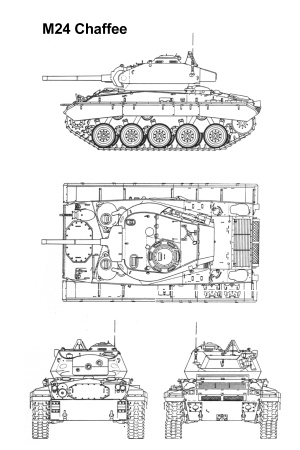
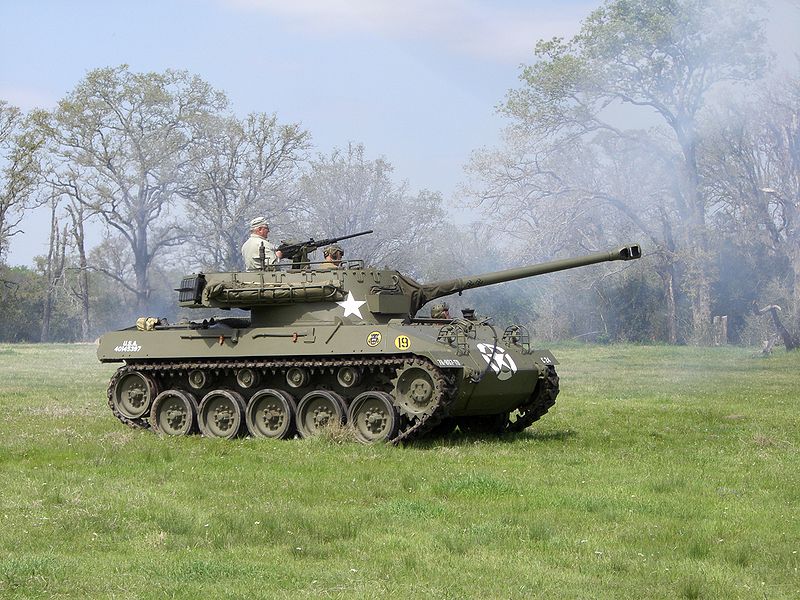
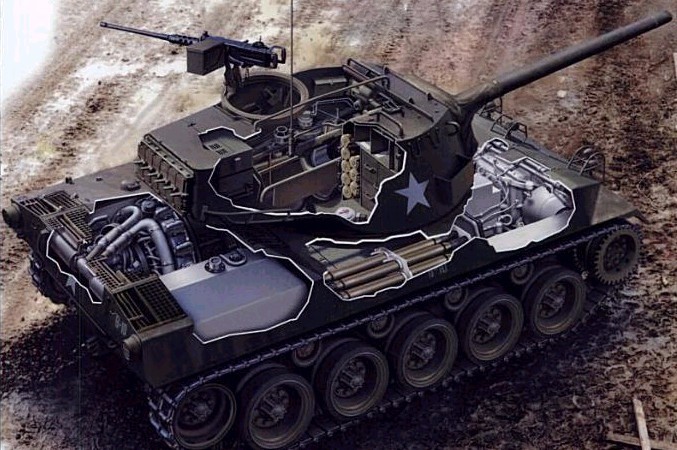
 www.youtube.com/watch?v=vWjQ7yPJtaA
www.youtube.com/watch?v=vWjQ7yPJtaA
We know from Keith Flint's book, Airborne Armour that the mere sight of the little Tetrarch light tanks resulted in the Germans not counter-attacking the British 6th Airborne on June 7, 1944. Why the American Airborne did not use its own M22 Locust light tanks and bought some Hamilcar gliders to deliver them is a big question--in light of the Arnhem failure and heavy casualties throughout the war due to a lack of fire support from an armored platform that could wade into enemy machine gun fire and suppress/destroy them. You hear a lot of commentators TODAY complaining about the Tetrarch/Locust's 37mm guns not threatening German tanks, but when you read actual WW2 combat reports infantry loved using towed 37mm AT guns to bust pill boxes and dug-in enemy positions.
combatreform.org/Combat-Lessons-01-the-Rank-and-File-in-Combat-What-They-re-Doing-How-They-Do-It-1944.pdf
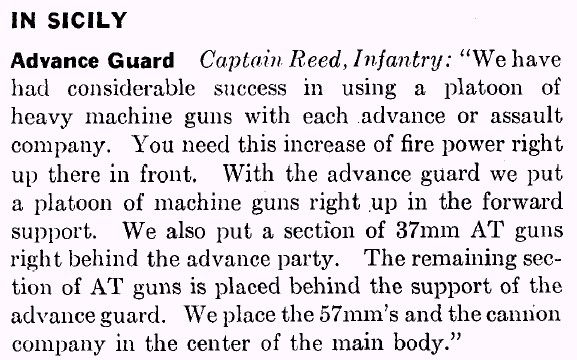

Thus, light tanks with 7.62mm medium machine guns and cannon shooting 37mm HE shells could have provided critical fire support that could not be deterred by enemy MG42 machine gun fire--which often suppressed and pinned-down our infantry:
combatreform.org/lightmachineguns.htm
Hamilcar When CG-20 glider prototypes that could deliver light tanks became available--the Army Airborne did not take note of them. When C-82 transport became available, the Army didn't take advantage of them, either.
Army Considers M24 and M18 Light Tank Air Delivery--then Gets Lazy
combatreform.org/freedroplighttanks1.jpg
From AFV Weapons Profiles #46, Profile Publications, Windsor UK, 1972, Light Tanks M22 Locust and M24 Chaffee by Colonel Robert J. Icks, Page 100
As the quote above shows, both the M24 and the M18 could have been dismantled into (2) loads so (5) men could reassemble them in 3.5 hours. Is it just me, or do I detect that this IS NOT THAT HARD TO DO, so the Army saying "No" is pure lazy bullshit. Colonel Icks screws up his narrative on page 102 by whining that the somehow 3.5 hours of work was "impractical" and then whined that carrying M22 Locusts with turret removed and in a C-54 was bad because the delivery aircraft needed a runway to land on--forgetting the FIRST PICTURE IN HIS BOOK showing a M22 offloading from a C-82--that did not need smooth runways. Its the picture I have posted at the top of this essay. Icks' anti-Airborne prejudice clearly shows.
1950: Disaster with Tank-less Task Force Smith in Korea
The result will be the M24 light tanks assigned to the 24th Infantry Division in Japan are not flown in by USAF aircraft along with Task Force Smith, that proceeds to get itself over-run by North Koreans with T34/85mm gun medium tanks. The M24s are brought over later by ship to the Pusan perimeter where they are at least able to hold off the heavier gunned T34/85mm medium tanks until Shermans and M26 Pershings with 90mm guns can be scraped together.
Page 105, Colonel Icks praises the M24 to the hilt.
Had the Airborne and Infantry branch not attempted to duck responsibility for its own AT/assault capabilities (foisting the job onto lazy tankers who don't want to fly), and been alert, M24 Chaffees or better yet--M18 Super Hellcat light tanks with 90mm guns superior to the Communist 85mm guns would have been ORGANIC to the infantry division--and USAF air delivery means secured to fly them to the fight.
Research shows even as things were, M3 half-tracks could have been flown underneath USAF C-54 four-engined transport planes to accompany TF Smith to Korea. Once there, 75mm pack howitzers or 75mm recoilless rifles, quad .50 caliber heavy machines guns could have been fitted to them for firepower and the half-tracks could have transported TF Smith infantrymen and towed artillerymen with some armor protection from NORK enemy fires--and insured they withdrew in good order. So the question remains how could the turreted M24 Chaffee or had we been-on-the-ball, M18 Super Hellcats with 90mm guns with overmatching firepower could have got to the fight using what was available at the time?
Lower the River: Make the Light Tanks Lighter
The first answer is of course NOT HAVE A TURRET like the most successful tanks of WW2, the German STUGs were arranged, to save weight and lower vehicle height while insuring powerful gun armament able to kill any sized enemy tank. More on this later.
Could M24/M18 turrets have been temporarily removed for USAF C-82/C-119 air transport and then re-assembled once in South Korea?
C-119 Flying Box Car
http://en.wikipedia.org/wiki/Fairchild_C-119_Flying_Boxcar
We already know the answer here. YES.
A mere 5 men and 3.5 hours of work into (2) loads. If turrets were removed from the M24/M18s, they could have been transported in less than 10-ton payload stages by C-119s to Japan and re-assembled to fire support TF Smith. We know this because of our own tests---and even the cash-strapped French did this in Indochina 4 years later delivering 10 x M24s to Dien Bien Phu. So really, there is no excuse.
Therefore, a lot of the blame rests on the Armor branch "tankers" having a good time chasing Japanese wine, women and song during occupation duty for not having developed the vigor to fly themselves to battle in pieces to pitch in and help.
This convenient, flimsy self-created excuse that one's tanks are "too heavy to fly" is often used by those in Armor branch and can been by the thousands of their tanks sitting in motor pools collecting dust here in CONUS when the USAF has C-17 Globemaster III turbofan jets that can fly ANY of them--even 70-ton M1 Abrams heavy types to any place in the world--as the infantry gets creamed on foot and in absurd road-bound wheeled trucks in Iraq/Afghanistan. As we will see, this excuse was NEVER true--even when we were limited by piston-engined aircraft!
Raise the Bridge: Making Aircraft Larger to Fly Existing Light Tanks
Gliders: What Was Wrong with American Gliders in WW2?
The first conclusion was that as typical, know-it-all Americans we didn't see any military use for gliders until the Germans "got in our faces" and seized Crete in 1941. Then, we went crazy on a crash-course to catch-up--and begin handing out contracts to anyone promising they could build gliders. Many men lost their lives in poorly constructed gliders, giving the concept a bad reputation--when actually it was due to American ignorance and incompetence.
What Made our Gliders Large Enough to Carry Jeeps?
Was it USAAF General Henry "Hap" Arnold ordering a "Flying Jeep"?
U.S. Army Report: "Development and Procurement of Gliders in the Army Air Force 1941-1944"
combatreform.org/Development-and-Procurement-of-Gliders-in-the-Army-Air-Force-1941-1944-USA-1946.pdf
On page 44 on the PDF document:
combatreform.org/generalarnoldsuggestsflyingjeep.jpg
Or British Jealousy Since their Gliders could carry Tanks?
combatreform.org/vonkarmansayshamilcarandlighttankjealousyledtojeepglider.jpg
Von Karman in his 1945 report on future Airborne warfare [combatreform.org/VKarman_FutureAirborneArmies_C5.pdf] contradicts the Arnold explanation and says it was jealousy after seeing the British Hamilcar glider that could carry a LIGHT TANK, that the USAAF insisted its gliders at least carry a jeep or a towed gun.
_____________________________________________________________
SIDEBAR: Flying Jeep Gliders? Combination Air/Ground Vehicles?
combatreform.org/vonkarmanairbornegrasshopperspage33.jpg
Karman also calls on the Airborne to have a folding-wing, STOL observation "grasshopper" plane that could be parachute dropped and even drive itself on roads! Similar to what Arnold wanted by a jeep that could fly.
combatreform.org/vonkarmanwantsflyingjeepairgroundvehicle.jpg
_________________________________________________________
So What Happened to Post-WW2 U.S. Gliders? Why Were They Not Made to Deliver Light Tanks? (One model was)
No Power; Towed into the air and to the Assault Zone, Snatched or discarded
The short answer is there was no excuse. As said before, in WW2 we could have got the plans from the British and built copies of their Hamilcar gliders to transport our own M22 Locust light tanks. These could have been improved after the war. Von Karman shows the pathetic state of U.S. glider payload capabilities far short of the British in the chart below.
combatreform.org/vonkarmangliderprogresschart.jpg
The long answer is contained in the long AAF glider report.
"Reader's Digest" summation:
Basically, the Waco CG-4A that could carry either a dozen infantrymen or one jeep or one towed gun (but not both at the same time) was GOOD ENOUGH for us to get by in WW2; so they mass-produced it and ignored larger gliders. Even the mildly improved CG-15 version of the CG-4A was too much deviation and not mass-produced.
CG-15
The CG-15 had less wing span in order for it to be towed at faster speeds. Had better pilot visibility and crash-worthiness.
CG-16
The infantry-centric mentality U.S. Airborne division wagging the logistics tail. As WW2 raged, when innovative designs like the Burnelli-style flying wing XCG-16 appeared, there was no time to pursue it, even though it offered a cushioning ground effect upon landing. Had the CG-16 been supersized to carry a light tank it would have offered a compelling capability.
CG-17
A sharp AAF LT suggested removing the engines from a C-47 and making it into America's first all-metal glider. It worked! It worked so well, it could be towed over 200 mph and carried more cargo than a powered C-47!
So why didn't they make C-47 gliders? The bureaucracy claimed that the C-47 couldn't crash land like a purpose-built glider. Charles Day writes:
The XCG-17 could carry 49 troops or three Jeeps or two 105mm howitzers with small tires. In comparison, the XCG-10A could carry 42 troops or two 105mm howitzers with combat tires or one 155mm M1A1 howitzer or one 2 1/2 ton 6x6 truck or one 1 1/2 ton 6x6 truck. Despite superior flight characteristics, the XCG-17 was deemed unacceptable because it did not fit the USAAF glider requirement that it be capable of landing on unimproved areas normally not suitable for aircraft.
Excuse me, but the C-47 with wheels retracted has a part of the wheel exposed for the very purpose of making belly landings smoother.
combatreform.org/gasolinejeepcausedburnedupglider.jpg
Airborne Soldiers would have been better protected during the assault landings, saving many lives. It seems the real reason was the bureaucracy was already committed to CG-4A mass-production using non-airplane steel tubing and wood and didn't want to change and start using powered airplanes made of aluminum for the task.
CG-13
The only large glider selected by the AAF to be built was the CG-13--that could carry 30 troops or a towed gun and a jeep. It was used once in the Pacific during the Aparri jump in the Philippines in 1945.
At WW2's end there was more enthusiasm for the XCG-10A "Trojan Horse" which featured a rear loading ramp, but could only carry 10, 000 pounds of men or cargo---the nose-loading British Hamilcar already carried 16, 000 pounds (8T) into combat several times in combat.
CG-10 "Trojan Horse"
The XCG-10 was a large military glider capable of accommodating 30 troops or a freight load of 5 short tons. It is a high-wing cantilever monoplane with a deep forward fuselage tapering to a tadpole boom which supports the tail unit. At the break in the bottom lines of the fuselage clam-shell doors give access to the main hold 30 ft.(9.15m) long, 7 ft. (2.14m) wide and 8 ft. 6 in. (2.59m) high, which can accommodate a 155mm howitzer or a 2 1/2 ton truck. Structure is entirely of wood with plywood covering. The wings are fitted with Fowler-type landing flaps and have an overall span of 105 ft. (32m). (info from Jane's Fighting Aircraft of World War II)
Additional info from Charles Day, "The XCG-10 and XCG-10A were two different craft. The 10 was a 30 place glider and the 10A was 42 place. Although some sources say the 10 did not exist and the project was changed to 10A in design stage, the 10 was built both as a static test article and a flight test article. The internal hold size was slightly larger for the 10A to accommodate the GM 6X6 truck. The wingspan stayed the same."
CG-20
WW2 is now over, and all-metal construction is now a possibility. The Army Airborne is still interested in gliders.
Karman describes a convoluted mess. It does list the M24 Chaffee light tank at 19 tons on the Army's shipping list of items desired to fly by air.
vonkarmanidiotic1945transportandgliderdecision1.jpg
vonkarmanidiotic1945transportandgliderdecision2.jpg
It appears the Army brain trust Karman is interfacing with does not realize that the Airborne needs to get light tanks to the fight with something NOW--and not lust after a mythical 50 ton aircraft to lift medium tanks--which incidentally will not arrive until 1969 with the C-5 Galaxy turbofan jet transport. Perhaps realizing this by reading General Gavin's 1947 book Airborne Warfare, on 2 December 1946 Chase Aircraft gets a contract to build two prototype gliders--and they decide to build really big all-metal gliders--big enough to transport light tanks.
www.globalsecurity.org/military/systems/aircraft/cg-20.htm
The CG-20 could take off at 70K--but was limited to 40K due to weak tow planes that were available. Apparently no one considered using JATO rockets to help...the Germans used rockets to lift their Me321 heavy gliders into the air...
www.aviastar.org/air/usa/chase_xcg-20.php
When mounted with 4 x J47 engines, the CG-20 (C-123A) weighed
25, 000 pounds
Each J47 engine weighed 2,707 pounds, so 4 x 2700 = 10, 800 lbs. total
Thus, we can conservatively estimate that the pure glider CG-20 minus the J47 jet engines weighed 15, 000 pounds empty
70K - 15K = 55K total payload
According to C-123 Provider in Action by Al Adcock, page 4, the CG-20's cargo compartment was 30 feet (360 inches) long, 12 feet (144 inches) wide and 10 feet (120 inches) high.
Clearly, the CG-20 had enough space inside for a M24/M18 light tank to fit inside and enough wing lift to be towed into the air to deliver them to the battlefield by crash-landing. In fact, the larger M41 that replaced the M24 at 23.5 tons and 126 inches could also be carried by the CG-20!
Low Power; Towed into the air and Assault Zone, Flies Self Back
If two small engines were fitted, the CG-20 empty could take-off and fly itself back to base if the assault landing zone was suitable. The U.S. modified a CG-4A with engines to enable self-recovery. Another fascination idea was to tow the low-powered glider to get it into the air, then disconnect and let it fly itself to the assault landing zone since it takes more power to take-off but less to stay aloft. The British Hamilcar with a P-38 Lightning on top as a powerplant/parasite fighter was an extremely clever idea with lots of tactical capabilities we should have at least tried. Details:
combatreform.org/airbornewarfare.htm
Full Power: Flies Self to Battle and Back
In fact, with 4 x J47 jet engines the CG-20 (C-123A) could take-off with 60K, so 60K - 25K = 35K total payload = still enough to fly the 17-ton M18 Hellcat up to speeds of 500 mph! Wow. Fantastic for 1950, huh?
Yet at the time, the USAF rejected the jet-powered CG-20 because its J47 engines were under-slung the wings and it ingested dirt. A flimsy and suspicious excuse from a service bureaucracy that always embraces any excuse to stay near pampered air bases. Why didn't anyone suggest PUTTING THE ENGINES ON TOP OF THE WINGS like the Fokker VFW614 commuter airliner?
http://en.wikipedia.org/wiki/VFW-Fokker_614
The aircraft was revealed to be of unconventional configuration, with two quiet, smoke-free, but untested M45H turbofans mounted on pylons above the wings. This arrangement was used to avoid the structural weight penalties of rear mounted engines and the potential ingestion problems of engines mounted under the wings, and allowed a short and sturdy undercarriage, specially suited for operations from poorly prepared runways.
Or at the top of the wings and using exhaust for Coanda effect like the YC-14 or the Russian AN-72 Coaler?
http://en.wikipedia.org/wiki/Antonov_An-72
An unusual design feature of the An-72 and An-74 is the use of the Coandă effect to improve STOL performance, utilizing engine exhaust gases blown over the wing's upper surface to boost lift.
The bottom line here is that the U.S. Army/Air Forces, and then the USAF made a mistake and should have purchased CG-20s in SOME CONFIGURATION in order to deliver M24/M18 light tanks for an immediate operational capability. These could have been ready by the time of TF Smith in Korea in 1950. Instead, everyone was too busy having fun celebrating the end of WW2.
Free Dropping Tanks or Kiwi Pods, Possibly Glider Kiwi pods
As bizarre as this sounds, the Russians had already dropped modified light tanks from a few feet above the ground from under low flying bombers. Photos and video:
combatreform.org/concepttoc.htm
The problem is getting the tank's tracks to go fast enough to meet the lowest possible speed of the plane to stay only a few feet above the ground or briefly to touch down.
combatreform.org/freedroplighttanks2.jpg
The goal is to not need a runway-but to be able to use any grassy field. Von Karman suggests instead of dropping the tank directly onto the ground, have it in a wingless, "Kiwi" pod with wheels or a flat surface to slide fast enough to come to a safe stop.
combatreform.org/vonkarmankiwipods1.jpg
combatreform.org/vonkarmankiwipods2.jpg
Powered Transport Aircraft
Working with the 1945-50 time frame of demobilization and no monies, what could have been done to transport turreted M24s/M18s if one was too lazy to remove them and reassemble them? What if you needed them to fight immediately after air delivery?
USAF 1945-1950 Options to Fly Turreted Light Tanks
B-29 Superfortress
http://en.wikipedia.org/wiki/Boeing_B-29_Superfortress
Let's say the USAF really cared about getting the U.S. Army Airborne to the fight. The B-29 was 75K empty and could take-off at 130K so it had a 55K payload potential--easily enough to carry a 48K M24 Chaffee/M18 Hellcat light tank if armament gun turrets were stripped and the bomb bay modified so their turret fit inside and the rest of the tank hull dangled out into the slipstream. Surely, with the 4, 000 B-29s that were mass-produced, the USAF could have spared at least 100 to fly light tanks for the Army Airborne?
C-54 Skymaster
http://en.wikipedia.org/wiki/Douglas_C-54_Skymaster
Since we know the USAF obsessed with winning wars all by itself via strategic bombing firepower did NOT care much transporting the Army for maneuver, so B-29s would not have been offered. Therefore, what could have been done with the C-54 transport plane to transport a turreted M24/M18 light tank of up to 48K?
First, longer-legged landing gear would be needed to carry the turreted light tanks underneath to have adequate clearance for take-off and landing. Once this gear was in use, it obviously could not retract into the space of the shorter landing gear well, so a NEW WING would be required. This is ok, since a LARGER WING would provide more lift and--an extra set of engines for a total of 6. A four-engined C-54 was 39K empty and 73K loaded--for a total of 34K of payload. The question is would a 6-engined C-54 with a larger wing and longer landing gear have say a payload of 55K to comfortably transport a 48K light tank and have 7K of fuel?
German scientist Von Karman in his report on future Airborne warfare offers a 6-engined Kiwi pod transport plane.
combatreform.org/vonkarmans6enginedkiwipodplane.jpg
An actual Kiwi pod plane was built using the C-119 as the starting point for a glider-pod dropping capability.
XC-120 Pack Plane
http://en.wikipedia.org/wiki/XC-120_Packplane
www.flightglobal.com/pdfarchive/view/1950/1950%20-%201769.html
Video
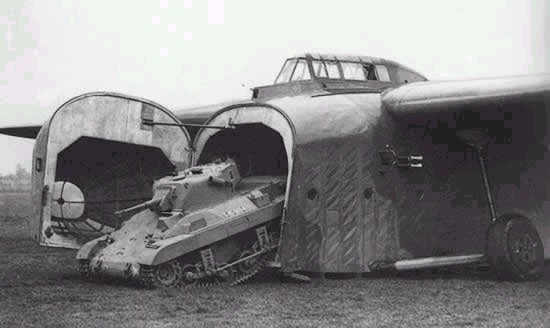
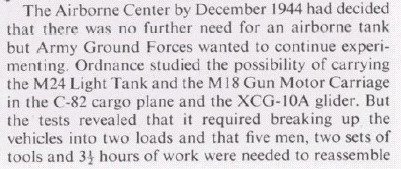
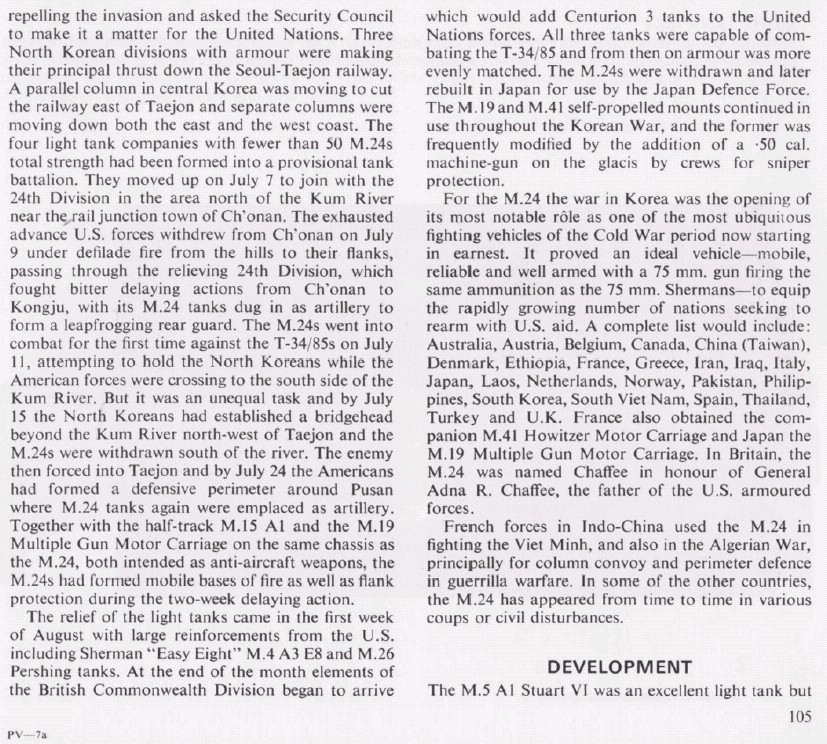
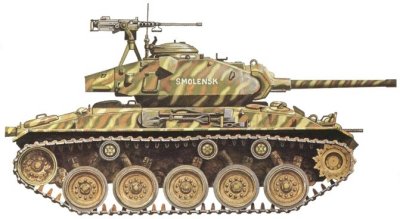
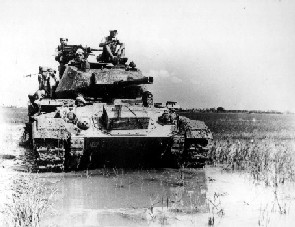
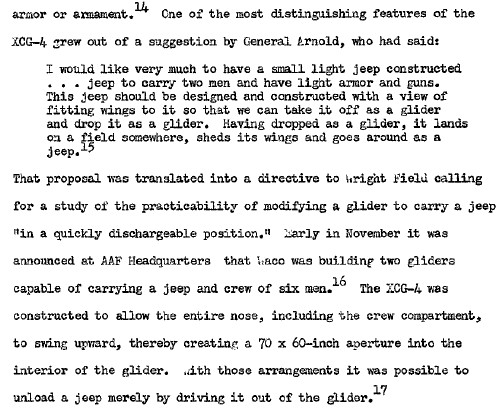

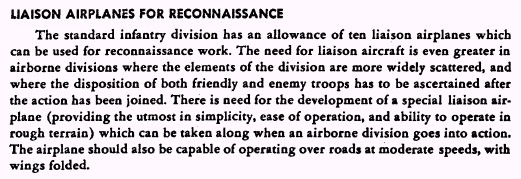
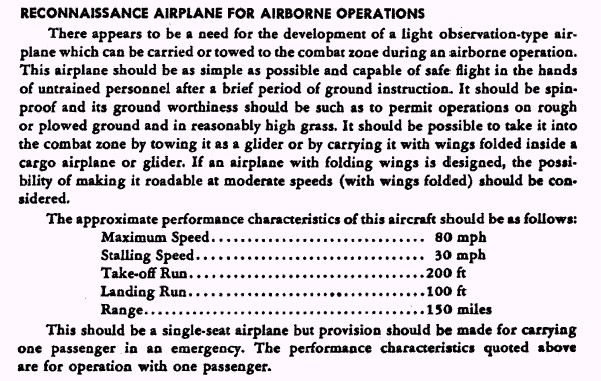
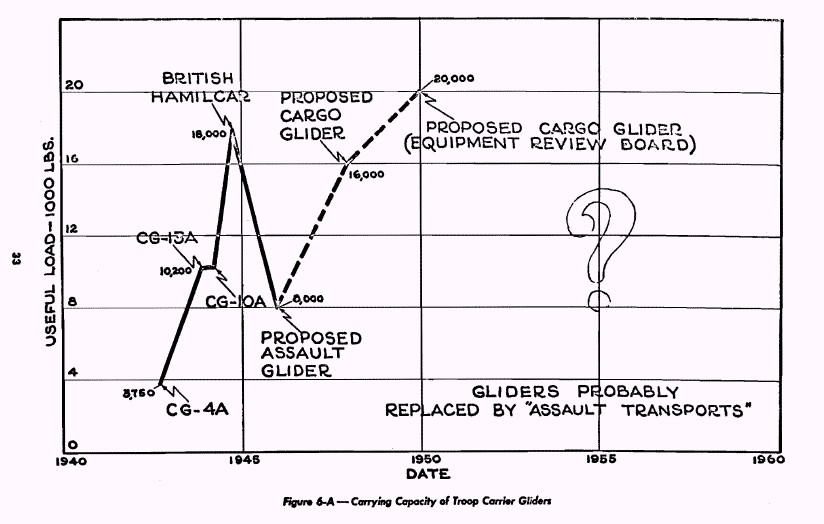
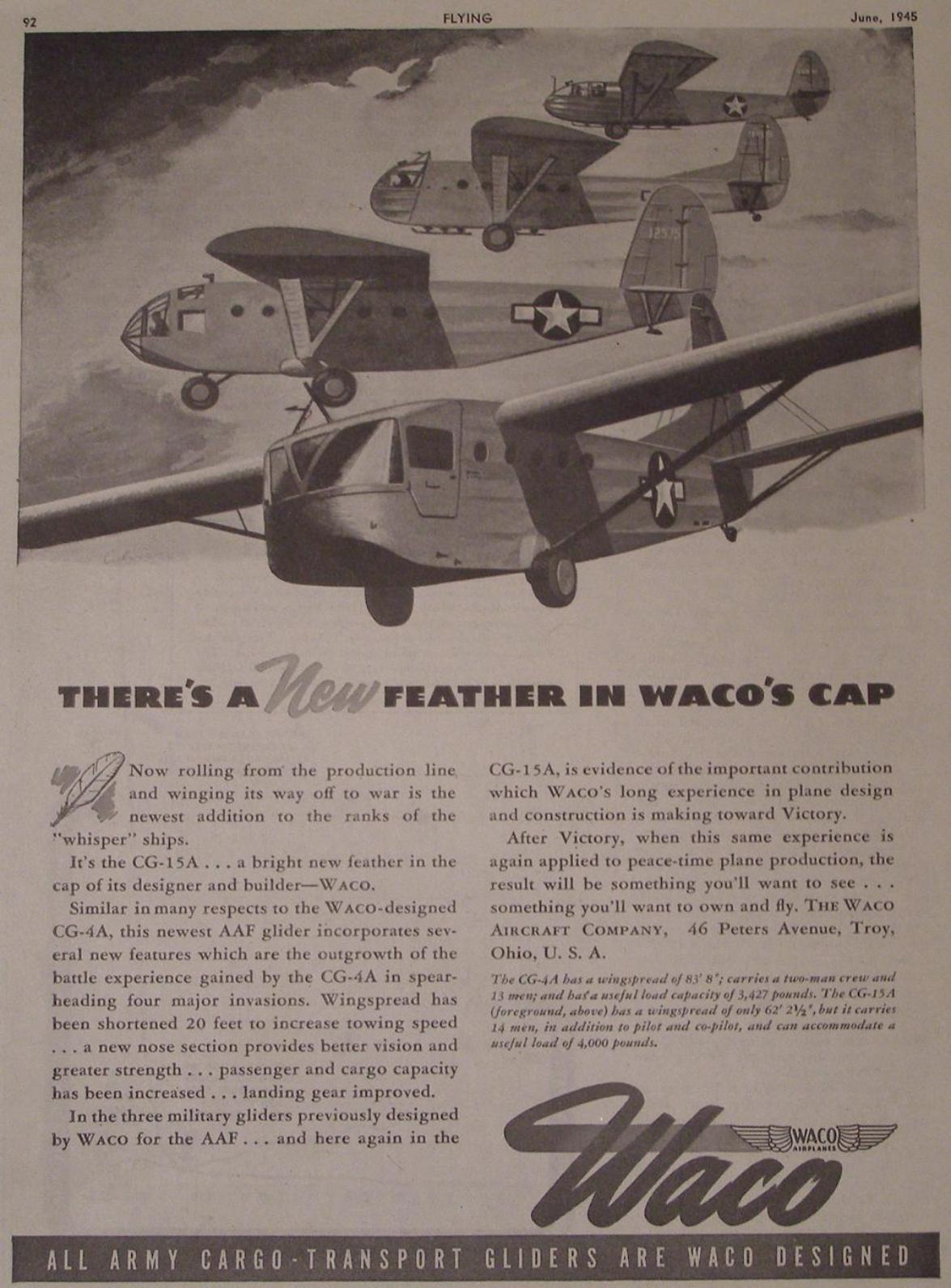
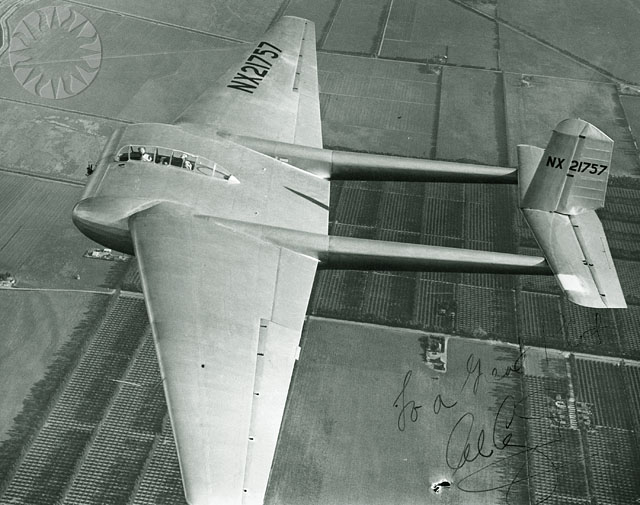
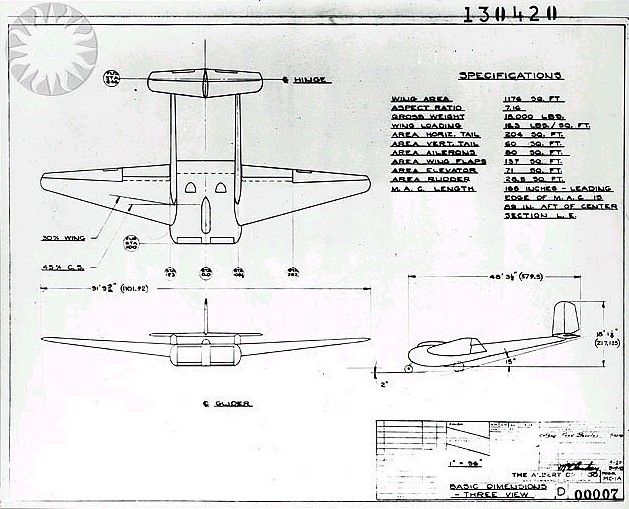
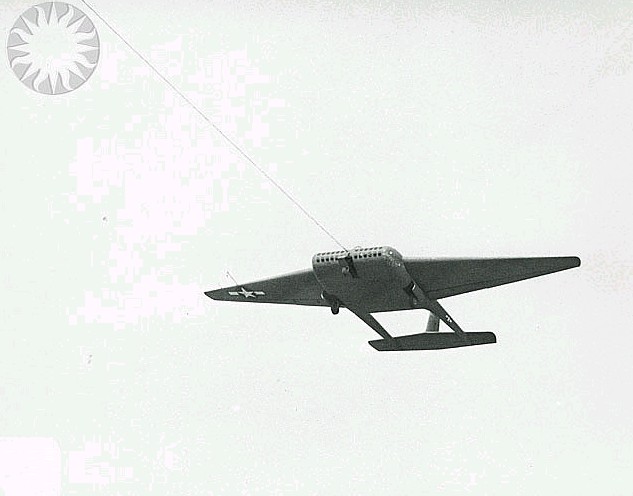
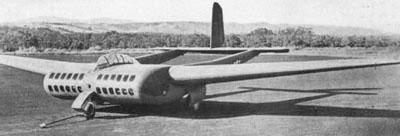
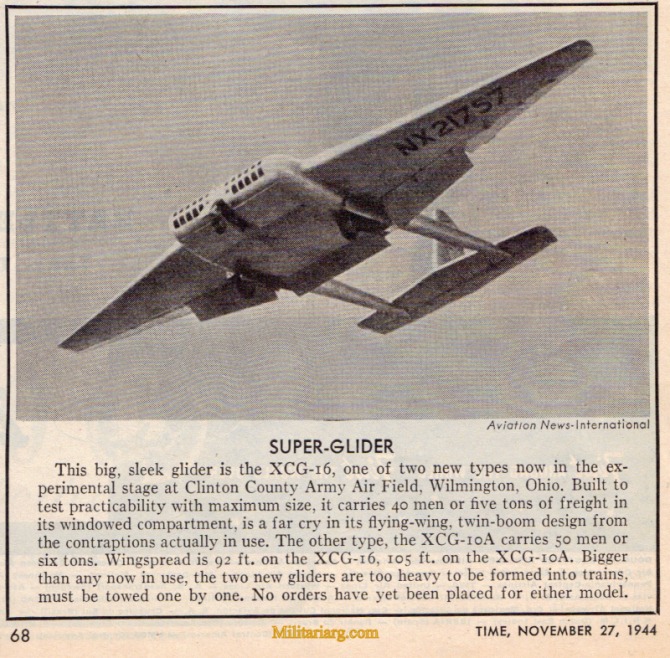
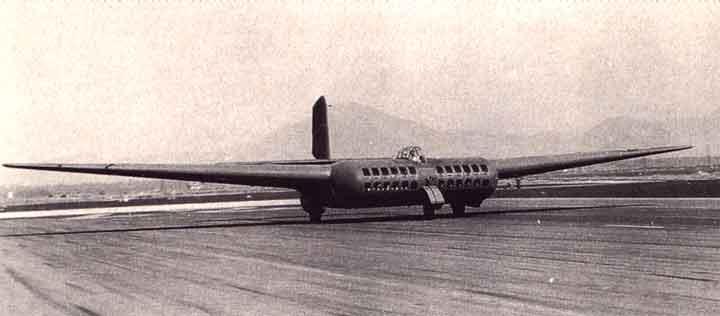
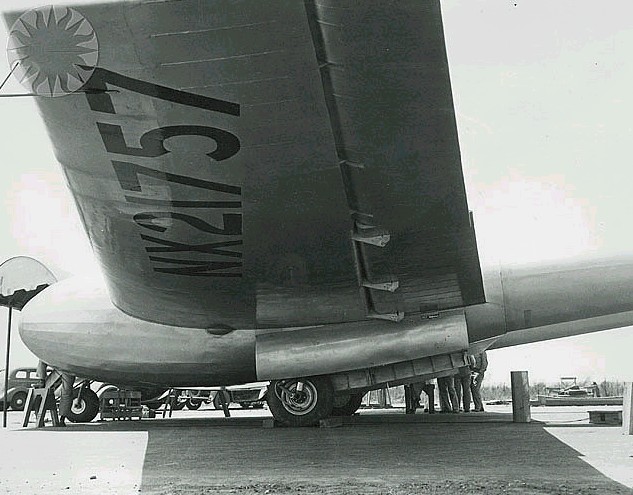
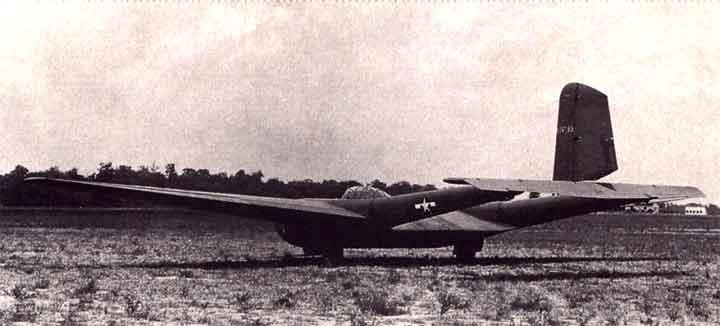
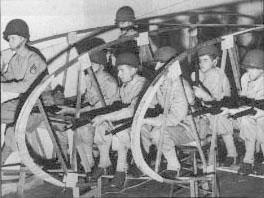
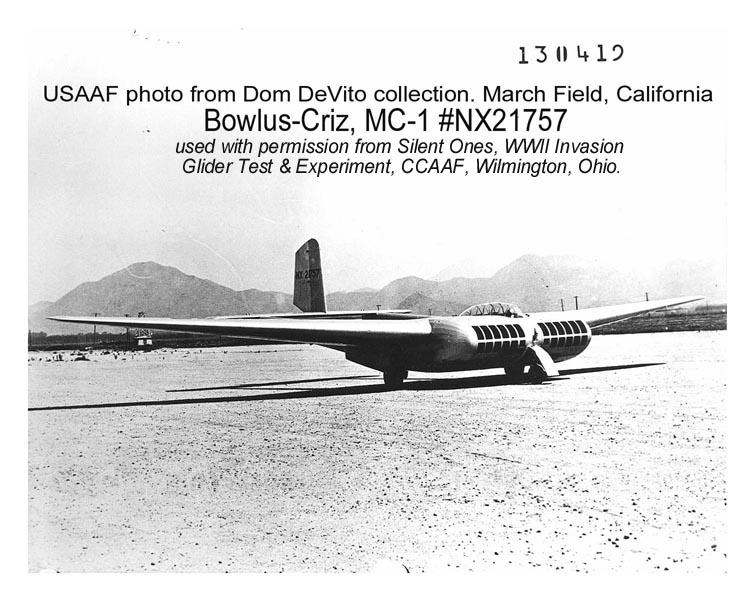
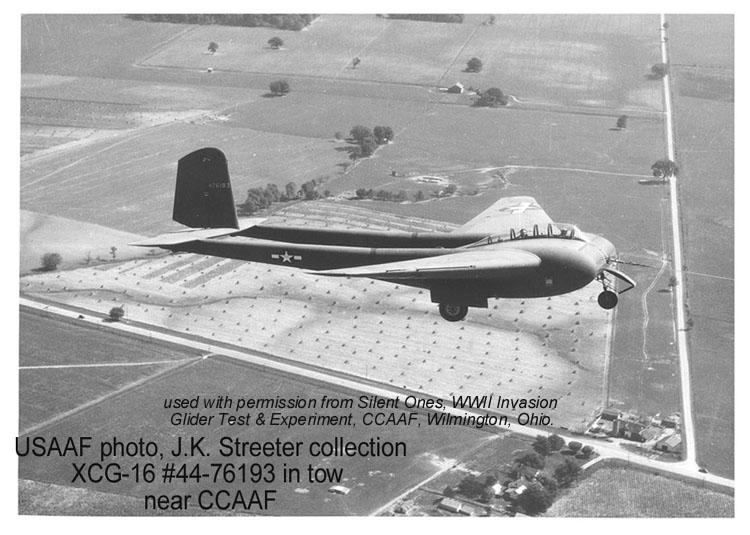
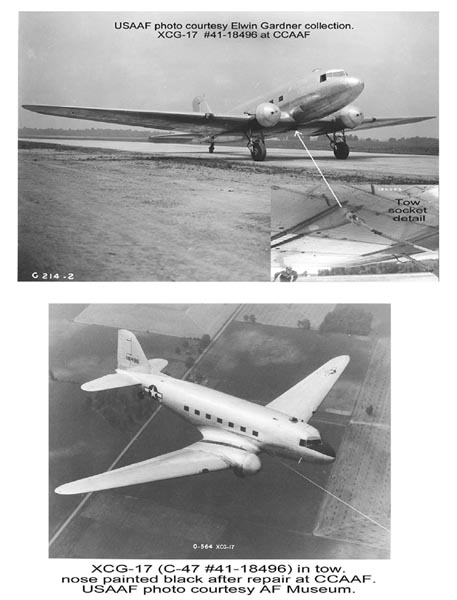
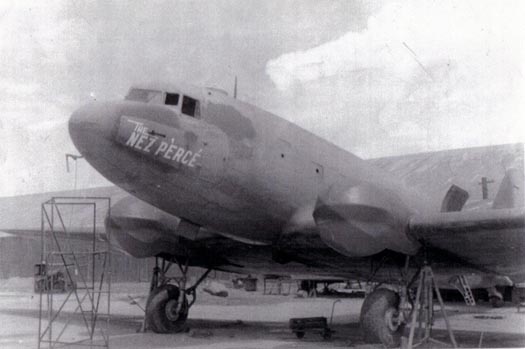
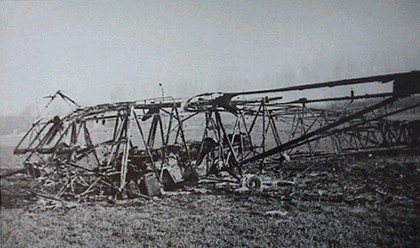
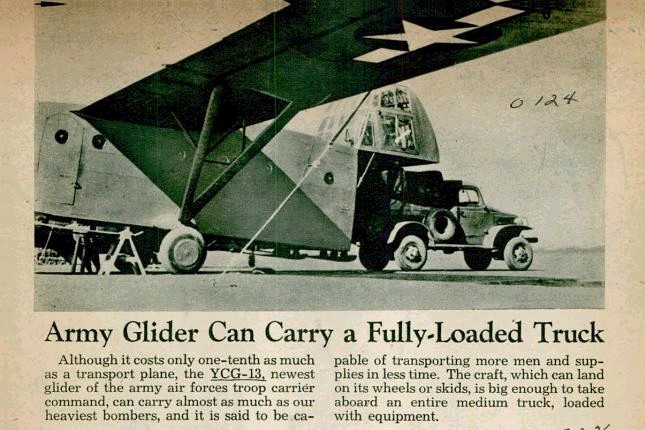
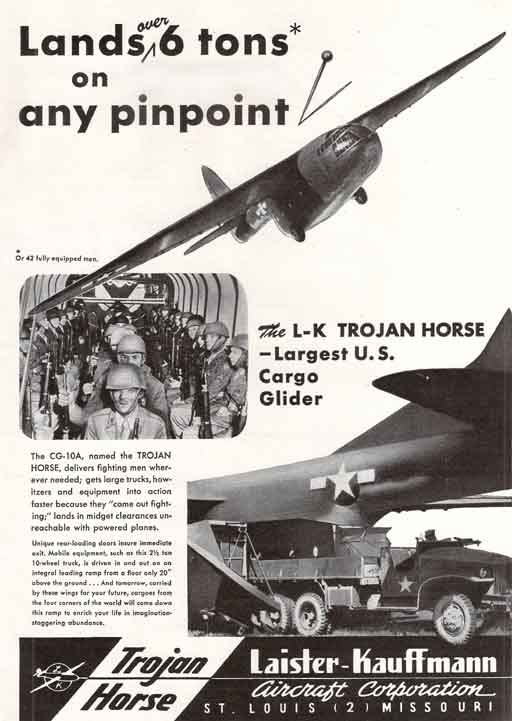
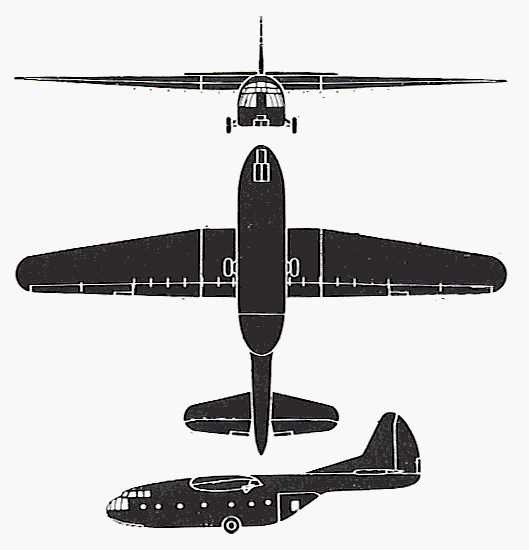
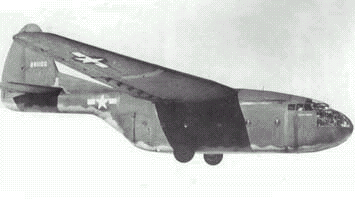
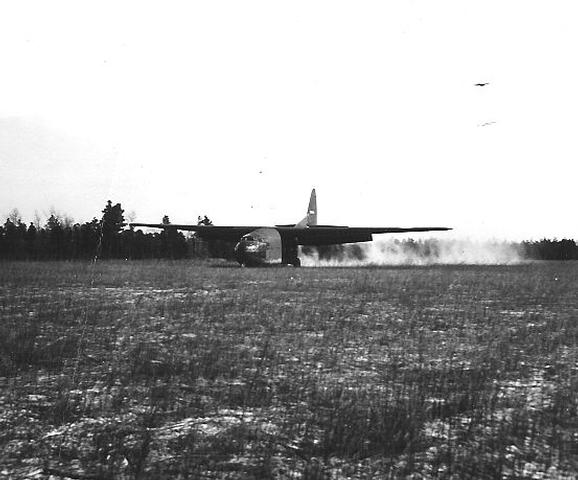
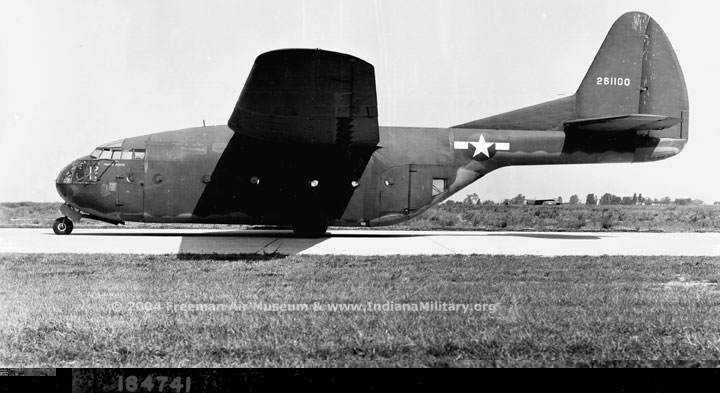
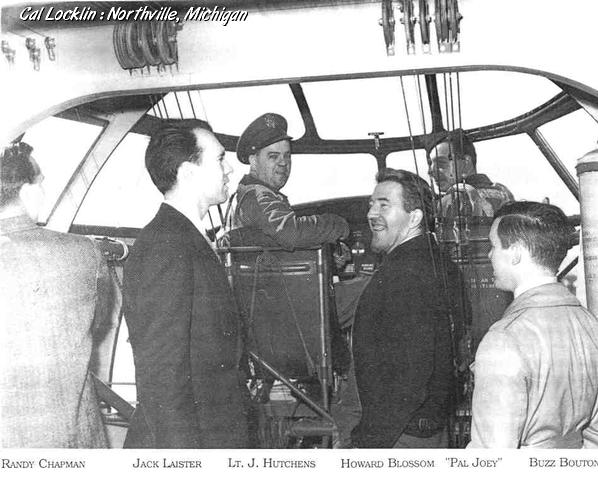
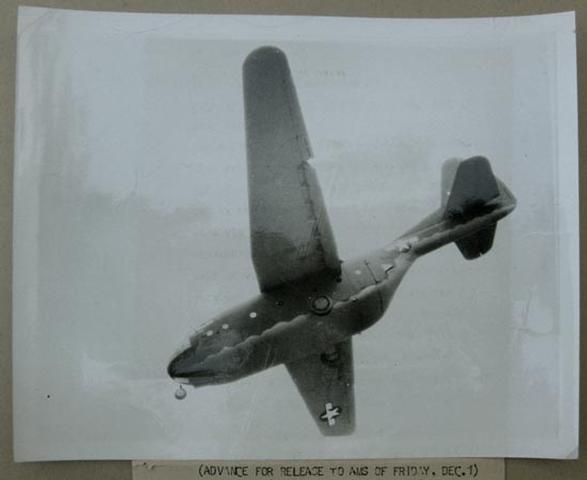
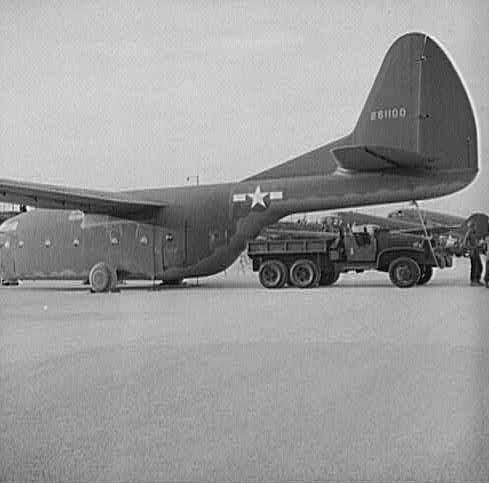
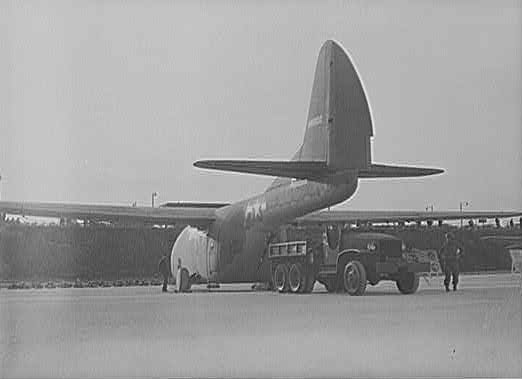
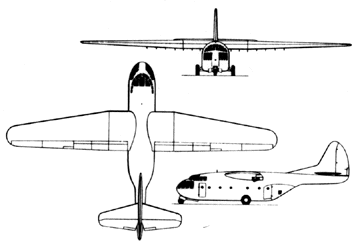
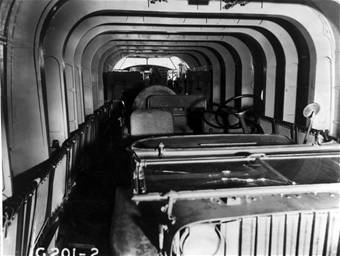
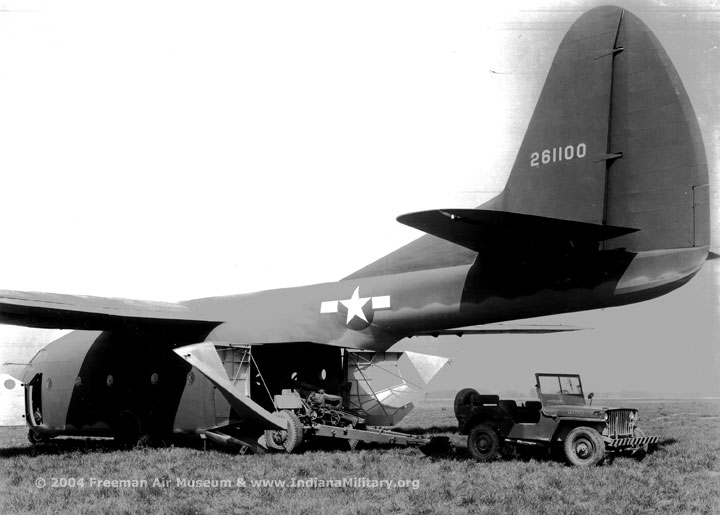
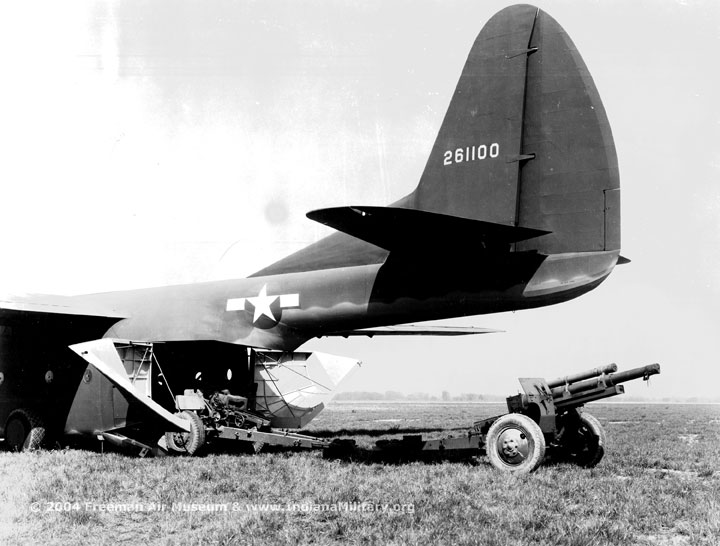
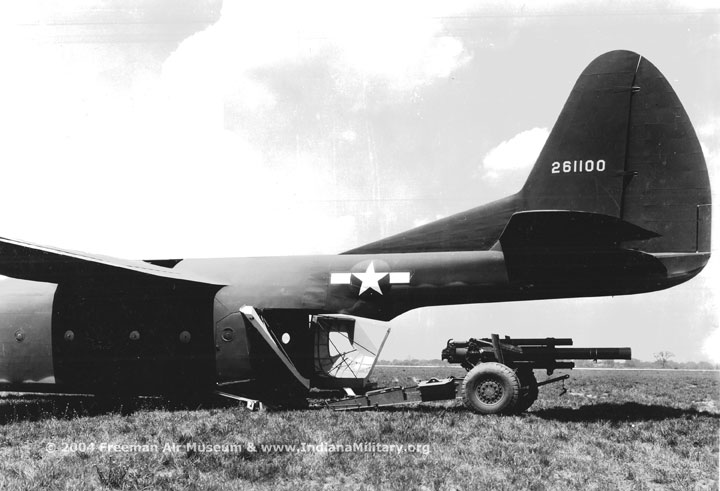
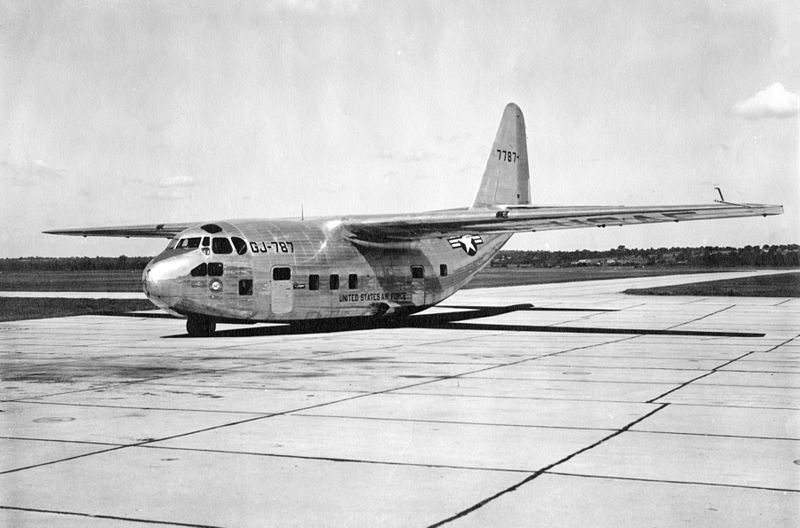
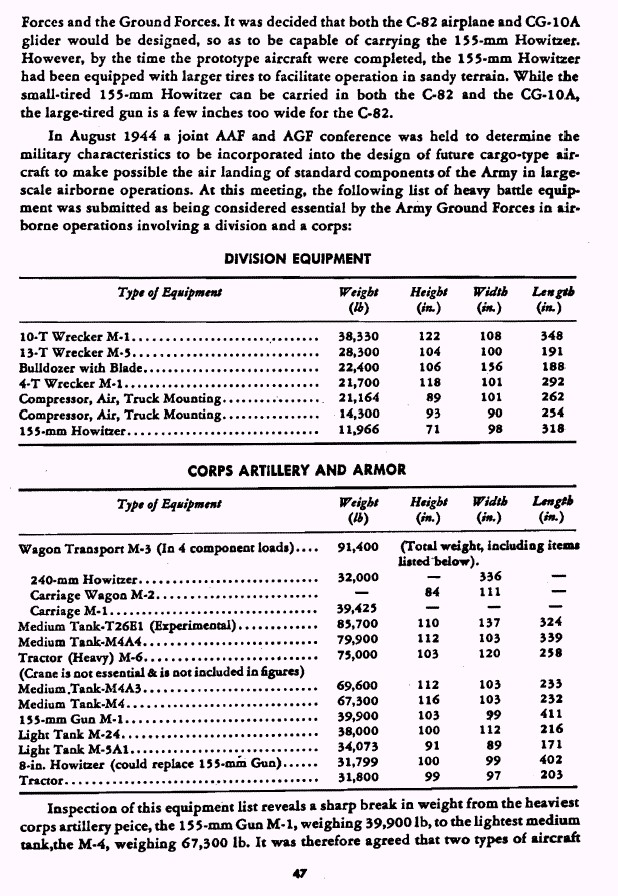
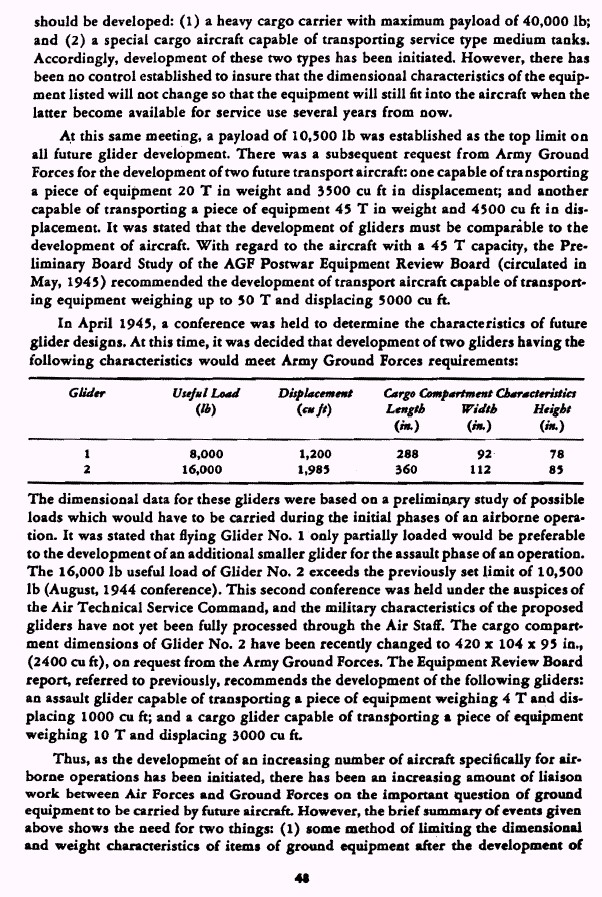
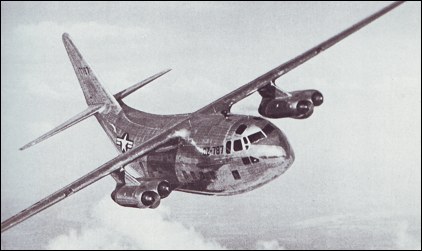
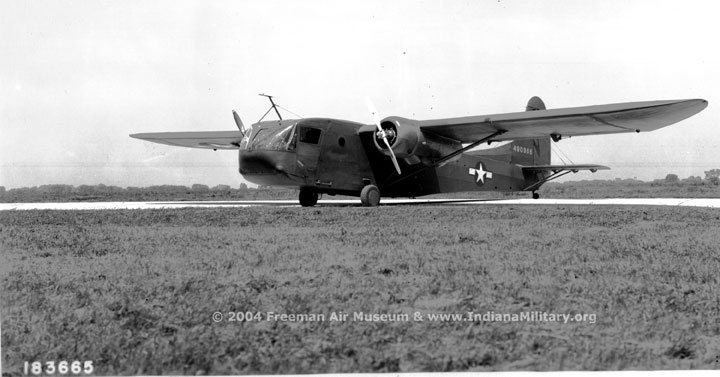
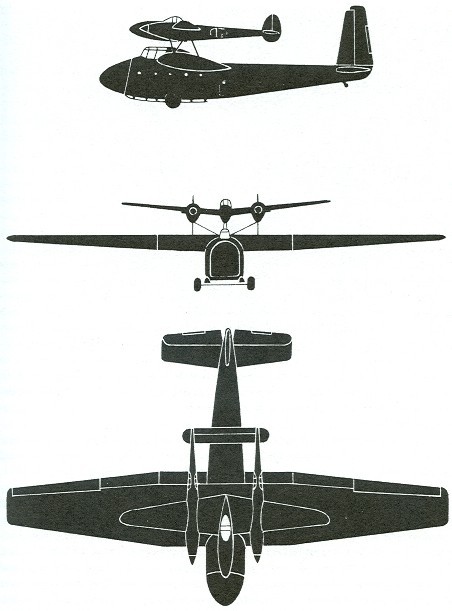
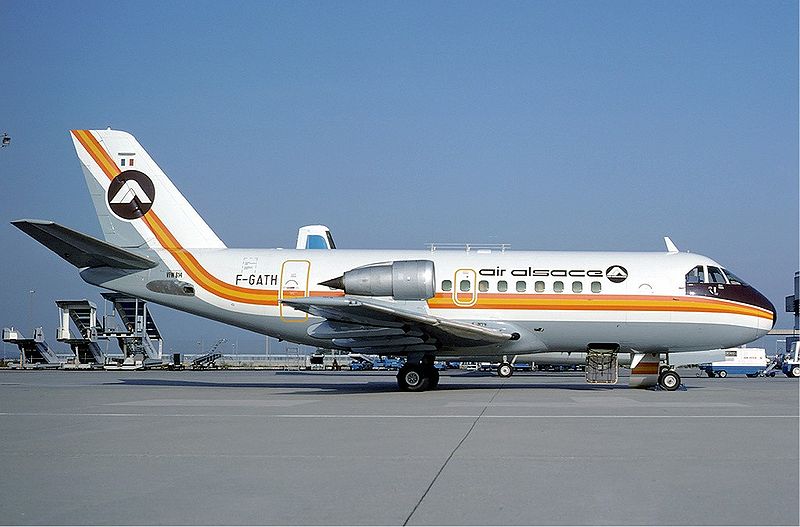
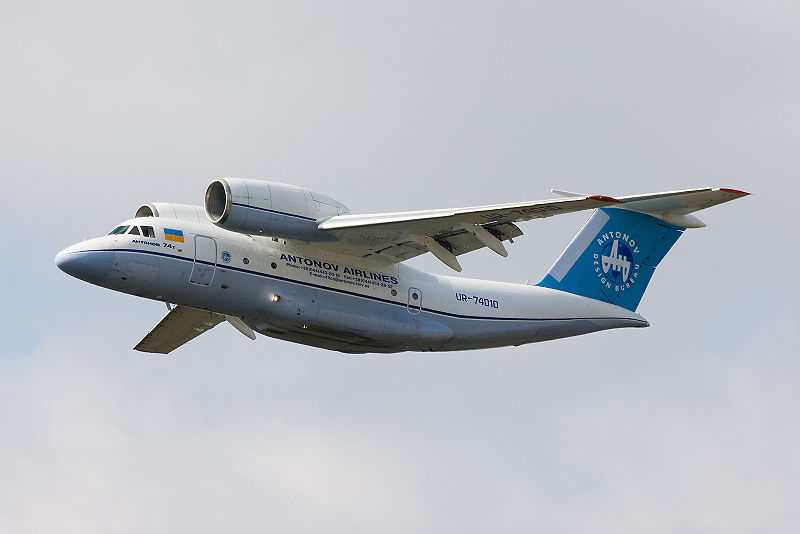
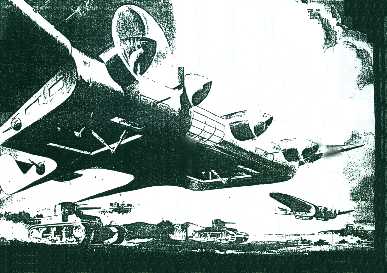
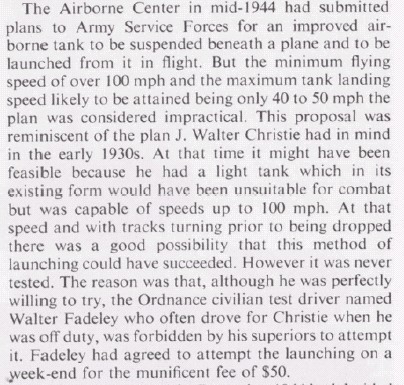

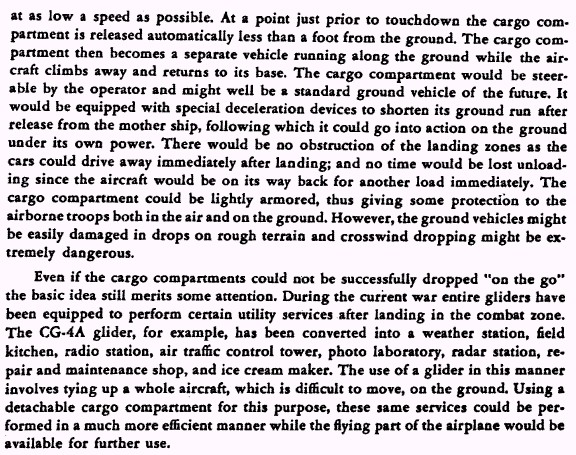
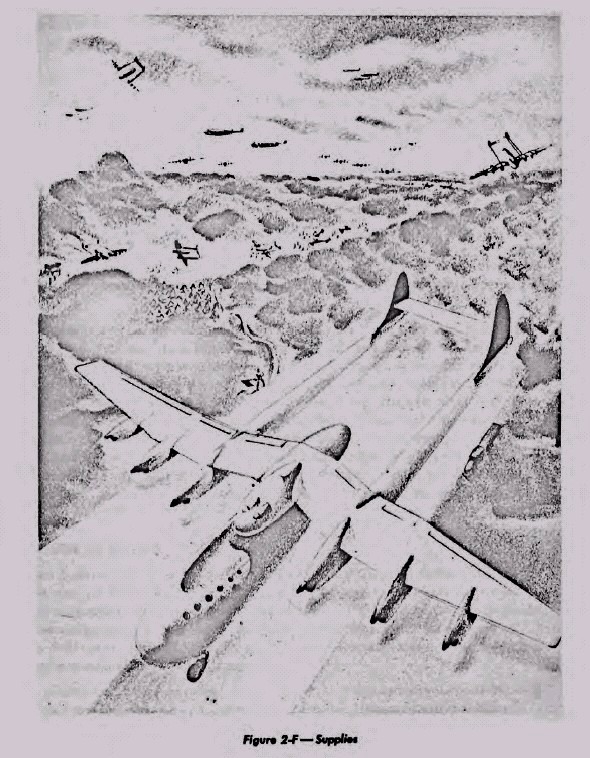
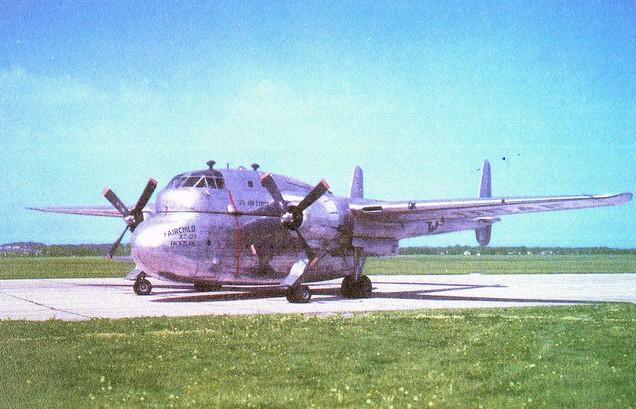
 www.youtube.com/watch?v=9gspWjduh3Q
www.youtube.com/watch?v=9gspWjduh3Q
A C-119 without a fuselage--the XC-120--could have carried a M24/M18 light tank underslung--the question is could it have taken off with say a larger wing and 4 engines or with turbojets in pods or turboprops? The C-119 and XC-120 had two x 3, 250 hp piston engines for a total thrust of 6, 500 hp and were capable of lifting 10 tons of cargo. Without the cargo pod weight or the C-119's built-in fuselage, the XC-120 as-is could lift another 1-2 tons if the payload were attached directly underneath.
Stanley H. Evans in his superb article "Cargo Carrier Concept: Design-logic for Airborne Logistics: The Fairchild XC-120 Pack-plane". Flight magazine 21 September 1950, pages 331-333 makes an excellent case for a Burnelli design pack plane with turboprops. He notes that the T40 contraprop engines (used in the later R3Y1 Tradewind seaplane transport) were planned for future XC-120 planes. We know now, this didn't materialize and that the T40s were mechanically unreliable--but the concept of contra-rotating props to get 2 engines in the space of one is SOUND and is proven every day in Russian Tu-95 Bear bombers that have been flying successfully for decades since the 1950s. Had reliable British Mamba contraprop engines used in the Fairey Gannet ASW carrier-based plane [http://en.wikipedia.org/wiki/Fairey_Gannet] been fitted to a XC-120, 4 x 3, 875 shp engines would have offered 15, 500 shp of thrust--this is over 2x the thrust of the 2-engined prototype. Almost 3 times the power. We will call this the "XC-120T". The XC-120T payload would have increased to over 25 tons to easily transport M24/M18 light tanks.
Comparison/Reality Check
The R3Y Tradewind [http://en.wikipedia.org/wiki/Convair_R3Y_Tradewind] had 4 x unreliable 5, 100 shp T40 contraprop engines for a total of 20, 400 shp thrust and could carry 48K payloads routinely. Empty weight was 72K and max take-off was 165K--so maximum payload potential was 93K--subtract a 48K M24/M18 light tank and one has 45K on crew, fuel etc. to work with. Plenty to work with.
Available USAF 1950-1960 Options to Fly Army Light Tanks
So the Army's tankers are "fat and happy" with their M24 Chaffees and M41 Walker Bulldog light tanks throughout the 1950s. They don't have to risk their necks flying in aircraft and parachute jumping. They haven't made themselves air-deployable. The USAF drastically improves its airlift capabilities by the turboprop C-130 Hercules STOL transport. Here is where things get very interesting....
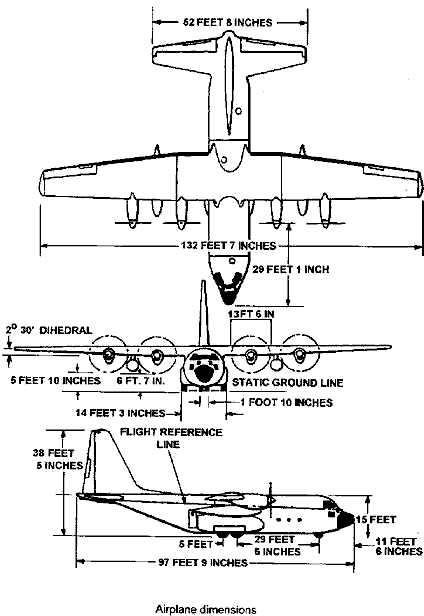
Will a M24 or a M18 fit into a C-130 fuselage?
The M24 is listed as 9.84 feet wide (118 inches) and 9 feet high (108 inches) high--too wide and too high by a small margin. The M18 is slightly smaller at 9.4 feet (113 inches) wide and at 8.4 feet (100 inches) high is significantly lower than the M24.
The USAF lists 104 inches as the maximum height for a load to tip-off the rear ramp during airdrop. The M18 Hellcat is good-to-go height-wise. Why couldn't the M24 be modified to lose a mere 14 inches of height by a kneeling suspension and smoothing the turret top?
The USAF lists 105 inches as the maximum C-130 floor width allowable---but this includes two sets of 463L pallet rollers representing a total of 18 inches. So the actual C-130 maximum floor width is 123.2 inches and this narrows to 119.5 inches at the wheel well center area; not a lot to work with when backing in a M24--but do-able. No problemo for the M18 Hellcat! Why couldn't lighter weight band tracks perhaps on narrower on narrower roadwheels been developed for a few more inches of aircraft wiggle room?
Or why didn't the USAF insure when they wrote the specifications on the C-130 that they insured a M24 light tank would fit and be air-transportable?
C-130 Cargo Dimensions
www.456fis.org/THE%20AC-130/c-130-cargodims.gif
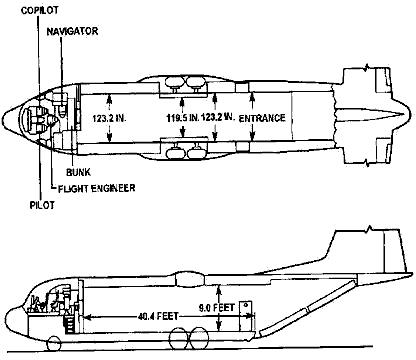
A problem area of the C-130 is its landing gear bulge half-way into the fuselage cargo floor--and half-out into the slipstream. If we had C-130s with their entire gear held in external bulges like the C-160 Transall this would free up the cabin floor for 123.2 inches of width from beginning to end and make it easy to load/unload as-is M24 Chaffee light tanks. In-flight refueling probes like the RAF C-130s have would enable a Herk with a M24 to take-off with a light fuel load and top-off for long-range missions.
http://en.wikipedia.org/wiki/Transall_C-160
Clearly, the answer is YES; the M18 Hellcat--which is the superior light tank in performance---and the M24 Chaffee with some work--could have fitted into a C-130 for the Army Airborne in the 1950s. Both could have been up-gunned to 90mm guns to stay ahead of the threat. So the fault here lies with Armor branch for not applying itself to help Airborne units by getting themselves to the fight by available aircraft and parachutes. One way to not have to become Airborne is to deliberately adopt a tank that cannot be airdropped with what was available.
Enter the M41 Walker Bulldog light tank in 1953
[http://en.wikipedia.org/wiki/M41_Walker_Bulldog] has an even better combat record than the M24; tested in Korean combat and later in use by the South Vietnamese Army, they successfully defeated Communist T-54/55 medium tanks in repeated combats with the same 76mm gun used by the M18 Hellcat--which begs the question of why wasn't the latter used all along after closing its turret top?. Surely, the M41 was a light tank the can't-ever-have-enough-armor-protection tankers would embrace...
However, the steel M41 was 23.5 tons and too wide at 126 inches to fly by C-130. It's almost as if Armor branch deliberately designed the M41 so it could not fly by widely available C-130s...But remember if we had adopted CG-20 gliders--we could have flown even M41s by them! Unless of course, Armor branch deliberately moved the vehicle's size goal posts again to wimp out from being air-transportable.
C-124 Globemaster II
http://en.wikipedia.org/wiki/Douglas_C-124_Globemaster_II
The biggest transport after the C-130 in USAF service was the C-124 Globemaster II, introduced in 1950 could carry and AIRLAND a M41 Walker Bull Dog light tank through its front loading nose door--but could not airdrop vehicles in flight. There were a few C-133s that had rear ramps to paradrop M41s--but this option wasn't pursued.
What About Using Light Tanks that Armor Branch Tankers Didn't Like?
So the Army Airborne adopts the 8-ton M56 Scorpion tracked self-propelled 90mm gun on an exposed mount--when the superior fully-enclosed 9-ton M50 Ontos with 6 x 106mm recoilless rifles was available and advocated by Airborne pioneer LTG James M. Gavin. The Ontos would kick serious ass in Vietnam with the not-too-bright marines--who would then retire then when they ran out of spare parts and couldn't figure out how to make newer variants using the widely available M113 Gavin chassis. The French 15-tons empty AMX-13 light tank (initially automatically-loaded version of 75mm used on German Panther medium tank, later replaced with 90mm and 105mm) was also available that is C-130 air-transportable, why didn't we buy some of them?
combatreform.org/airbornetanksnoexcuse.htm
Again, a suspicious subjectivity appears in play here.
Summary of the 1945-1964 Period of American Airborne Development
When the U.S. Army lost control of gliders to the USAF (?), an important opportunity to deliver light tanks by new heavy payload gliders was lost. Until 1953, the M24 Chaffee was the light of the U.S. Army--and even well-liked by the tankers. The CG-20 glider could have lifted the M24 had we thought of towing it with the most powerful plane we had with the assistance of rockets. Therefore from 1945 to 1958--before the advent of the C-130--the CG-20s could have--and should have air-delivered M24s (or better yet lighter M18s Super Hellcats with 90mm guns) to help the Army fight on the ground in Korea and be ready anywhere else in the world. True, in 1953, heavier M41 Walker Bulldog light tanks had replaced M24s, but to create an airdrop capability with the C-130, why not keep a battalion's worth of M24s--or better yet M18 Super Hellcats? They are already bought and paid for, and we are handing them to our allies for free. Why develop the exposed M56 Scorpion for parachute airdrop at all if you had CG-20 gliders or knew turboprop C-130s were coming with payloads and rear ramps that could crash-land or airdrop M24s or M18s so Paratroopers could have immediate fire support? Or did we get complacent and took the low road and felt compelled to seize a runway so M41s could be airlanded by C-124s so tankers wouldn't have to go on jump status?
While all of this was going on, the Russian Airborne VDV were parachute-dropping the open-topped, armored ASU-57 with the proven WW2 57mm AT gun--the same SPG concept that the British Alecto demonstrated years before. These weapons would provide critical firepower for VDV Paratroopers dropped behind enemy lines to blast anything in their path. The M24 and M18 were far more capable than the ASU-57--and we had the means to air-deliver them--and we didn't even try.
THE FAILURE OF HELICOPTERS FOR COUP DE MAIN
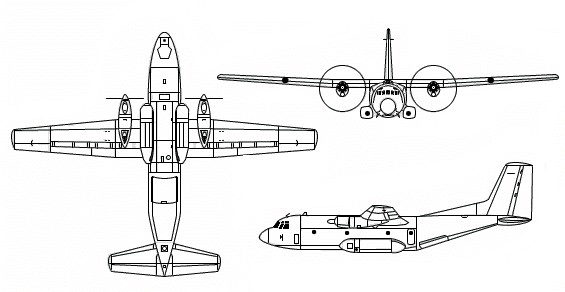
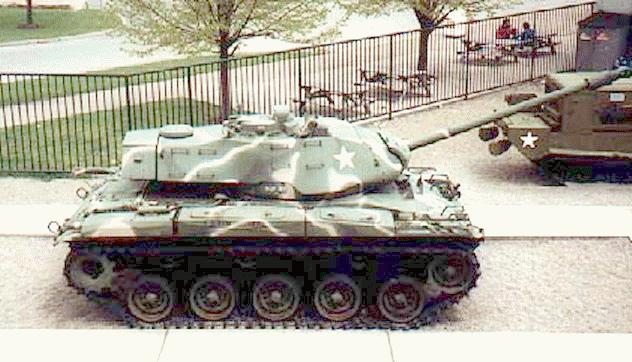
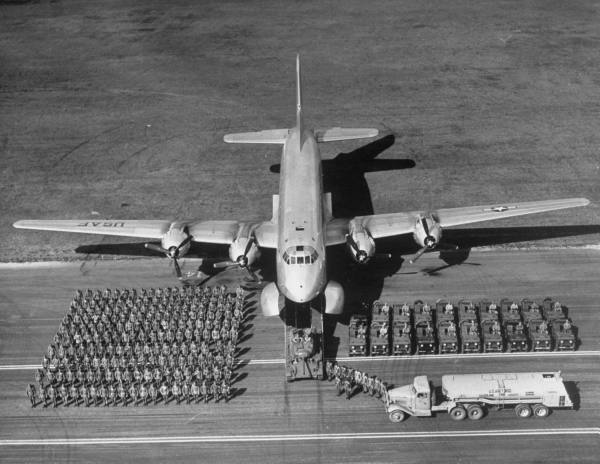
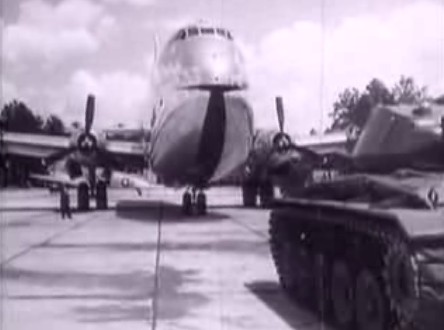
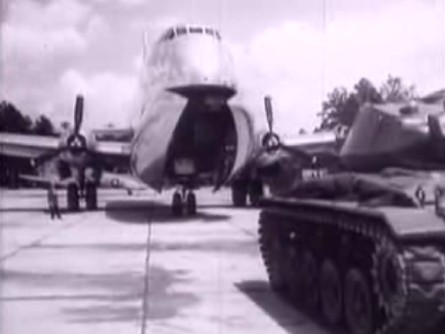
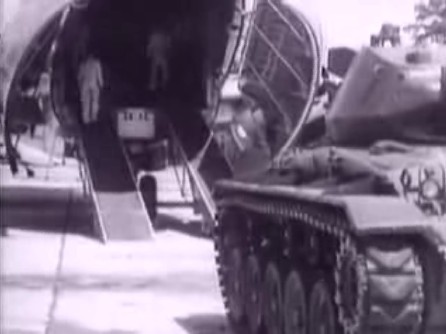
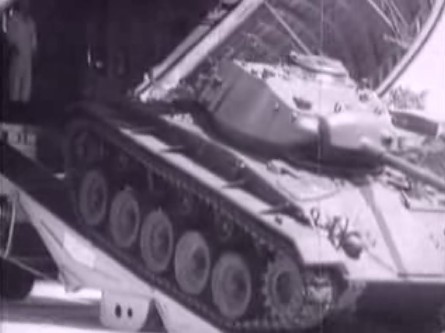
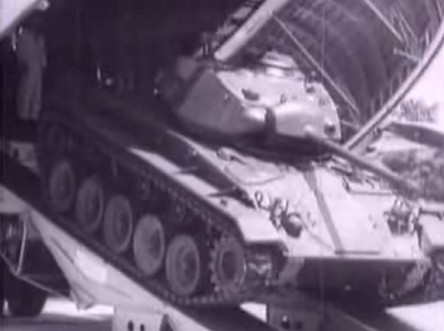
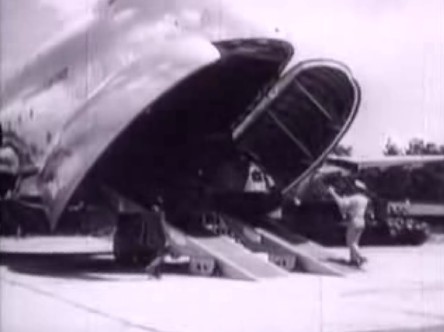

Helicopters are noisy, slow, use a lot of fuel and do not have long range. And this includes the ballyhooed V-22 Osprey tilt-rotor helicopter cum airplane. The Son Tay raiders crashed their primary assault team helicopter into a North Vietnamese POW camp rather than even try to fly out. Thus the 101st Air-Assault Division likes to fly in her helicopters carried on-board USAF jet transports that land on runways or assault-zones seized by the 82nd Airborne Paratroopers jumping in with parachutes. As this force maneuvers to defeat the enemy, helicopters are used to deliver troops directly onto assault objectives like gliders used to be used. The problem is helicopters are not stealthy like gliders, thus, the enemy is waiting and the helicopters often get clobbered. In 1975, marines were creamed by heavy machine guns and RPGs on Koh Tang Island. Helicopters got shot down assaulting positions on Grenada, the marines lost 2 Cobras and several transport helicopters to enemy ground fire from hardly a "high intensity" conflict, the MH-6 "Little Bird" helicopter that rescued Kurt Muse from the roof top of Modelo prison in Panama in 1989 was shot down, and two helicopters were shot down in Somalia that created the desperate situation on October 3, 1993. The use of helicopters for direct assault on the increasingly urbanized battlefield is questionable. There has to be a better way.
At least for high risk, high priority missions where absolute stealth is required. Its time for a return of the glider. This time without towing.
FIXED-WING HIGH-TECH GLIDERS
 www.youtube.com/watch?v=GlN9oFX6YKY
www.youtube.com/watch?v=GlN9oFX6YKY
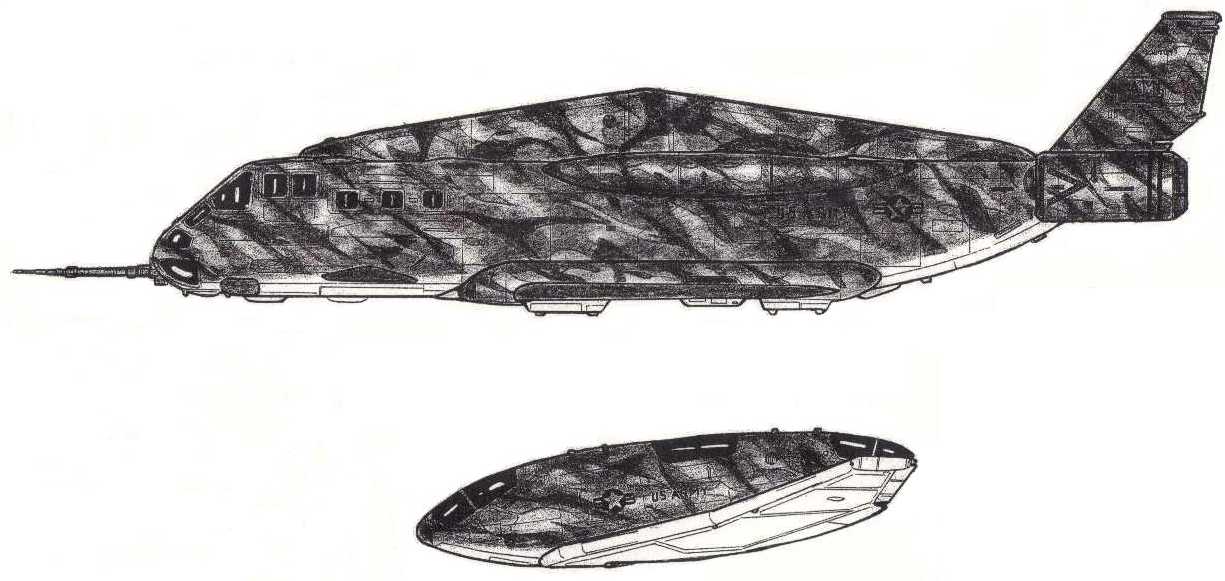
TECHNOTHRILLER: The Trouble in Treblestan
What we need is a fixed-wing glider that will hold a M113A4 Super Gavin light tank, and a squad of commandos made entirely of non-metallic material that will be carried sticking out the aft end of a C-130. The wings of the glider would be in the airflow. The men would sit inside the C-130 until time to get inside the glider and be launched. The closest analogy is the way Chuck Yaeger was launched from B-29 Bomber in a X-1 Rocket plane, which can be seen in the Book and movie, The Right Stuff. Instead of being in the belly/bomb bay, the stealth glider would be half in and half out of the C-130. The C-130 with its long range and speed would be able to carry the glider and its men to the insertion area. The men would get inside and the glider would be launched from a stand off range away from enemy detection. The glider would than glide silently into its landing points using state of the art navigation aids and forward looking infrared (FLIR). The stealth glider would be a unique shape with high lift capabilities like Burt Rutan's Scaled Compositesdesigns are like. Just before landing the slealth glider would have its wings pivot and flaps dropped to assist its barbed skids in landing within 20 feet. This was possible with World War II gliders and should not be that difficult to achieve today. The stealth glider should be able to land on a rooftop with precision accuracy----from there the commandos would jump out and assualt their objectives. Enemy would be caught by surprise with no warning. These gliders would be piloted by enlisted Paratroopers.
C-17 SkyCranes to Drop "Kiwi" Pods--and Gliders

ROTARY-WING GLIDERS
 www.youtube.com/watch?v=58ADcUthPdo
www.youtube.com/watch?v=58ADcUthPdo
The long overlooked "glider" is the rotary wing AUTO-GYRO. Auto-Gyros are THE safest aircraft ever made. But they cannot hover--if they go slower than 15 mph they descend to the ground, slowly. They can take off and land VERTICALLY and are far simpler than the complicated helicopter which powers its rotors to fly all the time. in contrast, the Auto-gyro which predates the helicopter by a decade, is a ROTARY WING GLIDER, its rotors are NOT POWERED. As the Autogyro moves forward by a propeller of a jet engine, its rotors turn on their own to create lift, hence you have to keep going faster than 15 mph, which is not a problem. You can before reaching the target area, turn off your engines and SILENTLY come to a landing. Unlike gliders, if you want to abort the landing, you can turn the engines back on and fly away.
KIWI GLIDER PODS: GAVIN'S VISION
If we are smart, we will design the replacement for the CH-47D/F Chinook, the Future Transport Rotorcraft (FTR) would be equipped with detachable mission pods or "KIWI" pods like LTG James Gavin wrote about in his masterpiece Airborne Warfare in 1947. A special glider pod would detach in-flight and fly Paratroopers silently to assault objectives.
GETTING OUT: RECOVERY OF GLIDERS SOLVED
If we are using rotary-wing Autogyros, they can jump take-off themselves and fly themselves back to base.
If the objective is secure then helicopters could fly in and sling-load or re-attach KIWI pod gliders and fly the fixed-wing gliders back to their operating base. If the gliders are in a rural area, they could be fitted with a turbofan engine that would allow them to regain flight with takeoff JATO rockets and fly back to base. The gliders should also be lightweight and easy to disassemble for covert delivery to different parts of the world where needed.
The stealth glider is a low-cost weapon that can be developed to work with existing equipment that would be a great assest to special missions units and lead units of the XVIII Airborne Corps and USSSOCOM. "Out of the box" thinkers like Burt Rutan could pull this off on a "shoe string".
AIR-DELIVERED LOGISTICS BY GLIDERS
The down-side of parachute air-delivery is the cost involded in parachutes/air items if they cannot be recovered. A glider is in essences a sort of "Air-Trailer" like a ground trailer which uses its momentum to move cargo by rolling instead of carrying. The Air-trailer (glider) is a way to capitalize on the forward momentum already there of an aircraft to tow along a payload. Its long been known the the USAF needs more strategic airlift. A few years ago an article in U.S. Army Armor magazine called for a new glider to tow 70-ton M1 heavy tanks to the battlefield to solve our strategic lift problems. Kevlar type fibers would make tow ropes more reliable than in the past.
 www.youtube.com/watch?v=jRLFTyHv-_k
www.youtube.com/watch?v=jRLFTyHv-_k
What I suggest to make the "Air-trailer" heavy glider work better would be not having a pilot onboard; use self-guidance to a GPS coordinate as now used in guided ram-air parachutes with a back-up remotely piloted capability via data link to an enlisted pilot inside the tow aircraft. The goal should be a capacity to carry a 70-ton M1 tank or 2 x M2/3 Bradleys or 4 x M113A3 Gavins.
The crews of these vehicles would parachute from inside the tow aircraft at a nearby Personnel drop zone for link-up later on the ground with their gliders. The Heavy gliders recovered by helicopter "snatch" then towed remote-control flying later.
These gliders have the capability to double the USAF cargo airlift capacity overnight and pose no threat to future purchases of transport aircraft since they are no good without something to tow them into the air.
FEEDBACK!
A military futurist from Great Britain writes:
"A bit of additional information that may be of interest for the glider page.
In 1940, Willy Messerschmit proposed that all tanks be fitted with brackets so they could have glider wings added on. The tracks would be covered by a sort of sled, and the idea was to tow the tanks over to England and let them land there. Don't know if it was intended for the crew to ride in the tank."
REFERENCES
1. www.airpower.maxwell.af.mil/airchronicles/cc/torrisi.html
Gliders: Rethinking the Utility of these Silent Wings for the Next Millennium
17 November 1999, Air & Space Power Chronicles by Steven A. Torrisi
Introduction
Current options for forced-entry operations need a tune up as the tempo and diversity of threats to United States security interests shift from a bi-polar to multi-polar world. Parachute drops and air-assaults by helicopter endure as the only mechanisms for the airborne insertion of troops and equipment. Units equipped as such require an alternative capability to drive or expand doctrine as traditional airborne roles mesh with non-traditional missions and rapid reaction forces continue to constitute the vanguard of crisis management. The answer necessitates fielding a conceptual aviation design that integrates a genuine stealth capability; a simple, yet sophisticated fuselage economical to manufacture; payload dimensions capable of deploying tactical formations; and, a combat radius enabling it to strike over extended distances and terrain barriers. Such an aviation design integral to airborne forces once existed in the inventory of the U.S. Army; the glider. Combat-proven in diverse wartime missions accents the credentials of these silent wings and makes it an attractive candidate for contemporary procurement and deployment. It is the intention of this article to ponder the benefits and potential obstacles to reinstating a glider capability which in turn may stimulate a renaissance of learning with regard to this neglected mode of flight.
Military Background
Born out of myth as an outlet for genuine scientific investigation into the feasibility of human flight, gliding or soaring, as it is commonly known, emerged at the turn of the century as a pastime and competitive sport
for the aviation enthusiast, domestic and international.1 Overnight the trademark of this endeavor, the glider, evolved from a cottage industry to an entrepreneurial venture as manufacturing plants sprang up to fill orders as improved designs came on the market. The outbreak of the First World War stifled glider development though as production lines shifted to a wartime economy and the military demanded propeller-driven aircraft for front-line service. Consequently, interest in soaring waned as newspapers chronicled the heroics of aerial combat over the Western Front. After the war, many industrialists from the allied powers poured funds and expertise into the development of a competitive aviation industry dedicated to powered flight; a move that did little to restore the glider's pre-war reputation as research and development (R & D) focused instead on building high-performance aircraft. On the other hand, a defeated Germany; the cradle of modern glider development; used the art of soaring as the perfect subterfuge to circumvent the Treaty of Versailles.2 Since treaty restrictions did not prohibit the operational use of gliders, the truncated Reichswehr under the leadership of General Hans von Seeckt sought to improve aeronautical technology and skill resources vis-a-vis subsidized R & D and civilian training programs; the goal: a cadre of pilots for a future air force.3 Inadvertently, the Allied Control Commission furthered this subterfuge when they relaxed the most stringent treaty constraints in 1923, on aircraft manufacturing in a move to stimulate industrial recovery; soon mass quantities of affordable gliders of high-quality design and construction were coming off the assembly lines.
The thought, however, of staging a vertical envelopment by means of glider traces its origins to the Treaty of Rapollo negotiated by Von Seeckt and Nikolai Lenin in 1921; this clandestine agreement among other things permitted technical exchanges between the German and Russian general staffs. Of those Reichswehr officers to benefit from this provision was an avid gliding instructor, Colonel Kurt Student. Having unprecedented access to Soviet military maneuvers during the early 1930s Student observed Russian advances in parachute operations were offset by the fact that the technology for delivering heavy weapons to the battlefield was non-existent. Natural fabrics such as silk, simply could not handle the load bearing capacity under extreme stress and fatigue causing the parachute to fail; tougher synthetics like nylon and rayon were still some years off. In his final tour of duty report, Student recommended the general staff take advantage of this deficiency by employing gliders as a cargo and troop transport, a proposal answered with a reply of skepticism and ridicule. Not until the advent of National Socialism could Student, now a major general and Inspector of Airborne Forces, turn his vision of a "heavy drop" into reality. Working with other proponents at the Darmstadt Airborne Experimental Center, akin to the Lockheed Skunk Works, Student co-wrote the milspecs for the first dual-purpose combat glider: the DFS-230.4
The very tactics and techniques arrived at by this early investment in glider development paid handsome dividends later on, in furthering the concept and conduct of the "blitzkrieg". As the sensational assault and capture of the supposedly impregnable Belgian fortress of Eban Emael by commandos landed by glider made headlines in 1940, the British enthusiastically reacted to
the pivotal role it played in this conquest by forming the Glider Pilot Regiment. The U.S. War Department, on the other hand, was quick to file intelligence dispatches from its attachťs stationed in occupied Europe mentioning the glider's importance as a combat weapon. Only after America entered the Second World War did the Army cease neglecting the potential of these motor-less aircraft for use in its newly organized airborne divisions
that went on to see combat in Europe and the Pacific.
After the war, demobilization eradicated most U.S. and British Army glider regiments.5 Four years later in April 1949, a relatively obscure milestone took place on the training ranges near Fort Bragg, North Carolina. Operation Tarheel, a month-long tactical exercise marked the final operational use of gliders by the 325th Glider Infantry: the last such regiment retained on active duty. Before the year was out, the Parachute School at Fort Benning, Georgia cycled its trainees through the last glider familiarization course. On January 1, 1953, the U.S. Army deleted glider landings from the capabilities of its airborne units as multipurpose transport helicopters, aircraft, and heavy cargo parachutes began to enter service. Army Regulation 670-5 issued on September 20, 1956, which authorized a glider superimposed over a parachute to serve as the formal airborne insignia, lives on today as the only indelible reminder of its former existence and contribution.6
Why Gliders? Why Now?
When you think of it, the art of war briefly comes down to a simple philosophy: success = my time + my place + my way. With dominance in all three parts victory is certain, two parts and one has a more than likely chance of success, and, with only one, defeat. The key to dominance is to create an un-level playing ground to your advantage by introducing new doctrine or equipment, or both before your opponent. However we in the United States tend to equate new to mean complex, high-tech, and expensive, a kind of establishment mentality brought on by an abundance of wealth in natural and intellectual resources that has become the opiate of today's military. Such thinking can cut both ways though, especially if a potential enemy ever recognizes first the utility of a piece of simple equipment discredited by the mainstream as obsolete or of little contemporary military value. The reason behind this is clear: an enemy cut-off or limited in access to wealth and technology cannot afford to be finicky when their national survival is at stake and so must have any type of edge to create that imbalance. If that gamble pays off on the battlefield, the mainstream must then rethink its position until it establishes qualitative and quantitative superiority. Once the threat is gone, said equipment remains in service long enough for another innovation to come along, then the military discards it and the idea remains dormant until it finds favor again and the cycle repeats. This is the history of the military glider in a microcosm and the starting point to determine if the Army should rethink the utility of these silent wings for the next millennium
The U.S. Army, like the Reichswehr was, is in a period of transition where the future is uncertain as to how it should wisely invest limited resources to fight the next war. The late Secretary of Defense Les Aspin made
reference to this fact in 1993: "...the dangers of the new era will reinforce the importance of the Army. It will redefine the Army’s missions. And it will require us to reshape the Army so it can respond to those new missions."7 In this decade alone, Army deployments have totaled 33 compared to 10 from 1950 to 1989; the vast majority serving in regions and roles suited towards airborne, air-assault, ranger, and light infantry rather than armored and mechanized operations.8 However, maintenance and fuel costs for shrinking fleets of transport aircraft and helicopters, the
raison d’etre of these elite forces, are expensive and deployments
occasionally time consuming with several simultaneous operations already underway worldwide. Bearing this in mind, it is only logical that the capabilities of the XVIIIth Airborne Corps receive an alternative enhancement since the major combat elements under its command maintain the highest state of alert to meet their assigned operational objective; power projection.
Just as important, to win an active degree of interest by the mainstream and subsequent funding gliders must mirror one or all of the characteristics that are most in demand for equipment suitable for rapid reaction operations in this period of downsizing and reduced budgetary allocations: tactical advantage, multipurpose, simple, cost-effective, a timely initial operational capability
(IOC), and available for procurement by all four services. Traits as these expedites the acquisition process and are factors that weigh heavily on the minds of administrators (and legislators) alike when it comes time to vote on allocations of monies. Thus, procuring gliders makes military and economic sense for several reasons.
1. Gliders and glider landings dovetail the individual capabilities in airborne (parachute) and air-assault (helicopter) operations while minimizing the associated hazards. While parachute drops embody an atmosphere of surprise and stealth (to a degree), the trade-offs are vulnerability (as airlift assets and descending paratroopers — after a static-line jump from 1,200
feet, are in "double jeopardy" from air defense artillery (ADA)); tactical disorganization (as formations disperse over the drop zone (DZ)); and, firepower (lightly armed, paratroopers are defensively weak). Alternatively, air-assaults integrate tactical organization, precision landings, mobility, heavy payloads, and firepower, while trading-off stealth and surprise (as engines and rotorblades disclose the axis of attack) for vulnerability (to an ambush as troops withdraw or dismount from the pickup or landing zone (LZ). Comparatively speaking, gliders and glider landings prove superior to either
style thanks to several inherent traits.
Stealth and Surprise
Recognized as moments where the greatest weakness of the attacker and of the defender occur simultaneously, the outcome of a vertical envelopment depends on initiative and determination. In a non-permissive environment when an unarmed cargo plane or helicopter approaches and departs from an DZ or LZ is the point at which pilots face the greatest danger of being shot down. Ejecting flares to confuse and divert incoming heat-seeking surface-to-air-missiles (SAMs) is the only countermeasure available to a pilot, provided he has the gear at his disposal, but this method is not 100 percent foolproof. Thus, successful concealment of an airborne formation in transit to the target area can negate
the potential for detection and offset any military imbalances. Stealth is the key determinant in maintaining total surprise. Without the former, one cannot exploit the latter to its fullest potential. Since a glider’s wind-driven propulsion system can maneuver into a gradual or swift descent and has a low metal-content fuselage that does not emit infrared heat its radar signature is negligible. This means it is invulnerable to fixed and man-portable SAMs. Thus, a soundless, low-level glider approach in hostile airspace, especially in a nighttime operation, is liable to inflict a state of paralysis and psychological shock, including paranoia, upon an adversary’s economic, social,
military, and political infrastructure.9
Tactical Organization
Time is of the essence in securing the target area during an airborne assault and minutes can mean the difference between success and failure. Maintaining unit cohesion immediately after landing is therefore essential in bringing its full striking power to bear against a decisive point which may mean fewer casualties and less time mopping up resistance. Luftwaffe Field Marshall Albert Kesselring attributed merit to gliders for adequately filling this requirement: "Gliders, according to their size, hold ten to twenty or even more men, who immediately constitute a unit ready for combat."10
According to one estimate, a glider infantry company could assemble within five minutes of debarkation, thus ensuring its table of organization and equipment, and (what was more important) its chain of command remained intact.11 Parachute insertions cannot make this statement. Any semblance of organization during a parachute drop, dissipates the moment a chalk of paratroopers exits the aircraft. In a best-case scenario, in ideal weather, a company of parachute infantry requires a minimum of 15 minutes to regroup and recover its equipment.12 Factor in hostile ground fire, injuries sustained during the jump, parachutes caught on natural- and man-made obstructions, as well as poor climate, and the reaction time declines further. Night drops lead to further disorientation among parachutists. This is especially true in a worst-case scenario where an airlift undershoots or overshoots the DZ and the cross-winds alter the descent. As a result, a motley collection of units emerges which may find itself involved in a series of disjointed attacks lacking any coordination as dispersed paratroopers search for a friendly face in unfamiliar territory. One need only be reminded of the casualties suffered by the 82nd and 101st Airborne Divisions scattered over the flooded Normandy hedgerows to see the danger. Similar misfortunes continue to occur despite the introduction of the non-steerable T-10 parachute because mass drops increase the chance of midair collisions between jumpers trying to maneuver and land on target. Regarding the Panama City airfield seizure package during Operation JUST CAUSE, the records of the XVIIIth Airborne Corps Historian noted: "Intent of [the 82nd Airborne] Division was to drop 50 meters east of runway, inside perimeter fence. Actual drop was to east, mostly outside perimeter fence in mangrove swamps; also dropped long furthest [landing] was eight kilometers."13
Payload
As a workhorse, gliders served as an immediate force-multiplier for the offensive and defensive firepower for combat units thanks to its payload capacity; an inherent trait necessary for contemporary airborne operations. Credit went to its cost-effective heavy-lift design. By all accounts, Second World War-era gliders adhered to the principle of constructing a simple, yet durable aircraft since most had fuselages constructed of air-tight canvas wrapped around welded steel tubes and honey-combed plywood, "...a
construction technique that provided strength with minimal weight."14 A lack of complicated flight instrumentation and engines meant very little maintenance and kept costs down resulting in a potentially reusable airframe without diminishing, but rather increasing its lift capability. Most models of that era had cargo and troop capacities greater than or equal to every model of transport helicopter (and some cargo
aircraft) currently in Army or Air Force service. Furthermore, the inclusion of hinged cargo doors on either the nose or tail assembly, or both, kept loading and unloading times to a minimum.
Parachute drops and air-assaults, however, require multiple sorties to field enough artillery and prime movers for effective fire missions and adequate mobility. Of the two, air-assault unit guidelines order the dismantling of some vehicle-mounted crew-served weapons into its organic components for overland movement while the squad helicopters to the battlefield to link up with it; a time-consuming process.15 The location of LZs and DZs in high-altitude environments also affect fuel consumption and weight allowance thereby further restricting the quality and quantity of deployable weapons systems by either method. Provided of course, these systems arrive in working order and no equipment mishaps occur such as parachutes failing to deploy or exposure to ground fire while slingloaded beneath a helicopter; The operational account of Operation Just Cause chronicled one such mishap:
Heavy drop carried out...Lost HMMWV [High Mobility Multipurpose Wheeled Vehicle] carrying Stinger SAMs. Damage to two of eight M551 Sheridans [light tanks] from DRB[Division Ready Brigade]-1 company of 3rd Battalion, 73rd Armor: 1) One initially assessed as probable malfunction; was destroyed in drop. 2) One initially assessed as probable parachute problem stuck in mud and destroyed in place when cannot be extracted.16
Other variables can exacerbate similar scenarios such as fierce wind currents altering calculated parachute trajectories and depositing heavy equipment in hostile territory.
Performance
Combat gliders did not yield to the opinion that once an airborne operation was in motion, the entire action necessarily had to unfold according to some predetermined schedule without taking into consideration unforeseen events. A critical assessment of the D-Day airborne landings noted that if tow release occurred at an altitude above 700 feet a pilot could "make a proper approach and come in slow," an option that afforded him the time to select and divert to an alternate LZ if necessary.17 Unlike the sports
glider though, a military glider could not use atmospheric currents or thermals to remain aloft for a considerable amount of time or even be made to climb due to weight, construction, and design. However, it could execute some evasive maneuvers to land on target depending on the method of soaring: gliding or diving flight.18
Perfected by the German Luftwaffe with exceptional results, "dive gliding" produced speeds in excess of 125 miles an hour based upon the angle of descent. If spotted, evading ground fire with this method required deploying a braking parachute and making frequent changes in the diving angle or
spinning for a short time which refutes accusations that gliders were "compact targets." Furthermore, if release occurred at the right altitude, 13,000 feet, a glider could coast to the target area from as far away as 20 miles before going into the dive.19 This radical innovation in tactics is still useful because gliders can execute spot landings in a variety of terrain (including built-up areas) in clearings only yards long.20 Although gliding flight was the accepted standard, after-action reports confirmed that most of the several hundred gliders belonging to a division could
land on target. Figure One denotes a comparison between the success rate of parachute and glider insertion during the Second World War21
Figure 1. Operational performances
of the glider and parachute in combat22
Recyclable
Critics contend that the glider had a life expectancy of only one airborne operation since most assaults left the powerless aircraft destroyed beyond repair or unsalvagable. This statement is true as far as those gliders shot down or that skidded to a halt after hitting natural or man-made obstructions.23 Figure Two below, compiled from the
82nd Airborne Division after-action report for Operation MARKET-GARDEN, illustrates most gliders and cargo assigned to individual units landed in serviceable condition, and few casualties were evident.
Figure 2. Landing statistics, 82nd
Airborne Division, Operation Market-Garden24
There were other circumstances, all preventable. First, retrieval of gliders had a low priority due to combat requirements and hundreds sat on secured LZs for several weeks before recovery aircraft or repair teams received permission to enter the area; by then, exposure to the elements had already taken
its toll. Just to give an example, 97 percent of the gliders used by American forces in the Normandy landings were left to rot in narrow pastures in which they landed. Second, limited numbers of qualified recovery crews and pick-up equipment proved insufficient for handling the thousands of gliders involved in a major airborne operation. Third, lax security measures around LZs after an operation led to damage by vandals or theft by civilians who chopped up the plywood fuselages for fuel. Fourth, glider pilots whose job it was to help clear the LZs of spent fuselages and prep them for recovery returned to their staging areas in England, in most cases, three days after landing. Finally, because
of a wartime economy tooled up for mass output, logisticians found it easier to replace than recover used stocks with new inventory taken right from the production line.25
2. Gliders are in a class by itself that units equipped as such would have an edge over their parachute and air-assault counterparts that neither can duplicate for certain reasons.
The fuselage is inexpensive to manufacture, meaning an airborne division could contain hundreds of general purpose-, medium-, and heavy-lift versions: a normal wartime complement for a U.S. division boasted 800 to 900 in its order of battle. The availability of sufficient numbers on-hand enabled six infantry and two field artillery battalions plus headquarters and support personnel to
go into battle at once. Contemporary planners with access to similar quantities could earmark enough to sustain training and exercise purposes; provide a replacement pool for losses to normal attrition; and, establish a war reserve to support as many as three successive operations.
Bayonet strength may increase by as much as 30 percent if one factors in the glider pilots whose military occupational specialty (MOS) reverts to that of an infantryman upon landing.
For every hour of operational use, helicopters and transport aircraft require several hours of maintenance and a large pool of technicians to keep them flying. A glider requires fewer man-hours for assembly and routine upkeep: no cumbersome avionics, engines, or extensive wiring exist. Instead,
diagnostic tests and preventative maintenance would stress certifying the structural integrity of the fuselage as airworthy before the next deployment.
Whether in single or tandem tows, pre-stocked and prepositioned gliders in self-deployable theater airborne readiness packages, akin to the POMCUS and Prepositioning Afloat programs, could be effective crisis management tools for accelerating the anticipated deployment schedule of contingency units. Low cost per unit makes this possible. This requires a detailed explanation.
The sole function of transport aircraft and helicopters is to load, shuttle, and unload men and material. With multi-million dollar price tags both cannot loiter for any length of time on the ground as "hangar queens." Thus, neither can serve as a pre-stocked and prepositioned cache for either payload because both are high-priority platforms requisitioned and deployed globally on a
daily basis in a variety of support roles that overtax a finite fleet with a different cargo manifest for each sortie. Bearing this in mind, consider the Herculean effort it takes to deploy one of three DRB’s belonging to the 82nd Airborne from a cold start.
Upon receipt of a notification order, DRB-3, acting in a support role, has 18 hours to "push" Division Ready-Force-1 (DRF-1), one of DRB-1’s three battalion task forces, into the air "chuted up, loaded, and wheels up."26 Task accomplishment in the designated launch
window demands preparation of detailed aircraft movement and loading timetables. These plans must further take into account the transit time for: 1) the arrival of sufficient airlifters from various points of origins; and, 2) DRF-1 to transfer its personnel and equipment from a marshaling area at Fort Bragg, North Carolina for boarding at nearby Pope Air Force Base. Though pre-rigged equipment pallets enhance DRB-1’s readiness, it takes time to properly load an airlifter in a configuration that efficiently makes maximum use of the entire cargo bay. Furthermore, if discrepancies in the flight manifest exist
unforeseen delays may arise and the DRB may not ready be for immediate loading: during JUST CAUSE, "The USAF walked away from earlier planning meetings with the mistaken impression that the 82nd had [only] 25 loads (i.e., five C-141s’ worth) prerigged...In reality, the DRB was loaded in 24 hours, with [the first] plane filled in 10 hours."27
The 101st Air-Assault Division fares no better either since an air-assault DRB is of little military value until the Air Force transports its helicopters to the theater of operations; three to seven helicopters,
depending on the model, is the limit the C-17 and C-5B respectively, can haul in a single flight and these have to be partially disassembled to fit into the cargo bay; once in-theater, certification of airworthiness entails mandatory test flights after reassembly — again, a time consuming process. During Desert Shield, it took 13 days for 50 x C-5A’s and 60 x C-141’s to transport the initial force package of 2,742 personnel, 117 helicopters, 487 vehicles, and 123 pallets of equipment; the 101st required 10 cargo ships and an additional 46 days for the rest of its 5,258 pieces of equipment to
close into Saudi Arabia.28 Alternatively, a helicopter can self-deploy (fly directly from point A to point B under its own power), but only if the location of its staging area is directly adjacent to the nation in question and the weather permits safe passage; attempting this feat by leap frogging through several countries is hardly cost-effective: during the recent crisis in Kosovo it took several weeks for 24 Apache attack helicopters to self-deploy from Germany to Albania via this method.
Yet troop carrying and pre-stocked gliders with DRB-1’s equipment can remain indefinitely parked at Pope AFB in hardened temperature-controlled hangars next to the runway ready to deploy. In an alert contingency, support trucks would preposition the gliders next to the flight line according to a pre-determined layout either functional or organizational. Personnel of
DRF-1 would marshal at a holding area at Pope and marry up with their designated gliders. As tow aircraft land, each would taxi up to an assigned serial of gliders where technicians would fasten the tow cables and then transit to the flight line for departure, a procedure that should last no longer than one to two hours on the ground, unless the tugs need to refuel. Days, if not weeks, could be shaved off the estimated time of arrival in-theater via this method because pre-stocked gliders eliminate the proverbial middleman — the loadmaster — from the planning cycle. Planners no longer have to consider,
"how many hours to load DRF-1’s equipment," rather, "how many tow aircraft can Pope logistically support, receive, and launch at once."
Once airborne, this "glider train" would proceed to a release point conducive towards safeguarding powered airlift assets from unnecessary risk and enhancing a rapid reaction response. Since glider release can occur a significant distance away from the target area, a reduced threat exists from hostile ADA or fighter interceptors across an unfriendly border, as air
traffic controllers may never pick up the tow aircraft’s radar signature. The advantage of a distant release also means fuel consumption is minimal and the tow aircraft can return to its staging area earlier and embark follow-on forces.29
3. Gliders have endured combat in a variety of geographic regions varying in terrain, climate, missions, and intensities of warfare where rapid reaction forces may deploy in the future. Historical accounts record gliders participated in some sixteen major and minor airborne operations
and thousands of other landings in 14 nations (Figure Three) with different terrain and climates. Primarily used for brigade- to corps-sized airhead and seizure and linkup operations gliders also took part in several platoon- to battalion-level envelopments in situations judged by today's standards as special operations or low-intensity conflict (LIC): an assassination attempt, guerrilla/anti-guerrilla ops, sabotage, and, rescues. Overall, the targets were of a diverse nature including, personalities in key leadership positions; a heavy-water production facility, a key component in atomic weapons
research; static fortifications; and, lines of communication (LOCs). In some instances, planners favored using the glider for two reasons: first, a conventional ground assault against a fixed-target could cost several thousand casualties before capitulation; and second, objectives located in high-altitudes or outfitted with sound-ranging equipment precluded the use of parachutists. Most troops and equipment landed by glider accomplished their D-Day tasks on schedule. While operational failures were few, those that did occur did so either because of inclement weather or poor tactical judgment inconsistent with accepted airborne doctrine.

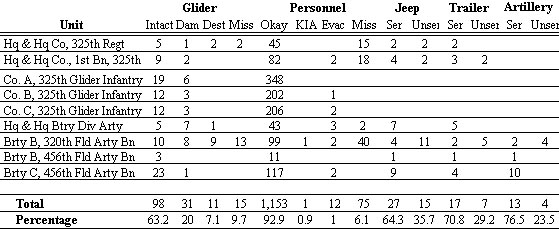
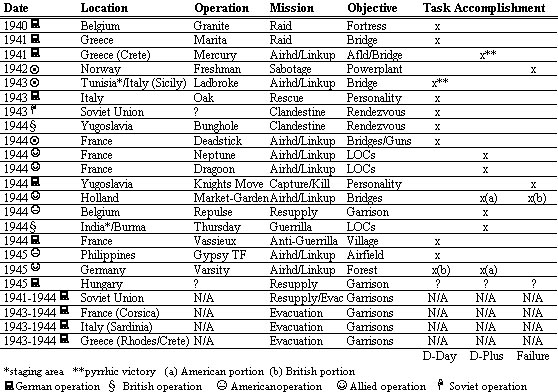
Figure 3. Service record of the glider during the Second World War
Complex Emergencies: In the past several years, relief operations in war-torn or underdeveloped nations have shared a common denominator: each depended on air traffic controllers and engineers (as well as expensive privately contracted civilian logisticians) to open, operate, and rehabilitate dilapidated airport and harbor facilities. Once operational, unloading critical items in a permissive (peaceful) or non-permissive (hostile) environment can consume precious time, especially if sealift and airlift assets are urgently needed elsewhere. Poorly maintained lines of communication and a lack of all-terrain vehicles add to the confusion and further slow down getting aid into hands of a displaced person (DP); until said equipment arrives in-theater and engineers repair the road and rail network, perishable food commodities and critical and essential medicines to sustain life accumulate in a warehouse or rot in the open air. Gliders could support future operations (at home and abroad in land-locked or littoral nations) in situations where the economic, social, and political infrastructure has disintegrated to the point it geographically isolates a segment of the population from outside assistance.30
Peacekeeping/Non-Combatant Evacuation
In support of North Atlantic Treaty Organization (NATO) and U.N.-sponsored operations, glider landings and retrievals can quietly reinforce, resupply, rotate, or evacuate contingents besieged in an enclave without alerting the warring factions or subjecting overland convoys to sectarian fighting, bureaucratic entanglements, ambushes, hijackings, mines, checkpoints, or its passengers becoming human shields. Gliders played a similar tactical and strategic role in the Second World War for reinforcing and evacuating besieged garrisons, American and German.31
5. Gliders are special operations-capable for unconventional warfare and LICs. Special operation forces (SOFs) train for years in anticipation of initiating successful small-unit maneuvers lasting only minutes to disrupt, delay, and deceive an opposing force ten times its size, gliders would be a welcomed addition in allowing these elite units to perform their repertoire of missions.
Rescues/Prisoner Snatches
In the motion picture, Escape from New York, the protagonist infiltrates his objective by landing a miniature glider; the "Gullfire" atop the World Trade Center in an attempt to rescue the President. Fictional as this account is, more plausible scenarios are possible based on historical fact: the rescue of Italian fascist dictator Benito Mussolini32 and the attempted capture of Yugoslav partisan leader Josef Broz Tito.33 In modern day terms this means SOFs could swoop down on the safe-houses of indicted war criminals, like Radovan Karazdic, Ratko Mladic, and Slobodan Milosevic whose bodyguard would be caught off balance by such an assault, and apprehend them with limited civilian casualties and collateral damage. But without overemphasizing the point too much, had the glider served as the platform of choice for similar scenarios involving SOFs (Iran, Panama, and Somalia) the final tally in casualties for each operation may have been different.
Counter-Terrorism/Counter-Narcotics: The prospect exists for SOFs landed by glider to neutralize terrorist training camps or illicit drug manufacturing facilities; Palestine Liberation Organization splinter groups found it had a role for terror purposes at one time, too. Abu Abbas, the mastermind behind the Achille Lauro hijacking crudely recognized its potential and dispatched Lebanon-based guerrillas into northern Israel by hang-glider in 1981 to drop explosive charges on an oil refinery; the raid failed due to the limited capability of hang gliders in untrained hands.34
Other Clandestine Operations: Reconnaissance: Long-range surveillance patrols could infiltrate developed and under-developed nations where the border is porous and easily penetrable. To conceal the presence of the covert mission underway, the glider could be immediately disassembled, stowed in a cache, and reassembled for pickup by aerial retrieval upon completion. Ferrying guerrillas/operatives: Gliders offer Special Force A-Detachments, Civil Affairs, and Psychological Operations personnel the opportunity to extend their influence to inaccessible hinterland for the purpose of sabotage, winning hearts and minds or political agitation and deception.35 During the Second World War, the Soviet Union regularly employed gliders for similar purposes.36 Invasion scouting parties: In the event that NATO or the UN ever authorizes the use of ground forces to evict a rogue state occupying a sovereign nation SOFs will pave the way for liberation. One may recall the template used in the Soviet invasions of Czechoslovakia and Afghanistan involved shuttling Spetsnaz teams via Aeroflot passenger aircraft to seize key points in and around Prague and Kabul. In similar fashion, SOF personnel dropped from personnel records — "sheep-dipped" — in military jargon and sporting civilian attire, identification, and cover stories would land by glider — a kind of Trojan Horse — and take up assigned posts.
6. Adapting the glider to the rigors of modern warfare, demands the merger of proven equipment designs and innovations introduced during the Second World War with technology currently in service to create a truly cost-effective platform. The best course of action for rapidly fielding a glider capability is to manufacture and modify off-the-shelf designs from the Second World War for contemporary use. Several Allied and Axis models stand out as candidates for adoption in Figure Four based on lift capacity and have cargo bay dimensions to accommodate a variety of modern wheeled and tracked all-terrain vehicles as well as towed artillery. The majority of the gliders represented underwent rigorous field testing and refinement; the payload capabilities are comparable to heavy-lift helicopters and even tactical transport aircraft at one-tenth or less of the unit cost of either; and, background studies and after-action reports on performance in combat exist. Still, others patterned on those used in competitive gliding, "had so-called ‘breaking points,’ that is, joints of purposely weak construction, which would break first in crash landings or collisions with natural or artificial obstacles. This method brought about a substantial economy in construction...[and] procurement of spare parts..."37 Modification does not entail a massive redesign of the fuselage (unless the intent is to stretch the cargo bay or improve upon aerodynamics, speed, and maneuverability of the airframe to handle the stress of jet-glider tows) rather the uniting of technology from two different historical periods.
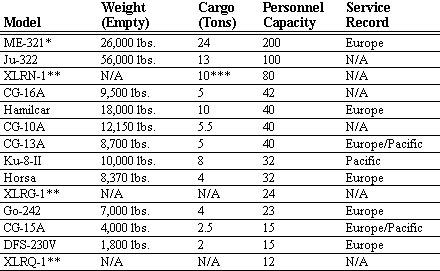
*Designated the "Giant," Messerschmitt Aircraft built 200 ME-321s in anticipation of Operation SEALION — the invasion of Great Britain — and it is considered the largest operational glider ever in existence with a cargo capacity equal to Boeing's 707-320B jet and a personnel capacity comparable to the C-130, C-17, and C-141. **Amphibious-capable ***Capable of carrying 3,000 gallons of fuel.
Figure 4. Second World War gliders suitable for contemporary service38
 www.youtube.com/watch?v=AP0PWlSLbYc
www.youtube.com/watch?v=AP0PWlSLbYc
Allied and Axis ingenuity pulled off some of the most simple, yet extraordinary innovations in terms of braking systems, crash-protection, an aerial retrieval system, an jet-assisted take-off (JATO) that still have an essential role to play.39 Whereas portable and compact off-the-shelf technology developed for civilian and defense applications during the Cold War exist that add minimal weight and can be reversed engineered into the fuselage to bridge the gap between those problems solved and those remaining after the military discontinued interest. These include: night vision goggles, global positioning satellite (GPS) receivers, composite materials, etc.40 Still, the trick to constructing the gliders within budget at a low cost per unit and ensuring delivery on schedule is to award all contract and sub-contract work only to companies possessing intimate knowledge on the day-to-day manufacturing process of civilian gliders. The reason is simple. Companies in this field are 50 years ahead of the traditional military-industrial complex in terms of technology and design.
7. Gliders are a true joint service platform that promotes interoperability. "Joint" has become the 1990s watchword synonymous with the competition taking place in the U.S. armed forces as inter-service relationships become the means for preserving budgets and guaranteeing additional funding. From several vantage points, beneficial side-effects at the inter-service level are thus obtainable with the introduction of the glider.
Army: Apart from the inherent traits already mentioned in this paper, there are added budget savings. As an effective and cheaper alternative, gliders offer the possibility of diminished wear and tear on the Army helicopter fleet and an extended service life. Subsequently, such measures would pay dividends in the form of annual fuel and maintenance savings and conservation of critical spare parts in high-demand as budget allocations decrease. Compared to attending airborne or air-assault school, glider familiarization training should cost less per trainee (in terms of training aids, aircraft usage, and course length) since instruction primarily deals with the procedures of bracing oneself for a landing; the same would also be true of glider versus helicopter pilot training.
Air Force: Again, the reasons are
budget savings, easing the burden on an overstretched airlift fleet, reduced fuel and
maintenance costs, and an extended service life for strategic and tactical transports.
Figure Five illustrates that adopting off-the-shelf designs such as the German ME-321 that
had a payload capacity exceeding the C-130H/J transport means the latter could tow two or
three of the former in a single sortie thanks to its light-weight construction.41
Thus, deploying a division maneuver brigade should require fewer transports and sorties.

Figure 5. ME-321/C-130H comparative data42
Take for example, Operation Just Cause which required an airlift package of 51 C-141 aircraft to drop 2,288 paratroopers, 78 M-998 HMMWVs, 12 M-551 Sheridan light tanks, and four M-102 105mm howitzers.43 A glider assault of comparable stature employing heavy- and medium-lift designs from the Second World War would require a total of 24 ME-321’s (12 carrying troops and 12 for the tanks), 39 Hamilcars (with space for two HMMWVs each), and two CG-10As for the artillery. A total of 65 gliders which require an equal number of transport aircraft. However, use double glider tows and the airlift package requires only 33 transport aircraft, 18 less than the parachute assault. If the C-17, C-141B, or C-5B serves as the accompanying tow aircraft, the greater engine thrust of these transports could each convey more than three gliders at once, thereby multiplying the overall lift capability by a factor of several while halving the financial outlay.44
Navy and marine Corps: Doctrinally, amphibious gliders offer the possibility for greater standoff distances and increased operational surprise against littoral regions, two prerequisites for projecting an over-the-horizon capability.45 What is more important there is a historical precedent. The marine corps and the Department of the Navy pressed vigorously for the activation of glider infantry battalions earlier then did the Army.46 However, what started as enthusiasm turned into disenchantment as questions arose as to which service should manage the program as well as pressure to review and expand procurement requirements coupled with delays on the part of contractors. Taken in turn, these debates "...acted as a dissuading force on those who were intent on its development." A year-long joint study quietly shelved the project in 1943 and concluded gliders, whether amphibious or land-based, were of no practical military value and cited, "the Marine Corps had no use for unproven equipment [emphasis added]."47 Potential counter-arguments from either service against gliders cannot cite this argument or each would have to reconsider the wisdom of procuring 473 MV/HV-22B Osprey’s since it is an untested hybrid with a limited payload capacity of only 24 troops or 20,000 pounds of cargo and a price tag at $33 million a copy, not to mention a production run scheduled to last 10 to 25 years.
Now the Tricky Part, or Maybe Not?
In the first part of this paper I examined the utility of the glider for contemporary military use. Should the Army feel a proposal to reinstate such a capability worthwhile, two factors threaten to undermine this potential enhancement: bureaucratic entanglements and methodology. The former concerns program management, quality control, and inter- and intra-service rivalry; the latter, doctrine and organization. Without a plan of action to address these points negates the advantages of and could kill any attempt at resurrection either before a Congressional, Department of Defense (DoD), or Army review board. Whereas this may seem like an obstacle, it is not. Similar issues, cropped up during the Second World War where solutions based on lessons learned are to be found.
Climbing the Five Pillars
Before mentioning these issues though it is important to take stock of the complexity involved in translating any operational objective into material reality to understand where in this scheme these pieces fit in. The process is multi-structured. At the core of which is a series of interrelationships of inputs and outputs that "push" the objective along until fulfilling said goal. The action is also perpetual. Since, "ultimately, any ‘enhanced’ capability becomes a current capability [emphasis added]," the physical presence of which influences the milieu and tactics of an opposing force (OPFOR), and vice-a-versa. Five pillars, each led by a different ensemble, aid this process.48
I. Worriers: Their function is to proactively rather than reactively assess, identify, and compare capabilities and critical deficiencies, current and projected, vis-a-vis stated national security objectives. Major influences on, or participating in these "visions of combat environments," include: service chiefs, combatant commands, the joint chiefs of staff (JCS), and the Secretary of Defense. The inferences drawn, if serious enough, determine the relevance, and general likelihood, of permitting an enhancement in capabilities to attain the operational objective. On their recommendation and authorization, they direct others to convene and think the matter through.
II. Conceivers. Formulating, defining, and evaluating alternative, yet not necessarily new, concepts to achieve the stated objectives are the responsibility of this group. Side-effects of proposals tendered may entail revisions in doctrine, ideas of employment, tactics, training, and/or organization. This blending of technical and operational know-how, from battle labs, industry, and a "Red Team" vulnerability assessment, allows both to come an understanding on what is feasible and useful in linking requirements with established technology to accomplish specified military tasks. "Proof-of-principle" trials are then undertaken to demonstrate the military worth of the resultant proposal submitted before the next pillar in the hierarchy renders a decision on its ultimate disposition.
III. Deciders. The jurisdiction of this authoritative forum, principally made up of high-ranking DoD and military officials, has the final yes or no on underwriting and funding the proposal.49 Accordingly, a decision to officially endorse an alternative concept is a public declaration of confidence that for purposes of national defense, constrained budgets notwithstanding, U.S. forces must acquire this system. Before reaching a verdict though, they must confront several broad, but important, issues. Among the topics tabled for discussion include whether the operational objective addressed and concept proposed are critical and essential to warrant further consideration; second, what substantive changes, if any, are in order to adapt the present force structure to the proposal under cross-examination. Special features, performance and forecasts, especially on cost and date of IOC also figure into the judgment made; any suggested tradeoffs in the preceding are conditional upon presenting evidence that the concept candidate can indeed perform its intended mission. Allocation of monies is contingent upon how available combat and logistical assets intend to use the candidate within the framework of warfare, the cost of which varies at the tactical, operational, and strategic level.
IV. Acquirers. Turning concept into reality is the motivation behind the efforts of a partnership between DoD and service acquisition and program executives or managers; a quest deemed at an end when fully functional production models come off the assembly line. Working to achieve this intended outcome is in itself a process of time-sensitive decisions and critiques over headway gained and management discipline; satisfactory performance of both determines when and whether to proceed into the next development milestone (engineering, manufacturing, full-scale production) on schedule.
V. Organizers. The credibility of the concept does not end with acquisition, only integration, equipping, training, and sustaining can do that. Custodian for shouldering such an awesome burden logically falls to the intended recipient, either one or all armed services — they are after all, the official purveyors of these functions. To meet the IOC timetable, preparations must begin during the previous stage to facilitate interaction and cooperation between the program manager and service commands (procurement, logistical, and operational) so all "ships sail in one direction." Thereafter, the service hierarchy, on the advice of its functional and operational commands, authorize the table of organization (T/O) and equipment for those particular forces under their stewardship designated to get that system. The responsibility for assisting field commanders in equipping their assigned force elements is handled by the Service Acquisition Command. Furnishing operational commands with the authorized quantities and types of supplies and support equipment for the systems expected service life is the job of a logistical integration agency. Only when there is full compliance with these prerequisites can the service Secretary and Chief report that an enhanced operational capability genuinely exists.
Bearing in mind this process with relation to first half of the paper reveals that it was, in essence, a microcosm, that briefly touched upon points related to the first three pillars. Whereas the issues that follow run the gamut and are difficult to pin down on any one pillar since each overlap the other while introducing parallel concepts.
Program Management
Since the Army discharged the last glider-qualified personnel from its ranks over five decades ago, it must look again to civilian sector to provide the source of knowledge to revive this art of warfare. The modus operandi for reinstatement is the civilian-military staffed glider program instituted by General Henry Arnold (Commanding General, U.S. Army Air Corps). General Arnold, "...firmly believed that a civilian expert knew more on a given subject than any military man. If gliders were the wave of the future, he wanted a civilian in his office to advise him on how to recruit and train glider pilots and on what sort of gliders to buy."50 Competitive gliding is where General Arnold summoned experts like 35-year old Lewin Barringer to coordinate the entire program. Other personalities associated with the "gliding club" provided further expertise. The New York-based Elmira Area Soaring Corporation, under the direction of soaring champion John Robinson, established the guidelines for a detailed 30-hour instructional course that trained the initial cadre, at 18 civilian schools in 11 states, and became the standard for all 6,000 subsequent recruits graduated from the program.51
Thus, the Army should again enlist the expertise of competitive gliding. There are ample numbers of glider pilots worldwide who pursue soaring as a sport and could be contracted out to serve as a cadre. These individuals are an adventurous lot and may find the prospects of employment for what they do best in a hazardous environment tempting; there would be little doubt over their skill and training since the Army would get the best in the field.52 Participation on their part can take many forms such as updating the original pilot curriculum with standardized training guidelines already in force among civilian soaring associations. Also invaluable is their familiarization with those companies that manufacture and design gliders so as to know whom the Army should do business with and those to stay away from in terms of reputation, facilities and infrastructure, and customer satisfaction and service.
To avoid the same misunderstandings that arose between the military and civilian coordinators because the latter did not understand the requirements of the former or "speak their language," there is one viable solution. Consult those remaining glider-qualified veterans to serve on a board of review or as an intermediary, to offer constructive advice and recommendations, before senility and death render this forgotten breed extinct. These individuals have first hand experience to set the record straight on what worked and did not work with regard to training, tactics, and equipment. Their participation, eyewitness accounts, advice, and support would be readily accessible, if not free, since Allied and Axis glider pilot veteran associations exist worldwide.53 In keeping with the Total Army Quality management philosophy, this "idea center" would also insure that any suggestions however bold or radical would receive careful and detailed study Quality Control
"Discord, a mixture of misdirection and lack of direction, absence of firm goals, and bad management at several levels," best describes the wartime production of gliders in the United States.54 Handicapped from access to the skilled labor and techniques of mass production found in the powered aircraft industry, because priority went to combat aircraft, especially after Army Air Corps procurement boasted it would field 5,000 combat aircraft per month, forced glider design firms to license manufacturing rights and award sub-contracts to an "unimposing" industrial group ranging from the food service to brewing industry.55 These companies had little or no knowledge of producing precision aircraft components.56 Consequently, quality control was hard to monitor throughout the program which cost lives in the field as fuselages occasionally disintegrated while being towed to a landing zone (LZ), thus earning the nickname "plywood coffins." The reason primarily being standardization and interchangebility of parts simply did not exist; indirectly, internal politics had something to do with it. At the onset of the glider program, the government contracted a single engineering firm to manufacture the master jigs and fixtures to universally supply the prime contractors. However, an "over-anxious" Air Corps Material Center ignored that directive and authorized every contractor to build their own machine tools and to forsake interchangebility in favor of meeting production quotas as soon as possible. The confusion caused by these conflicting instructions pushed the timetable back by several months.57 A distinct side-effect of these practices was the significant rise in unit price of the same model of glider depending on who was the manufacturer. Out of the 16 U.S. companies licensed to build the 15-seat Waco CG-4A glider, for example, only the Ford Motor Company, a leader in streamlined and efficient mass production, was able to turn it out for $15,000 per copy — the lowest price on record; the other 15 billed the government upwards of $25-50,000 for the same unit.58
A safeguard to avoid or lessen the likelihood of similar oversight arising in terms of confusing and conflicting signals is to delegating reprogramming authority to the Program Executive Officer guided by a charter defining the relationship between that individual and the Army Acquisition Executive. The real trick though to constructing quality gliders within budget at a low cost per unit and ensuring delivery on schedule is to award all contract and sub-contract work only to companies possessing intimate knowledge on the day-to-day manufacturing process of civilian gliders. The reason is simple. Companies in this field are 50 years ahead of the traditional military-industrial complex in terms of technology and design. However, in the pre-production stage, low-level contacts between the two are necessary for two reasons. First, to ensure a smooth transfer of any defense related components incorporated into Second World War designs. Second, to train executives and skilled workers in the techniques for operating a dual-purpose production line: the first dedicated to multi-year and unit purchases by a single military customer; and, the second for civilian consumption based on the law of supply and demand. Still, cooperation can extend to the leasing of sophisticated test facilities (e.g., wind-tunnels) that all glider manufacturers may not have access to.
This recommendation goes a long way in furthering the path to acquisition reform espoused under the Bottom-Up Review: 1) maintains "leading edge" technology by looking beyond the dedicated defense industry to commercial sectors where the most significant advances and innovations transpire and thrive; 2) broadens the industrial base for DoD as the number of traditional suppliers shrink to ensure the means are in place to gear up for a wartime economy should it become necessary; 3) integrates military and commercial technologies, for exploitation and exchange by either industry; and, 4) encourages competition which in turn yields more efficient operations while abridging delivery times.59
Inter- and Intra-Service Rivalry: In the Second World War, infantry accounted for 36 percent of the U.S. Army; Korea — 33 percent; Vietnam — 22 percent; and, post-Vietnam — 15 percent. That figure now stands at only 11 percent or 54,000 infantrymen out of a post-Desert Storm army totaling 495,000 Soldiers grouped into 10 regular divisions and several separate brigades.60 The Army would find this adequate if not engaged both at home and worldwide. Unfortunately, with foreign deployments come an urgent need for both firepower and a physical presence, rather than trading off the latter in favor of the former. Subsequently, infantry-intensive operations, combining aggressive patrolling with protection of non-combatants, are on the rise. With the inroads the Bosnia, Haiti, Kosovo, Macedonia, and Sinai deployments are making on this MOS, the Army is hard pressed to retain its strategic reserve of airborne units at full-strength and in fighting trim.
However, the reintroduction of the glider will see bayonet strength increase by as much as 10 to 30 percent, the equivalent of almost a battalion or fourth maneuver brigade respectively, if one factors in the 500-600 (low-end) or 1,600-1,800 (high-end) glider pilots whose MOS reverts to that of an infantryman upon landing. There is a caveat. Reinstating a glider capability will renew the debate regarding the true profession of glider pilots. Sort of like the riddle, "What came first, the chicken or egg?" Only in this instance the question is, "Are they fighters or fliers first?"
Labeled "the most uninhibited individualists in the Army," glider pilots endured criticism from their compatriots for lacking a clearly defined mission.61 This controversy has its origins in a 1942 directive issued by the U.S. Army Air Corps: "The role of the glider pilot in combat will be primarily to land his glider safely, expedite the rapid debarkation of his passengers, secure his glider on the ground...The glider pilot will participate in ground combat only in exceptional circumstances or after his glider has been wrecked in landing." This official prohibition on direct participation in combat invited criticism from both American and British airborne commanders.62
Avoiding this pitfall demands adopting the argument used to solve the inter-service problem that arose between the RAF and British Army during the establishment of the Glider Pilot Regiment. The latter held the view that flying a glider was incidental to serving as an infantryman while the former insisted gliders and glider pilots were RAF property available for detached service when involved in airborne operations. Both came to an understanding that glider pilots must be a "total Soldier" cross-trained in the tactics and equipment of the aviator and infantryman (with training responsibility equally divided) since the importance of the latter superseded the former upon landing.63 Tailoring this solution to "joint" service relationships could entail a special memorandum of understanding (MoU) establishing a combined Army-Air Force glider training program; MoUs signed in the 1950s resolved similar differences over the ownership and function of helicopters in ground combat operations.
This proverbial Magna Charta would define the roles and missions accorded to each service. The Air Force Academy at Colorado Springs would concentrate on teaching the basics about gliders and gliding (where it is reported to operate one of the largest soaring schools in the world) while the Army School of Aviation at Fort Rucker, Alabama would provide advanced training on tactics and techniques before rotating candidates through the School of Infantry at Fort Benning, Georgia. Official branch affiliation for pilot candidates would remain as Aviation though for combat purposes, as existed in the British system pilots would organize into infantry units with the senior glider officer and a small staff acting as a provisional headquarters to provide command and control. This solution also goes a long way in addressing the criticisms over identity that prevented closer integration between Army Aviation and the traditional branches of the combat arms over accusations the former would "drift away" as the Air Corps did several decades earlier.64
Other keys to heading off further intra-service spats in the airborne ranks require instituting for all glider-qualified personnel the rights and privileges pertaining to an elite formation (e.g., hazardous duty pay, qualification badges, headgear, etc) as in parachute and air-assault units; a recognition of service originally denied them for most of the Second World War.65 This may lessen, but not totally resolve the problem; bickering still exists in the 82nd Airborne over the semantics that bond a paratrooper to his regiment's past.66 Doctrine
Some thoughts on airborne warfare are worth pondering in this discussion. Dedicated parachute and air-assault divisions perform the same role on the battlefield: airhead and seizure and link-up operations. However, neither force, including ad hoc task forces, is specifically trained nor organized from within to fight as combined airborne arms team that integrates the helicopter and parachute assault into a flexible combination at division, brigade or battalion-level. This is in stark contrast to armored and mechanized divisions that continuously train, with the platforms that transport them into battle, for combined arms operations integrating battalions of tanks, infantry fighting vehicles and self-propelled artillery into a cohesive combination of firepower, maneuver, and mass.
Therefore, airborne methods of insertions should not be considered in isolation either. Only through integration, will the tab "Airborne" take on its rightful meaning. The reinstatement of the glider, thus, would lead to questions of how to best employ it alongside the helicopter and parachute in terms of doctrine and organization. Any review committee, akin to the Howze Board on Airmobility, may likely conclude that what is being proposed is the creation of an Airborne Triad. The Airborne Triad is a descriptive term used to denote the synergism of the parachute, helicopter, and glider into a more capable whole for power-projection operations. Such a force mix (Figure Six), like its nuclear-based counterpart, has enough built-in redundancies as well as compensations to present an OPFOR with a myriad of offensive and defensive problems.

Figure 6. Capabilities of the Airborne Triad
Doctrinally speaking, gliders form the apex of the triad (Figure Seven). It is only logical as an authentic, inherent stealth capability makes it easier to seize objectives quietly and quickly. Parachute and air-assault units, in no definitive order, constitute the second and third tier of this "total airborne" concept; the former to reinforce and expand an airhead while the latter maintains the momentum on the battlefield with pursuit and blocking forces. This indulges a commander the flexibility to commit both in a proper sequence at his own time and place of choosing based on battlefield requirements.
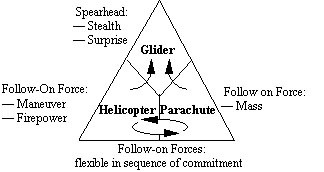
Figure 7. Hierarchy of the Airborne Triad
For the triad to be in proper synchronization, however, airborne doctrine must adhere to the German school of thought that stresses: 1) gliders are fundamentally for attack rather than a follow-on force; and, 2) smother the opposition by landing on top of objectives rather than near it. The U.S. Army violated both principles during the Second World War. Figure Eight shows the comparison of Allied and Axis task accomplishment when using the glider in either role.
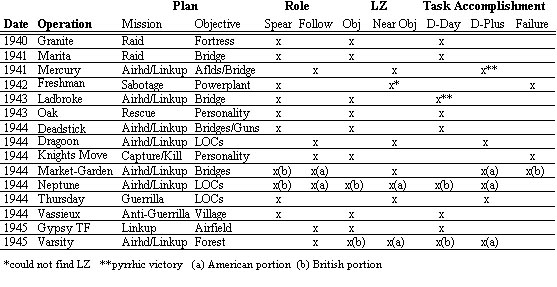
Figure 8. Allied and Axis tactical battlefield employment of the glider, select operations
What the Army never reconciled itself to was the fact that the Germans were quite successful with gliders only because they caught the OPFOR completely by surprise and there were no constructed defenses in place. Instead of landing gliders in geographically confined areas, as the Germans preferred, American planners favored multiple LZs spread out over vast open expanses. A minor deviation like this had important tactical implications. It set the criteria for the selection of LZs in every major allied airborne operation thereafter which proved to be a very reliable planning guide for the Wehrmacht when determining suitable locations for the placement of anti-glider obstacles.
This is because the War Department field manual on airborne warfare emphasized the exact reverse of what German doctrine successfully proved at Eban Emael in 1940: glider landings should occur only after parachutists seized suitable LZs. Such folly came at the expense of the mission as the fog of war descended over the battlefield; most glider landings occurred at dawn or dusk on or after the first day of operations. Post-operation debriefing conferences repeatedly pointed out that while tactical organization marked the appearance of glider infantry, confusion reigned for parachute infantry who were still trying to secure the airhead and regroup at the same time. Furthermore, measuring the gliders true success rate was not about surprise or even taking D-Day objectives, but about calculating the tonnage and personnel delivered daily, important as both are, the pair are only part of the equation.
Though tied to the American concept of airborne operations, their British counterparts found they rapidly achieved their task if they deviated toward the German model. Nowhere is this more evident than in a comparison of Operations DEADSTICK and MARKET-GARDEN. DEADSTICKpulled off a D-Day coup de main against the Orne River Bridges in Normandy. Six gliders landing in total darkness, only yards away from the two inter-connected bridges, provided the means for a single infantry company to rush the bridges, assault the garrison, and capture these vital transportation arteries, all within twenty-five minutes. Simultaneously, three gliders set down a platoon of combat engineers nearby, and though out-gunned, destroyed a coastal gun battery after fierce hand-to-hand combat. Less than three months later in Holland, the British were quick to forget the success of DEADSTICK during the rushed planning and execution of Operation MARKET-GARDEN. Assigned an LZ inconsistent with its earlier action, located some eight miles from the objective; Arnhem Bridge, the glider, received unfounded criticism for hampering its seizure by the reconnaissance squadron of the 1st Airborne Division. Colonel Charles S. Chatterton, (CO, the Glider Pilot Regiment) when questioned on the matter after the war, recounted his wartime assertion on the need for an Orne River Bridge-type coup de main: "I saw no reason why we could not do it, but apparently nobody else saw the need for it, and I distinctly remember being called a bloody murderer and assassin for suggesting it."
 www.youtube.com/v/VSm5nBZ4X0A
www.youtube.com/v/VSm5nBZ4X0A
The Germans learned all too well from earlier airborne operations on Crete that such a gross violation of airborne doctrine can lead to disaster or failure. In planning for Operation Mercury, the High Command held a viewpoint that gliders lost their surprise value after Eban Emael since they were no longer a secret. To signal the start of the operation, instead, Parachutists were to drop on and seize three airfields; at first without any definite axis of attack and then expanding zones of control with follow-on forces, landed by glider and transport, until finally they ran together, like oil spots, extending over the island's 170-mile length. This strategy, akin to Napoleon's maxim, "one engages the enemy everywhere, then decides what to do," went awry; as history documents, seizing the objective took two days with extremely high losses in men and material.
Organization
For proper field evaluation of the Triad, division test designs must mirror its inherent traits: a great capacity for rapid reaction movement; fight in many directions at once; and, suited towards a diverse variety of contingencies. Subsequently, there are two options for interjecting the Triad into the 18th Airborne Corps order of battle.
Option one is to augment an existing light infantry division with gliders to complement the 82nd Airborne and 101st Air Assault. The 10th Infantry Division already earmarked for Corps use is the perfect candidate. First, its combat to support ratio is heavy in "teeth" — infantry — light in "tail" — vehicles and support personnel, and deployable in 478 airlift sorties (or four days) compared to 985 (or nine to 10 days) required to transport the 82nd; with pre-stocked and prepositioned gliders this may further reduce estimated time of arrival in-theater. Second, it does not gouge parachute and air-assault infantry battalions from its counterparts. On the other hand, with glider infantry of the 10th ID the first to deploy in a crisis — a position traditionally occupied by the 82nd during and after the Cold War — friction between may arise. What is more important, an entire division oriented towards glider landings, as with its counterparts in the 82nd and 101st, lacks or is light in the other two integral components of the Triad. This may prove time consuming and cumbersome during operations as one division commander would have to coordinate with the other two to provide or requisition their share of the Triad. If that is the case, then it defeats the purpose of the Triad since the concept mandates total, immediate, and unrestricted access to all three platforms.
Option two is to convert the 82nd and 101st over to a new force design — the internal Triad. There are four test bed designs.
Alternative (I) — A prototype T/O for an airborne division (Figure Nine) under this heading would comprise three brigades specifically oriented towards either glider, parachute, or air-assault operations with appropriately qualified division artillery, and combat support and service troops attached. At first glance, this force design parallels the ill-fated triple capability (TRICAP) test division of the early 1970s that paired up an armored, air-assault, an air cavalry combat brigade. TRICAP failed according to some accounts because there were too many divergent goals and differing capabilities, whereas this force structure depends almost exclusively on the combat infantryman; the only difference is the method of physical insertion. Still, there is a historical precedence, similar types of airborne divisions, yet only dual-capable, were in service with both sides during the Second World War. Although this practice ended with the phasing out of the glider in the late 1940s, the Army briefly revived the design after airmobility became accepted doctrine.
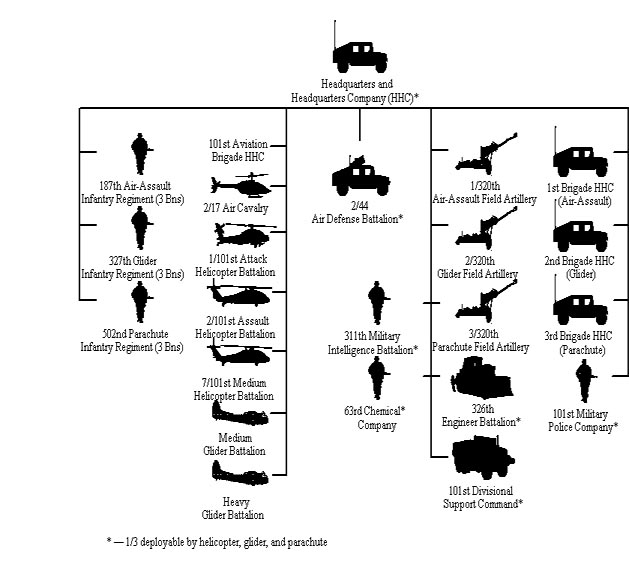
Alternative (II) — The underlying principle of this design (Figure 10) is three components: maneuver, combat support, and combat service support with one-third of each going into battle by glider, parachute, or helicopter. Integration of the Triad is within the brigade rather than by brigade as three separate but equal battalions form the core of the division's three maneuver brigades.
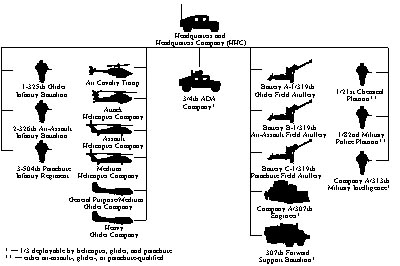
Figure 10. Division Alternative
Concept II adapted to a brigade from the 82nd Airborne
Alternative (III): This concept (Figure 11) borrows from the combined-arms battalions that made up the now disbanded 9th Infantry Division (High-Technology) which paired up [wheeled] motorized infantry, anti-armor, and support companies. Under an airborne incarnation, a division would consist of three brigades of three integrated airborne battalions (Headquarters and Headquarters Company, and four rifle companies with an attached artillery battery and service and support company) each tailored to a configuration heavy in one platform and light in the other two. Since each battalion is self-sustaining the design is readily adaptable to airborne battle groups serving outside the continental U.S. with the Alaskan- and Italian-based Arctic Warfare and Southern European Infantry Brigades.
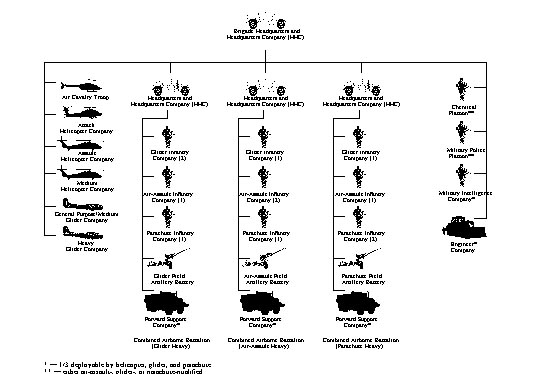
Figure 11. Division Alternative Concept III, prototype division maneuver brigade
Advantages: First, each design promotes "joint" airborne operations and permits a commander to throw a three-fisted response into a vertical envelopment instead of a single division dedicated to one method of insertion. Second, each force mix is more in tune with operational reality: combat parachute drops and air-assaults above brigade level are rare. Third, it "trims the fat" out in terms of the number of assault helicopters and associated support personnel and equipment required while reaping the benefits in maintenance and fuel savings. Lastly, all designs are conducive to promoting close cooperation and coordination among the Triad with regard to planning, logistics, and operations.
Disadvantages: First, normal rotations of brigades through the three six-week increments (alert, training, and support) that make up an 18-week Division Ready Brigade (DRB) cycle are impossible; as spearhead, the glider brigade could never cycle out of the DRB-1 slot. To make it possible for the rotation of all three brigades, every enlisted person and officer in the division would have to be (and remain) qualified in all three methods, in itself an expensive proposition. Take note that this applies only to Division Alternative Concept I. Division Alternative Concepts II and III are able to rotate through the DRB cycle, though the latter could cause friction between regiments or battalions who share different lineage’s as they would no longer retain their traditional primary role.
Alternative (IV): Not of the same mold as the others, this design essentially grants the 82nd and 101st the right to retain their current T/O; instead, the glider would augment the division aviation brigade. Advantageously, it gives either division a glider capability while retaining the same number of battalions on jump and air-assault status and associated regimental lineage; German airborne divisions adopted a similar practice during the Second World War. Only the 82nd Airborne though has the potential to deploy by all three methods since an assault helicopter battalion is already attached to its aviation brigade, a capability secondary to its traditional parachute role. Nevertheless, a major disadvantage is that without an esprit de corps to distinguish glider riders from parachutists or air-assault troops the division may never truly accept or properly employ military gliders in an effort to undermine the Triad.
Any Takers?
One final thought comes to mind. If gliders have a purpose in modern airborne warfare someone in the U.S. Army or another army would have already thought of it? The truth is the Soviet Army rejected American and British post-war assessments that these motorless aircraft had no place in airborne doctrine and maintained three glider infantry regiments in its order of battle from 1946 to 1965. Speculation persisted as late as the 1970s (and may still hold true today) that a cadre of pilots remained on stand-by alert and caches of gliders developed over that 19-year period existed. Furthermore, other nations such as China, India, Turkey, and Yugoslavia, regions of current or potential conflict, fielded military gliders for a brief period during or after the Second World War, and have the potential to do so again. However, the real driving force behind such a question in terms of a contemporary explanation comes down to a disclosure on the matter made by the Chief of Staff of the U.S. Army Airborne Command in 1943. His remark is telling and still accurate: "...one of our basic troubles has been the failure to properly evaluate this new weapon from the topside down." This disclosure explains why the combat glider is perhaps the only category of equipment in modern military history discarded by an army after an exceptional combat record overseas. Though to reiterate, there are still worthwhile roles for the glider should the Army find its wants such a capability. Remember, it is fashionable these days to go "retro" and acquire the accouterments of an earlier, in some ways, more imaginative era for contemporary use and other segments of the defense establishment appear to be drawing that conclusion too: the Joint Chiefs of Staff are currently re-evaluating giant transatlantic airships, similar to those of the 1930s, as heavy transports for armored and mechanized divisions.
With Change Comes Hope
For the issues, ideas, and recommendations mentioned throughout this paper, reform goes a long way, should the opportunity present itself, in making the climb for the glider up the five pillars easier a second time round. Slow to embrace new ways of thinking and doing business the Army has set about reinventing itself from within starting from the top down thanks to the National and Defense Performance Review initiatives. Gone are the days of the rigid, overly centralized, highly regulated, bureaucratic, and passť system of institutionalized group think that pervaded the armed services throughout the 1970s and 80s. Functional commands are now empowered to foster innovation where results not rules, or red tape, is the key to remaining focused on core missions. This "new look" permits those specific commands (e.g., TRADOC, FORSCOM, and AMC), under whose mandate the glider may find itself scrutinized, the freedom to explore that which might not have otherwise seen light or been quickly swept under the carpet. Reinvention labs and waivers of acquisition regulations are some of the mechanisms in place that make this possible. Conclusion Reinstating a glider capability requires an open-minded U.S. Army bent on preserving its power-projection capabilities in this critical phase of transition. Anything less is to invite future problems by replicating the mistakes of the past since the glider is within the means of former powers and even the poorest of nations. Keep this in mind. Airborne advocates took notice in 1954 when General James Gavin published an article entitled "Cavalry...And I Don't Mean Horses!" Subsequently, light tracked armored personnel carriers, helicopters and airmobility emerged as the guiding theory of like-minded individuals belonging to the "airborne club". Senior officers endorsed the article as part of a concerted effort to gain public support for the Army; a necessity spurred on in part by a declining budget after Korea where the watchwords of the day were "caution, prudence, and thrift." Then, ignorant critics questioned the need for funding and maintaining two airborne divisions since massed parachute drops were obsolete on a potential nuclear battlefield. [The Russians knew better] Now, these watchwords echo a similar dilemma in the aftermath of the Cold War as the Army assesses the budgetary side-effects of the Bottom-Up and Quadrennial Defense Reviews: operations and maintenance accounts diminishing; forward deployments multiplying; and, unit readiness to sustain and engage in two major regional conflicts declining as OOTW dominates the minds of planners. When you consider these challenges as a whole the usefulness of exploiting the glider becomes clear.
However, there are bureaucratic and methodological challenges in store if the Army seriously takes an interest in reinstating a capability of that kind. Preparation is half the battle. The first step though is to understand the symbiosis between the overall framework (or life-cycle) for enhancing operational capabilities with its integral elements or pillars. Then from there, areas of contention can be identified and a game plan developed to address concerns early head-on. The glider, unlike other systems vying for notice, learned its lessons five decades ago and solutions exist to head off the same snafus. Like the Phoenix reborn from its own ashes, taking advantage of or improving upon what worked or did not work in the past may prove beneficial in saving time, money, and what is more important, guarantee that airborne forces procure and deploy a credible warfighting tool.
1. The glider traces its origins to Greek fable of Daedalus and his son Icarus. According to legend, King Minos imprisoned father and son in a labyrinth on the isle of Crete. Having secretly fashioned wings made out feathers and wax Daedalus and Icarus escaped their imprisonment by gliding over the prison wall. Captivated by the experience of flight, Icarus ignored his father’s advice to soar low over the water until they reached safety in Sicily. Instead, Icarus flew higher until the temperature of the Sun melted his wings and plunged into the sea and drowned. Attempting to turn myth in reality, successive generations of proverbial Daedaluses determined to fly instead went to their deaths. Several centuries passed before Leonardo Da Vinci’s detailed anatomical studies of humans and birds confirmed the futility of man’s earlier attempts to fly vis-a-vis arm-powered wing-flapping mechanisms. Compensating for the inadequacies attributed to the human physique, Da Vinci conceived of a flying wing incorporating a system of cables and pulleys to harness the kinetic energy derived from briskly moving the arms and legs; modern-day hang gliders are nothing more than derivatives of these sketches. Gerald M. Devlin, Silent Wings, (New York: St. Martin’s Press, 1985), pp. 1-2.
2. German inventor Otto Lilienthal turned Da Vinci's theory into reality four centuries later as he flew a single-wing glider off a Berlin hillside in 1891. A mechanical engineer by trade, Lilienthal had earlier published Bird Flight as the Basis of Aviation, a culmination of 10 years of research which essentially upheld Da Vinci’s findings. Over the next several years, Lilienthal carried out 2,000 glides in a visionquest, that ultimately cost him his life, to duplicate the dexterity of a bird; constant refinements in design gradually extended flight time, distance, and altitude. Further experimentation discovered that an individual could effect turning maneuvers using the prevailing winds as propulsion if one shifted their weight in the direction they wished to travel. Ibid., p. 4
3. Ibid. pp. 16.
4. Specifications required the glider must land a combat-ready formation or cargo on short, uncultivated fields no longer than 75 yards, and unit cost must not exceed 7,500 Reich Marks; the equivalent of manufacturing 10 parachutes. Milton Dank, The Glider Gang, (New York: J.B. Lippincott Company, 1977), p. 22.
5. By 1946, the U.S. Army disbanded eight of 11 glider infantry regiments, a separate glider infantry battalion, and seven of 11 glider field artillery battalions. The U.S. War Assets Administration declared gliders’ surplus and the public immediately purchased all excess stocks for $75 each, (original unit cost: $15-25,000) not for the aircraft itself but for the lumber content in its five shipping crates — enough to build a small ranch-style house. In post-war Great Britain, the Glider Pilot Regiment, after returning from occupation duty in Palestine, saw its strength decrease to only a headquarters and training squadron plus two tactical squadrons. By 1950, a single squadron remained, and the Royal Air Force (RAF) discontinued new intakes of pilots; a year later it abandoned the program and reassigned crews to powered aviation units. Not until 1957 did the British Army officially disband the regiment. Devlin, op. cit., pp. 374-375. Shelby L. Stanton, World War II Order of Battle, (New York: Galahad Books, 1991), various pages.
6. History of the Training of the American Paratrooper. Obtained electronically from www.benning. army.mil/fbhome/training/zinhome.htm.
7. Department of the Army, The United States Army Posture Statement FY95, (Washington D.C.: Headquarters, United States Army, February 1994), p. 16.
8. Figures obtained from the constituent newsletter put out by the office of U.S. Representative Rodney P. Frelinghuysen (R-NJ), 11th Congressional District.
9. There is truth in this declaration. Consider the story of German teenager Mathias Rust whose unmolested aerial sojourn over the eastern Soviet Union in 1987 ended with him landing a two-seat Cessna aircraft in Moscow’s Red Square. Such an unforeseen contingency sowed a feeling of consternation within the Politburo and Ministry of Defense and advertised the Soviet Union’s vulnerability to penetration by a simple aircraft design.
10.Airborne Operations - A German Appraisal, Pub 104-13, (Washington D.C: Center for Military History, 1989) p. 28.
11. Marcel Baudot, ed., The Historical Encyclopedia of World War II, (New York: Facts on File, 1980) p. 3.
12. Debriefing conferences provided a more realistic picture of the assembly time by either method, but still bear out the statements made. Describing the assembly of his unit in the Normandy hedgerows, a Lieutenant-Colonel Boyd of the 1st Battalion, 325th Glider Infantry explained: "We came in at D plus 1...and landed at seven o’clock in the morning...Out of seven hundred men, we had 600 hundred ready to operate [by] 2pm." His counterpart, a Lieutenant-Colonel Timms of the 2nd Battalion, 507th Parachute Infantry who landed the previous day was not as fortunate: "I had a lot of difficulty in assembling...I never did get with the Battalion until about the fifth day." Ibid. See Debriefing Conference — Operation Neptune, August 1944, pp. 7-9. Obtained electronically from the U.S. Army Military History Institute Digital Library at http://carlisle-www.army.mil/cgi-bin/usamhi/DL/showdoc.pl? docnum=32.
13. 870-5a Organizational History Files XVIII Airborne Corps - Operation Just Cause, (Washington D.C.: Center for Military History, 1990) Notebook #1. Corps Historian's Notes. Obtained electronically from www.army.mil/cmh-pg/documents/panama/notes.htm
14. Devlin, op. cit., p. 62.
15. FM 90-4 Air-Assault Operations devotes an appendix to the procedures for preparing wheeled- and tracked- TOW (tube-launched, optically-tracked, wire-guided anti-tank missile) vehicles for helicopter transport; the number of sorties depends on the vehicle and helicopter. For example, an M966 HMMWV requires one to two sorties depending if the CH-47 or UH-60 is the preferred transport. In the case of the former, one CH-47 can transport the M966 with TOW and squad in its internal cargo bay or via external sling-load. In the case of the latter, UH-60 #1 transports the TOW Squad (squad leader, gunner, assistant gunner, and ammunition bearer) and the TOW system (optical sight, tripod, missile guidance set, launch tube, and a basic combat load of encased missiles) while UH-60 #2 transports the M-966 via sling-load. There is a caveat to this rule that FM 90-4 makes reference to: "Altitude density may preclude the UH-60 being able to lift the M-966. In this case, one UH-60 transports the weapon and squad while the driver of the M-966 must move the vehicle via an overland route to link up with the squad." An M-901 Improved TOW Vehicle requires that the TOW system be removed from the vehicle and either a UH-60 or CH-47 can transport the dismounted system and the squad leader, gunner, and assistant gunner. The driver must move the vehicle overland to link up with the squad. FM 90-4 Air Assault Operations, (Washington D.C.: Headquarters, Department of the Army, 1987), pp. H1-H2. Appendix H.
16. 870-5a Organizational History Files XVIII Airborne Corps - Operation Just Cause, op.cit.
17. Debriefing Conference —Operation Neptune, op.cit., p 9. Text in quotes attributed to Lieutenant-Colonel T.H. Sanford, Executive Officer, 1st Battalion, 325th Glider Infantry.
18. Military gliders had a 1:10 glide ratio compared to 1:22 for its civilian counterpart during the Second World War; in free flight, this meant that for every 10 feet the glider flew forward its altitude decreased by a foot. Modern gliders now have a 1:50 or greater ratio due to modern technological advances in aerodynamics and lightweight components. James E. Mrazek, Fighting Gliders of World War II, (London: Robert Hale & Company, 1977), p. 24.
19. The Luftwaffe’s first (and only) experiment of this tactic in combat occurred on the Eastern Front in 1943 when a dive-glider assault on the besieged citadel of Velikye Luki safely delivered seven anti-tank guns inside its perimeter. Airborne Operations - A German Appraisal, op. cit., p. 53.
20. Operation Eclipse the contingency plan for an airborne assault on Berlin, contemplated using debris-choked boulevards such as the Unter der Linden and the Wilhemstrasse (together with the Tiergarten Park) as LZs for some 3,000 gliders. Dank, op.cit., pp. 257-258.
21. Glider serial post-landing tables for the 82nd Airborne Division after Operation MARKET-GARDEN indicates that of the 730 gliders that landed on the three designated LZs, 458 or 62.7% landed precisely on the LZs and the remaining 272 or 37.3% landed within a half-mile to two miles of the LZ. James E. Mrazek, The Glider War, op.cit., pp. 293-294. Appendix: Table B, C, D, and E.
22. Of all the Allied operations, Operation LADBROKE the British phase of the Allied airborne invasion of Sicily; is the only instance where several bad command decisions stymied the performance of the glider. First, the British pushed for and committed the Glider Pilot Regiment to a night assault to capture the Point Grande Bridge knowing pilots in North African staging areas had not flown for three months. Second, the pilots had nowhere near the 100 hours flying time needed before being considered fit for an operation, let alone the prerequisite night training forbidden under British doctrine. Third, they expected their pilots, in three months time, to master flying American gliders, something none of them had experience with, let alone knew what one looked like since very few were in-theater or properly assembled until just before the operation. By then, each pilot had logged only four-and-a-half hours in 16 practice flights, of which night training accounted for slightly more than an hour. Fourth, an American troop carrier wing that had stateside training in glider operations found itself ferrying paratroopers while an inexperienced wing towed the gliders and prematurely discharged most over the sea at the wrong release point and in a barrage of friendly and hostile fire; some 73 gliders crashed in the water and over 300 Soldiers drowned. Figures compiled from Clay Blair, Ridgway's Paratroopers, (Garden City, NY: Dial Press, 1985), various pages, Chapter Two: Sicily, Baptism of Fire; Chapter Five: Normandy, The stuff of instant Legend; Chapter Six: Holland, Disaster at Arnhem, and Chapter Nine: Germany, Destruction of the Third Reich. Mrazek, The Glider War, op.cit., pp. 64-77, 80-101, 197, 223. Office of the Chief of Air Staff, Intelligence, Airborne Assault on Holland-An Interim Report, Wings at War Series No. 4., (Washington D.C: Center for Air Force History, 1992), p. 40.
23.The most numerous of these obstructions were wooden posts; "Rommel's Asparagus" that measured eight to 12 feet in length and six to 12 feed in diameter planted into the earth affixed with demolition charges. German airborne experts acknowledge that without the explosives a successful landing was possible. Airborne Operations - A German Appraisal, op. cit., p. 26. Section I: Passive Defensive Measures.
24. Mrazek, The Glider War, op.cit., pp. 293-294. Appendix: Table B, C, D, and E.
25. Ibid., pp. 159-160.
26. Tom Clancy, Airborne: A Guided Tour of an Airborne Task Force, (New York: Berkley Books, 1997), p. 233.
27. 870-5a Organizational History Files XVIII Airborne Corps - Operation Just Cause, op.cit.
28. Six Years after the Storm: The 101st in Desert Shield/Desert Storm, Part I: Preparations for Deployment. Obtained electronically from www.campbell.army.mil/Euph1.htm.
29. Operation TURKEY BUZZARD conducted during the Second World War already validated the feasibility of an intercontinental or intra-theater glider airbridge depicted in the scenario above. Conceived by the RAF Air Transport Command in 1943 the plan entailed towing a manned glider loaded with vaccines destined for Russia, and, aircraft, radio, and engine parts from Canada to England, a distance of some 3,500-miles. The success of this five-leg, 28-hour experimental flight turned the theory of a transatlantic glider "train" service into reality as a tactical and strategic alternative to moving men and material by naval convoys. With the success of Turkey Buzzard the RAF went on to tow 30 gliders from England to Tunisia a record-setting distance of 2,400 miles with just one stopover. Dick Illingworth, "The Angle of the Dangle," Airforce, January 1996, pp. 14-15. Mrazek, The Glider War, op.cit., pp. 267-268.
30. The former Soviet Union came to that conclusion in the early 1930s, unbeknownst to the outside world at that time, and exploited the glider at first for its commercial value in terms of hauling cargo and passengers into the inaccessible hinterland. "Military use became a coincidental offshoot." Economical to mass produce using few raw materials, the Soviets found gliders offset their lack of technical know-how and an industrial infrastructure needed to turn out enough transport planes demanded of a strained economy. Mrazek, The Glider War, op.cit., p. 231.
31. Operation Repulse organized in the midst of the 1944 German winter Ardennes offensive due to a lack of parachute containers and para-packing units in the European Theater of Operations, ferried by glider a replacement field hospital accompanied by four surgeons to the American 101st Airborne Division encircled at Bastogne. The initial serial of 11 gliders landed inconspicuously and unscathed within this tight defensive pocket; subsequent waves had to evade flak from anti-aircraft artillery. Although least known of the contributions towards ending the siege, Repulse resupplied the 101st with 106,291 pounds of cargo at a decisive point in time when surrender was the only other alternative. The Germans mounted similar relief efforts on the Russian Front. At the siege of Kholm in January 1942, cargo gliders landed on the frontlines to deliver ammunition and equipment to its 3,500 defenders; as the pocket shrank, village streets literally turned into LZs. Moreover, as German control of the Russian and Balkan Fronts receded during late 1943 through 1944, gliders helped evacuated men and material from the Crimea, Sardinia, Corsica, Rhodes, Crete, and Greece. Ibid., pp. 224-229, 261.
32. Mussolini’s 1943 rescue, Operation OAK, from the Campo Imperatore Hotel atop the summit of the Gran Sasso located in the Abbruzzi Mountains of central Italy is a textbook example of the versatility of a glider. Otto Skorzeny, Hitler’s unconventional warfare expert, undertook the assignment of freeing the fascist dictator from house arrest. Ruling a frontal assault out of the question since a cable car controlled access from the valley below to the crest and the altitude precluded a parachute drop Skorzeny opted for a glider assault. Despite four out of 12 glider tow lines prematurely releasing en route and Skorzeny altering the choice of the LZ on approach when the flat alpine meadow turned out to be a ski run, his commandos landed 15 to 20 yards from the resort’s entrance. The entire rescue took less than four minutes and resistance was non-existent from the 250 surprised Italian Carabineri (police) billeted in the hotel. James Lucas, Kommando-German Special Forces of World War II, (New York: St. Martin’s Press, 1985), pp. 99-100.
 www.youtube.com/v/GxNWA-rHwkQ?fs=1
www.youtube.com/v/GxNWA-rHwkQ?fs=1
33. In terms of the caliber of troops involved and the meticulous detail in its planning, Operation KNIGHT'S MOVE, the 1944 Nazi plan for snatching Tito from his mountain stronghold in western Bosnia-Herzegovina was as one appraisal phrased it, a surgical strike of "superior grade." Intending to quietly swoop down on the mouth of Tito's cave headquarters in the Drvar Valley two companies of Waffen-SS glider infantry instead found themselves in the middle of ambush sprung upon landing. Historical accounts attest the Luftwaffe is to blame for this compromise in operational security. Earlier, the Luftwaffe advertised the impending assault by dropping two companies of parachutists to seize and cordon off a nearby village to thwart partisan interference with the gliders scheduled to arrive in the second wave. This tactical error in judgment permitted the mobile partisans to preempt the glider landings with delaying tactics as Tito escaped unmolested. Ibid., pp. 103-26.
34. Neil C. Livingstone, Inside the PLO, (New York: Quill/William Morrow, 1990), p. 251.
35. A sideshow to the island-hopping Pacific campaign, the 1944 invasion of southern Burma, Operation Thursday, debuted the glider conveying British-led guerrilla forces into an inhospitable jungle interior to harass, confound, and confuse the Japanese. Assigned to the 1st Air Commando Group and acting in support of British regulars advancing from India, gliders flew 74 sorties to haul over 1,000 of General Orde Wingate's jungle-wise indigenous commandos — the "Chindits"; 165 miles behind Japanese lines at night. Noteworthy exploits within the first 24 hours included the landing of combat engineers and almost 67,000 pounds of construction equipment to prepare a forward airfield with a 5,000-foot runway; and, medevacing the wounded to India by aerial retrieval. Additional sorties resupplied Wingate's American-led counterpart "Merrill's Marauders" that captured a vital transportation hub at Myitkyina in northern Burma. Allied planners recommended similar assaults (on a massive scale) to check a Japanese withdrawal vis-a-vis a series of 500-mile hops along China's coast, but discontinued interest when resources were not forthcoming. Mrazek, The Glider War, op.cit., pp. 110-28.
36. In 1943, high-ranking cadres of the Lithuanian Supreme Soviet landed by glider some 600 miles behind German lines to organize partisan networks in the Nazi-occupied Baltics. The extent the Soviets relied on the glider for partisan operations is open to conjecture, but one account makes reference to night landings of agents on frozen lakes and at least on one occasion, a German anti-partisan sweep operation capturing a meadow with 100 discarded fuselages. Ibid. p.230.
37. Airborne Operations - A German Appraisal, op.cit., p. 12.
38. Sample cargo bay configurations: ME-321: a 20-ton light tank; or, an 88mm anti-tank gun and prime mover; Ju-322: a light armored vehicle; Hamilcar: one light tank or two Bren universal carriers; two armored cars; two jeeps with trailers; or, a seven-and-a-half-ton armored vehicle deployable within 15 seconds upon landing; Horsa: two one-quarter-ton 4x4 jeeps; or, one 75mm howitzer plus one-quarter-ton 4x4 jeep plus ammunition and crew; CG-10A: one two-and-a-quarter-ton trucks; or two 105mm howitzers; or one 155mm howitzer and a one-quarter-ton 4x4 jeep with ammunition; CG-13A: a 105mm howitzer with a one-quarter-ton 4x4 jeep with ammunition and crew; one one-and-a-half-ton 6x6 truck; or, a tracked armored weapons carrier; CG-16A: two 105mm howitzers with a one-quarter-ton 4x4 jeep with ammunition and crew; KU-8-II: an eight-ton armored vehicle; or, bulldozer; CG-15A: one one-quarter-ton 4x4 jeep and two Soldiers; or, a 105mm howitzer with crew. Mrazek, Fighting Gliders of World War II, op.cit., various pages.
39. Braking System: The Germans developed a method for landing on short, unprepared fields involving the installation of automatic braking rockets situated on the nose assembly. The subsequent backwards thrust created upon the rocket's activation allowed a glider to come to a halt on an LZ only 35 yards long. The super-secret "Credible Sport" short take off and landing aircraft conceived for a second rescue attempt of the American hostages in Iran (and its existence only made public 18 years later in 1997) applied the braking rocket idea; this test-bed design intended for landing in a Tehran soccer stadium made use of a modified C-130 Hercules transport aircraft incorporating anti-submarine and air-to-air missile rocket motors positioned around the cockpit and under the wings to halt the aircraft. Crash Protection: The "Griswold Nose" developed in 1943 was a steel battering ram incorporated onto the exterior of a glider’s nose. The protection offered by this device allowed occupants of the glider to survive collisions with minimum loss of life. Complimenting the Griswold Nose was the "Corey Skid" a curved segment of laminated wood affixed underneath the cockpit that prevented the glider from flipping over during landings on soft terrain and protected the fuselage from punctures. Both proved an effective combination in saving numerous lives during the airborne assaults over France, Holland, and Germany.
Aerial Retrieval System: Known as the M-80 Glider Pick-Up Mechanism, an aircraft flying overhead could retrieve a fully loaded glider from the stationary position. Mounted to the exterior of an aircraft, the M-80 used the "fishing rod and reel" principle by means of a boom to ensnare the glider's tow line suspended between two poles. Originally used by the U.S. Postal Service in the late 1930s for rural mail pick-up, the M-80 demonstrated its practicability in both Europe and the Pacific by medevacing the wounded from the frontlines.
JATO: Heavy-cargo and amphibious-capable gliders face a similar predicament: both demand sufficient thrust to get airborne as quickly as possible. The former may require up to 4,000 feet of runway to obtain the necessary speeds for it and the tow aircraft to lift off. The same is true of the latter which may need more power than a jet catapult on an aircraft carrier can provide at launch. The installation of ejectable rocket motors under the wings, a technique used during the Second World War, would provide the necessary thrust at modest g forces (under 2gs) considered acceptable to human endurance. Nick Cook, "How 'Credible Sport' made SuperStol a reality," Jane's Defense Weekly, 9 March 1997, p. 18. Airborne Operations - A German Appraisal, op.cit., p 53. Devlin, op.cit, pp. 116, 125-126.
40. Night Vision:What Second World War glider pilots lacked in terms of a night vision capability, they made up with skill, determination, and bravery (not to mention fear) in carrying out exploits in pitch darkness where there was little margin to compensate for errors or ill-fortune. However, through the miniaturization of electronics and enhanced all-weather magnification, the current generation of portable night vision goggles offers a degree of safety and accuracy for executing a twilight landing. GPS: With an array of satellites encircling the globe in various orbits, hand-held receivers can compute exact geographic locations to the nearest meter. In practical terms, this means a safe touch down in a tight LZ. A precision landing GPS system in service with some civilian airports uses a series of fixed antennas installed at a designated LZ which transmits approach coordinates to incoming aircraft with onboard GPS receivers. Pathfinders or forward air controllers (FACs) outfitted with a portable version of this system could position it before the arrival of GPS-equipped gliders to permit round-the-clock precision landings in any environment and climate. Video Guidance Systems: Used to direct unmanned aerial reconnaissance vehicles, gliders outfitted with similar equipment could serve as a remotely piloted container delivery system (controlled from the tow aircraft or ground-based FACs). Early NASA Space Shuttle flight trials proved the idea is feasible: glide tests performed by the shuttle Enterprise in the late 1970s included a "hands off" maneuver with the orbiter on autopilot while it descended from 8,000 to 3,000 feet under the control of a ground-based microwave guidance system. Composite Materials: Light-weight, but hard-wearing tubular components not prone to disintegrating under excessive fatigue and stress (i.e., titanium, used in prosthetic arms and legs, or carbon fiber alloys), would constitute the structural frame of the fuselage. Detachable Kevlar-based bullet-proof body panels or insulation could reinforce the interior at points where personnel and cargo are most vulnerable to small-arms fire. Kevlar tow cables, as those used in the recent recovery of the Mercury spacecraft — Liberty Bell 7 — after 38 years on the ocean floor would provide the strength to prevent premature release; a frequent complaint among Second World War glider crews. The composition of the exterior components depends upon whether the model of glider selected for service used the traditional canvas on the frame or all-wood method. As mentioned earlier, the failure to immediately recover expended gliders from the battlefield rendered many permanently unusable because the canvas exterior deteriorated in the wind, rain, and humidity. Preventative measures could entail using a synthetic water- and wind-proof material such as Gore-Tex, commonly used in the manufacture of rugged outdoor clothing, to encapsulate the fuselage. Another alternative is to update the design using a fiberglass exterior, as used in contemporary civilian models, which may improve aerodynamics with less weight. Crash Protection: To overcome the shock of landing, a cargo-restraint system developed for the "Credible Sport" aircraft should be given consideration for inclusion as a standard feature. Intended for a compliment of 150 passengers, this special pallet incorporated aft-facing seats that would give "impact support" rated at 9gs on touch down.
Adapting this system to those gliders mentioned above for possible reintroduction would improve upon passenger survivability and comfort during aerial retrieval. Other Features: A wide range of portable add-on options is feasible: commercial air bags, bulletproof plexiglas, drag parachutes, and inflatable flotation devices to enable emergency amphibious landings. See "Precision landing by GPS set for take-off," Jane's Defense Weekly, 12 June 1996, p. 41. Kenneth Gatland, Space Technology, (New York: Harmony Books, 1981), p. 278. Cook, op. cit., p. 21.
41. Soviet experiments in the early 1930s perfected the concept of the "glider train," for which it set a record by towing four gliders in a sausage-link configuration. Mrazek, The Glider War, op. cit., pp. 231-234.
42. The were plans for a larger version of the ME-321 with a 60- to 70-ton cargo capacity but these never got off the drawing board. Aircraft data from Clancy, op.cit., p. 161. Mrazek, The Glider War, op.cit., p. 36.
43. 870-5a Organizational History Files XVIII Airborne Corps - Operation Just Cause, op. cit.
44. Jet-glider tow combinations have yet to be verified with military versions, but the Space Shuttle, which is also part glider, did conduct trials. From August to October 1977, the space shuttle Enterprise conducted five free flight tests with glide release occurring from atop a Boeing 747 at altitudes ranging from 17,000 to 24,000 feet and executing turns under no power. Gatland, op.cit., p. 278.
45. For amphibious assaults up to 50 nautical miles offshore, Navy and marine planners calculate a three-hour cycle as the normal turnaround time for a wave of troops landed by an MV-22B: an hour in transit in either direction, plus a half-hour on each end for loading and unloading. Amphibious-capable gliders can help to lower this cycle to under three hours for reasons associated with its light-weight mass: 1) unassembled or assembled gliders incorporating space-saving technology found on the Osprey such as folding components rather than shipped in bulk CONEX containers give amphibious-assault or aircraft carriers the capability to store enough heavy- and medium-lift versions to transport a battalion landing team in as few sorties as possible; and, 2) the quick retrieval of multiple gliders using one recover aircraft is feasible by daisy-chaining the beached fuselages together so the plane can swoop down and snatch this train. Add to this the Navy employing its fleet of small helium airships as the accompanying tow aircraft and it would bestow upon potential marine glider units a global reach. Early experimentation by the Navy proved the feasibility of the glider-airship combination: in 1929, the USS Los Angeles successfully released a glider mated to its underside at 3,000 feet. Tom Clancy, Marine, (New York: Berkley Books, 1996), p. 189. Devlin, op.cit., p. 21.
46. In June 1941, the Department of the Navy's Bureau of Aeronautics undertook design studies on an amphibious glider built to the following marine corps milspecs: capable of ferrying a fully-equipped 12-man rifle squad; [it must] "take off and land both on water and on land; transport heavy equipment; be rigged for static-line parachute jumps; and mount exterior machine guns for offensive and defensive use." Though the Navy tendered contracts for and took delivery of 12-, 24-, and 80-place amphibious glider prototypes, none entered service or saw combat, but all underwent successful flight tests, and like its Army counterparts are candidates for contemporary procurement. Ibid. p. 68.
47. Mrazek, The Glider War, op.cit., p. 185.
48. Glenn A. Kent and William E. Simmons, A Framework for Enhancing Operational Capabilities, R-4043-AF, (Santa Monica, California: the RAND Corporation), pp. 16-30.
49. Serving on and testifying before the forum include: the Chairman, or Vice Chairman JCS on the viability of the proposed concept in enhancing capabilities in relation to the stated operational objectives; the Under Secretary for Policy on the political and strategic implications of attaining, or not attaining, the enhancement; the Under Secretary of Defense for Acquisition on the reliability of the concept, equipment, and procurement strategy; the Assistant Secretary of Defense for Program Analysis and Evaluation on whether the proposal is the best way to attain the capability and reasonable in terms of costs; and, the Comptroller as to whether or not the current fiscal budget can finance the program. The final decision though rests in the hands of the arbitrator, in this case, the Deputy Secretary of Defense. Ibid., pp. 25-26.
50. Dank, op.cit., p. 51.
51. Devlin, op.cit., p.41.
52. This would not be the first instance of cooperation between competitive sports and the Army in the transfer of athletic skills for military applications. During the Second World War, the Army recruited famous American skiers and mountain climbers to serve as the cadre of the 10th Mountain Division along with the forest rangers and park and wildlife experts counted among its ranks. Stanton, op.cit., p. 93.
53. In the United States, there is the National World War II Glider Pilots Association; Germany — the Luftland-Fleigerkameradschaft; Great Britain — the Glider Pilot’s Regimental Association. Devlin, op.cit., p. 375.
54. Mrazek, op.cit., pp. 62-63.
55. Despite this complication, 14,612 gliders were built during the Second World War, of which a single model, the ubiquitous Waco CG-4A accounted for 13,909 or 95 percent of the total — more than any American bomber, fighter, or transport aircraft manufactured during the same time frame. Devlin, op.cit., pp. 63,373.
56. Four of the 16 prime contractors had never built an aircraft before, which included a furniture and refrigeration company, and a maker of industrial exhibits and displays; only four had aeronautical experience, and of those, only two had the facilities and organizational framework for mass production: Ford Motor Company and Cessna Aircraft. Prime subcontractors were as follows: Steinway and Sons Pianos (wing and tail assemblies); H.J. Heinz Pickle Company (wings); Anheuser-Busch (inboard wing panels); and, the Gardener Metal Products Company, a former coffin manufacturer (steel fittings for connecting wing struts to the fuselage). An inquiry into why the wing of a Waco CG-4A glider broke loose in flight and crashed during a St. Louis war bond rally in 1943 that killed all on board, including, the mayor and several city council members, found that a fitting, not to up to specification, delivered by the last subcontractor mentioned was the cause. Ibid., pp. 63-64.
57. Cancellation of the original tooling contract, then 40 percent complete, also put the government in the red for $650,000 without a single glider to show for the time, energy, and dollars spent. Ibid., p. 65.
58. Before it lost its contract, the Babcock Aircraft Corporation delivered to the Army Air Corps fifty-four CG-4As at $51,000 apiece; a more sophisticated P-51 Mustang manufactured during the same period cost $58,824. The record though went to an unnamed contractor paid $1.7 million for a single glider delivered and later rejected due to design flaws. Ibid., p. 66. Dank, op.cit., p. 58.
59. Secretary of Defense Les Aspin, Report on the Bottom-Up Review, (Washington D.C.: Department of Defense, October 1993), p. 102.
60. Sir Robert Thompson, ed. War in Peace, updated version, (London: Orbis Publishing Ltd., 1985), p. 195. Richard K. Fickett, "Role of Infantry may expand in Future Missions",Army Times, 1 August 1994, p. 1. Obtained electronically from the Army Times database on the American Online computer information service.
61. Charles B. MacDonald, The U.S. Army in World War II-ETO: The Siegfried Line Campaign, (Washington D.C. Center of Military History, 1990) p. 176n6.
62. General James Gavin candidly expressed his opinion on the matter in a post-war interview: "The glider pilot problem was a very serious and troublesome one...In the American Army, the glider pilots lived and worked with the Army Air Corps...the view held...was that once they landed their job was done." Britain's foremost airborne expert General Frederick Browning vehemently criticized this policy and used it in his defense with regard to the handling and subsequent partial failure of Operation MARKET-GARDEN. Browning argued the relief of the British 1st Airborne Division at Arnhem was achievable had an assault on the Nijmegan Bridge taken place earlier. The general cites with contempt the 1,000 American glider pilots assigned to Gavin's 82nd Airborne Division, for not being organized and trained to fight as infantry. Devlin, op. cit., p.73. Dank, op. cit., p. 205.
63. Another early decision that paid off for the regiment in times when it lacked adequate support personnel to assemble gliders was to also cross-train the pilots as mechanics. Devlin, op.cit., p. 310. Mrazek, The Glider War, op.cit., p.85. Dank, op.cit., pp. 43-44.
64. The trouble, as Matthew Allen penned it in his book, Military Helicopter Doctrines of the Major Powers 1945-1992, was that:
[c]ritics saw aviators [in particular, those flying helicopters] as reluctant Soldiers and frustrated pilots who only barely kept in touch with the presumed realities of land warfare and who knew little about soldiering and needed an education from the infantry, armor, or other branch...Nevertheless, senior officers were aware that these criticisms had to be addressed — for political and practical reasons. They emphasized that "[Army Aviation] must not be a separate elite organization." New training schemes sought to give aviators "a comprehensive understanding of the basic operations and, specifically, how [ground] commanders plan and conduct them...
See Matthew Allen, Military Helicopter Doctrines of the Major Powers 1945-1992, (Westport, Connecticut: Greenwood Press, 1993), p. 48.
65. Equal pay was the most pressing of the grievances among glider-qualified pilots and combat and support troops; not until mid-1944, two years after the inception of an official glider program, did the Army authorize the same hazardous duty pay as parachutists: $50 a month for enlisted men, $100 a month for officers. Devlin, op.cit., pp. 126-127.
66. Tom Clancy makes reference to this in his book Airborne: A Guided Tour of an Airborne Task Force:
There is a bit of resentment in the 325th[Airborne Infantry] about this, and troops of the 504th and 505th [Parachute Infantry] like to kid them about "riding" into combat. Such is the mystique of the 82nd that two words, "airborne" and "parachute" can still arouse emotions five decades after the last combat glider landing.
Clancy, Airborne,op.cit., p. 210.
67. Situated at the summit of a ridge 150 feet above the Belgian countryside, the fortress of Eban Emael presented a formidable roadblock to the Wehrmacht's blueprint for a mechanized drive through the Low Countries. Impervious to a conventional assault, its man-made and natural obstacles combined with a system of interlocking pillboxes and bunkers defended by heavy artillery and garrisoned by 850 Belgians capable of enduring a siege formed the core of its defenses. The German High Command deemed a parachute assault out of the question since Eban Emael's early warning system included sound-ranging equipment capable of identifying incoming transports' miles away. On the other hand, estimates for subduing Eban Emael by ground attack predicted a six-month siege costing 6,000 casualties before capitulation. Operation Granite, a pre-dawn raid by seventy-eight commandos in nine gliders, ended the debate. Silently landing on the fortress’s grass-covered roof, sappers quickly secured this mammoth installation, using hollow-shaped charges to neutralize strongpoints, in three hours and captured a force 10 times its size while incurring only 26 casualties. James Lucas, Kommando-German Special Forces of World War II, (New York: St. Martin’s Press, 1985), p. 53.
68. Debriefing Conference, Operation NEPTUNE, August 1944, op.cit., pp. 7-9.
69. Ahead of the foot-bound infantry, the squadron was to make a "dash" and secure both ends at once of this "prize" spanning the Rhine. However, a serial of gliders carrying a troop of 22 jeeps (one of four troops) shot-up in an ambush, brought a "flurry of rumors and misinformation." Some accounts claim the squadron could not take its objective because it lacked the jeeps to secure the bridge. Disclaiming the rumors, the squadron’s commanding officer (CO) retorted: "It was not due to a lack of jeeps, but to the fact that no one had warned us that the 9th and 10th SS Panzer Divisions were in the area." John L. Lowden,Silent Wings at War, (Washington: Smithsonian Institute Press, 1992), pp. 76-79. Cornelius Ryan,A Bridge Too Far, (New York: Simon and Schuster, 1974), pp. 113n, 226n.
70. If one embraces this "establishment" view as valid logic, as the officer who led the Eban Emael raid argued, it follows, one must abstain from launching any method of shock attack since surprise had been forever lost after its first historical introduction on the battlefield. Mrazek, The Glider War, op.cit., p. 65.
71. Field Marshall Albert Kesselring scoffed at this tactic stating it was not the best way of beginning an airborne operation:
The exceptionally unfavorable landing conditions should have induced them to land in a single area away from the occupied objectives with their effective defense fire, and then to capture the decisive points(airport and seaport) intact in a subsequent conventional infantry attack at the point of main effort. In doing this it would not have been necessary to abandon the use of surprise local glider landings directly into key points, the possession of which would have facilitated the main attack.
Airborne Operations — A German Appraisal, op.cit., pp. 20-21
72. T/Os for British airborne divisions authorized one glider and two parachute infantry regiments — the correct force mix for operations with the glider in attack; this is without counting the glider pilots which added the equivalent of a second infantry regiment to the total. The U.S. Airborne Command, in accordance with their interpretation of doctrine adopted the 1942 71-series airborne division T/O which grouped one parachute with two glider infantry regiments; two-and-a-half years passed before it endorsed earlier recommendations for a T/O (71T) similar to the British-style. German airborne divisions contained three parachute and one air-landing regiments. Prior to its August 1965 Vietnam deployment, the newly activated 1st Cavalry Division (Airmobile), contained a full brigade of qualified parachutists. This practice ended when the Army found it difficult to provide enough replacements for Paratroopers killed in action to maintain its other two airborne brigades already in-theater, the 173rd and the 1st Brigade of the 101st, at authorized strength. John Ellis, World War II: A Statistical Survey, (New York: Facts on File, 1993), p. 219. Stanton, op. cit., pp. 10-11,15. Shelby L. Stanton, The Rise and Fall of an American Army, (Novato, CA: Presidio Press, 1985), p. 53n3.
73. Had the Clinton Administration opted for an invasion of Haiti under Operation UPHOLD DEMOCRACY in 1994, it would have marked the first three-brigade combat drop of an airborne division, the 82nd, since the Second World War. During Desert Storm, the 101st Air-Assault performed the largest helicopter envelopment ever mounted at once in combat moving an entire brigade 93 miles into Iraq. Tom Clancy, Airborne, op. cit., p. 195.
74. This design may also extend a glider capability to mechanized infantry, similar to the dramatic change in air-assault doctrine after the 1987 revision of FM 90-4: "...all infantrymen and their supporting arms counterparts must be prepared to execute air-assault operations when the situation dictates. Mechanized infantry units of the heavy division...must be proficient in the conduct of air-assault operations [emphasis added]." FM 90-4 Air-Assault Operations, op.cit., p. 1-2.
75. Mrazek, Fighting Gliders of World War II, op.cit. Appendix.
76. Devlin, op.cit., p. xiii.
77. Nick Cook, "Giant airships: shifting the load of the future," Jane's Defense Weekly, 28 October 1995, p. 4.
78. Gavin postulated helicopters could maintain the offensive momentum on a nuclear battlefield. Allen, op.cit., pp. 4,6.
Contributor
Mr. Steven A. Torrisi is a freelance military analyst who has worked in the past for the Lester B. Pearson Canadian International Peacekeeping Training Center (PPC) and the Institute for Defense and Disarmament Studies (IDDS). While at the PPC, he served as an Assistant Associate Editor of Peacekeeping and International Relations and participated in Spirited Flight, a NATO CPX. He is also co-editor of the book Eyewitnesses to Peace — Letters from Canadian Peacekeepers. During his time at the IDDS he analyzed the potential export market for tanks for a conference sponsored by the Brookings Institute. He holds an MA in International Relations from United States International University and a BA in History from Monmouth University. He welcomes any questions, comments, or criticisms on the aforementioned paper at can be contacted at stevent764@aol.com.
2. Journal of Humanitarian Assistance, www-jha.sps.cam.ac.uk/b/b988.pdf posted on 25 July 1999:
Cargo Gliders for Complex Emergencies and Operations Other Than War: New Uses for an Old Neglected Warhorse
By Steven Torrisi, 41 Hillside Avenue, Livingston N.J. 07039 USA, Tel/Fax: 973-994-3025
Introduction
In the past several years, relief operations in war-torn or underdeveloped nations have shared a common denominator: each depended on air traffic controllers and engineers (as well as expensive privately contracted civilian logisticians) to open, operate, and rehabilitate dilapidated airport and harbor facilities. Once operational, unloading critical items in a permissive (peaceful) or non-permissive (hostile) environment can consume precious time, especially if sealift and airlift assets are urgently needed elsewhere. Poorly maintained lines of communication and a lack of all-terrain vehicles add to the confusion and further slow down getting aid into hands of a displaced person (DP); until said equipment arrives in-theater and engineers repair the road and rail
network, perishable food commodities and critical and essential medicines to sustain life accumulate in a warehouse or rot in the open air.
Parachute drops and the use of transport helicopters are the only alternatives for the delivery of aid in such cases; the former is inefficient while the latter expensive to procure, maintain, and operate, and contributing nations make too few available for detached service in operations of that kind for fear of them being shot down. Current options for meeting the logistical challenge are in need of a tune up as the tempo and diversity of natural- and man-made disasters ‚Ä" Complex Emergencies ‚Ä" spreads from underdeveloped nations ‚Ä" the traditional epicenter ‚Ä" to developed nations. Thus, international and domestic relief organizations require an alternative capability to respond to such outbreaks since both constitute the vanguard of Complex Emergency management. The answer necessitates fielding an aviation design that integrates a genuine stealth capability; a simple, yet sophisticated fuselage economical to manufacture; payload dimensions
capable of deploying abundant quantities of aid workers and relief packages; and, a radius enabling it to travel over extended distances and terrain barriers. Such an aviation design once existed in the inventory of some militaries ‚Ä" the glider. Cost-effective and combat-proven in
diverse geographic regions accents the credentials of these silent wings and makes it an attractive candidate for contemporary procurement and deployment in Complex Emergencies and other operations other than war (OOTW), an argument that this article intends to prove.
Military Background: From Pinnacle to Nadir
Born out of myth as an outlet for genuine scientific investigation into the feasibility of human flight, gliding or soaring, as it is commonly known, emerged at the turn of the century as a pastime and competitive sport for the aviation enthusiast, domestic and international.
Overnight the trademark of this endeavor, the glider, evolved from a cottage industry to an entrepreneurial
venture as manufacturing plants sprang up to fill orders as improved designs came on the market. The outbreak of the First World War stifled glider development though as production lines shifted to a wartime economy and the military demanded propeller-driven aircraft for front-line service. Consequently, interest in soaring waned as newspapers chronicled the heroics of aerial combat
over the Western Front. After the war, many industrialists from the allied powers poured funds and expertise into the development of a competitive aviation industry dedicated to powered flight; a move that did little to restore the glider‚Ä(tm)s pre-war reputation as research and development
(R & D) focused instead on building high-performance aircraft. On the other hand, a defeated Germany ‚Ä" the cradle of modern glider development ‚Ä" used the art of soaring as the perfect subterfuge to circumvent the Treaty of Versailles. Since treaty restrictions did not prohibit the operational use of gliders, the truncated Reichswehr under the leadership of General Hans von Seeckt sought to improve aeronautical technology and skill resources vis-a-vis subsidized R&D and civilian training programs; the goal: a cadre of pilots for a future air force.
Inadvertently, the Allied Control Commission furthered this subterfuge when they relaxed the most stringent treaty
constraints, in 1923, on aircraft manufacturing in a move to stimulate industrial recovery; soon mass quantities of affordable gliders of high-quality design and construction were coming off the assembly lines. However, the thought of using the glider as a cargo and personnel transport traces its origins to the Treaty of Rapollo negotiated by the Reichswehr and Nikolai Lenin in 1921; this clandestine agreement among other things permitted technical exchanges between the German and Russian general staffs. Of those Reichswehr officers to benefit from this provision was an avid gliding instructor, Colonel Kurt Student. Having unprecedented access to Soviet military maneuvers during the early 1930s Student observed Russian advances in parachute operations were offset by the fact that the technology for delivering heavy weapons to the battlefield was non-existent. In his final tour of duty report, Student recommended the general staff take advantage of this deficiency by employing gliders as a resupply vehicle, a proposal answered with a reply of skepticism and ridicule. Not until the advent of National Socialism could Student, now a major general and Inspector of Airborne Forces, turn his vision into reality. Working with other
proponents at the Darmstadt Airborne Experimental Center, akin to the Lockheed Skunk Works, Student co-wrote the milspecs for the first dual-purpose combat glider: the DFS-230.
The very tactics and techniques arrived at by this early investment in glider development paid handsome dividends later on, in furthering the concept and conduct of the "blitzkrieg." As the sensational assault and capture of the supposedly impregnable Belgian fortress of Eban Emael
by commandos landed by glider made headlines in 1940, the British enthusiastically reacted to the pivotal role it played in this conquest by forming the Glider Pilot Regiment.
The United States
War Department, on the other hand, was quick to file intelligence dispatches from its attach√(c)s
stationed in occupied Europe mentioning the glider‚Ä(tm)s importance as a combat weapon. Only after
America entered the Second World War did the U.S. Army cease neglecting the potential of these
motorless aircraft for use in its newly organized airborne divisions that went on to see combat in
Europe and the Pacific. After the war, demobilization eradicated most American and British Army glider infantry regiments and field artillery battalions.
By the end of the 1940s both nations
phased out the glider in favor of multipurpose transport helicopters, aircraft, and heavy cargo
parachutes then entering service.
Why Gliders? Why Now?
Perhaps the only successful platform employed in combat and later abandoned after an
intensive ad hoc development program a decision by the United Nations (U.N.) to procure these
silent wings would face minimal opposition from financial contributors if the merits attributed to
the glider were brought to light. In order to do so though, it is important first to delineate the
shortcomings of parachute drops and transport helicopters.
From a technical standpoint bulk airdrops by parachute are inefficient for several reasons.
Container delivery systems (CDS) for high-velocity or free drops are labor intensive to build and
create a lot of refuse.
In a non-permissive environment, cargo aircraft drop these CDSs at
10,000 feet, more than ten times higher than pilots prefer to insure accuracy. Subsequently, fierce
wind currents can alter calculated parachute trajectories and deposit CDSs in remote terrain or in
the hands of the perpetrators of the crisis. Consequently, 2,000 pound bundles hurtling downward
at 45 to 70 miles per hour or tumbling down a rocky slope dragged by wind and gravity can cause
collateral damage as easily as precision-guided munitions. Furthermore, the heavier bundles can
bounce some five to six feet in the air after impact and significantly damage the contents,
especially if glass vials are onboard. Because of the DZs dangerous location, parachutes and
CDSs are unrecoverable; the U.S. Army lost $30 million worth of aerial delivery systems during
air drops over Bosnia from 1993 to 1995.
Finally, without supervised distribution on the ground
a melee and subsequent stampede could ensue as civilians congregating around larger bundles are
easy targets for ambush by hostile guerrillas or bandits.
On the other hand, transport helicopters are of little value to a relief operation until heavy
cargo aircraft can ferry them to the nation in need. Three to seven helicopters is the limit the C-17
and C-5B respectively, can haul in a single flight and these have to be partially disassembled to fit
into the cargo bay. Once in-theater, certification of airworthiness entails mandatory test flights
after reassembly ‚Ä" a time consuming process. Furthermore, for every hour of operational use, a
helicopter (like a cargo aircraft) requires several hours of maintenance and a large pool of
technicians to keep it flying. Alternatively, a helicopter can self-deploy (fly directly from point A
to point B under its own power), but only if the location of its staging area is directly adjacent to
the nation in question and the weather permits safe passage; attempting this feat by leap frogging
through several countries is hardly cost-effective: during the crisis in Kosovo it took several
weeks for 24 Apache helicopters to self-deploy from Germany to Albania. In addition, the location of
landing zones (LZs) and DZs in high-altitude environments affect helicopter (and aircraft) fuel
consumption and weight allowances thereby restricting the quality and quantity of aid packages
distributed. Altitude density may also preclude some varieties of heavy equipment used in the
construction of permanent DP camps and forward airfields from moving to remote areas via
helicopter. Instead, engineers must helicopter to the site and the driver must move the equipment
by way of an overland route, conditions permitting.
Gliders do not face these difficulties and could support future operations (at home and
abroad in land-locked or littoral nations) in situations where the economic, social, and political
infrastructure has disintegrated to the point it geographically isolates a segment of the population
outside assistance.
The former Soviet Union came to that conclusion in the early 1930s,
unbeknownst to the outside world at that time, and exploited the glider at first for its commercial
value in terms of hauling cargo and passengers into the inaccessible hinterland. “Military use
became a coincidental offshoot.‚ÄĚ Economical to mass produce using few raw materials, the
Soviets found gliders offset their lack of technical know-how and an industrial infrastructure
needed to turn out enough transport planes demanded of a strained economy.
In practical
terms, this means such a capability is today within the means of even the poorest of nations, an
advantage that may become a necessity as several member states of the U.N. that are major
financial contributors, notably the U.S., are or were in arrears in the past and have held back
payments to fund such operations.
Precision glider landings would prove highly effective for accessing these remote areas
without resorting to inefficient high-altitude parachute drops; ‚Äúnegotiating‚ÄĚ (in other words,
buying protection) with the warring factions; or, laying the logistical groundwork for a massive
intervention to guarantee the security of convoys. Pre-deployment logistical evaluations and
rehabilitation of host nation support facilities are unnecessary since gliders can execute spot
landings on terrain that does not require preparation, including built-up areas.
Bearing this in mind, there have been several Complex Emergencies in the 1990s alone, as
shown in Figure One, where the utility of a glider may have proved useful. If this decade is an
indicator of what the next millennium has in store, like the Y2K problem, then it is only logical
that the capabilities of the United Nations High Commission for Refugees (UNHCR) and non-
governmental organizations (NGOs) receive a boost in capabilities since they are the first on the
scene of a humanitarian crisis. Those skeptical should take heed that procuring gliders makes
sense for several reasons.
e-mail: stevent764@aol.com
http://members.aol.com/stevent764/index.html
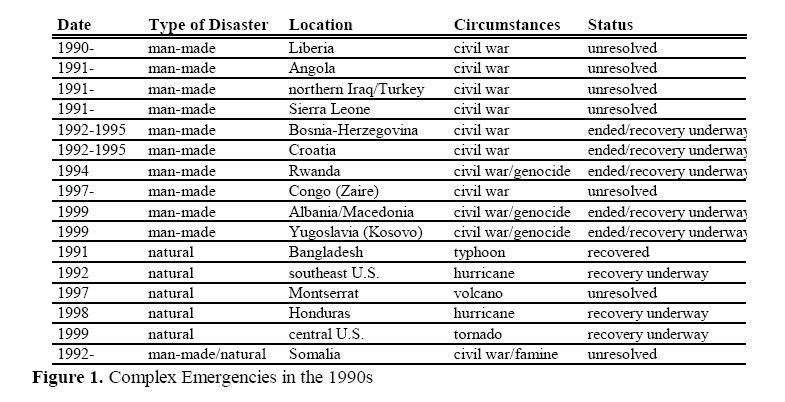
Figure 1. Complex Emergencies in the 1990s 1. Gliders and glider landings dovetail the individual capabilities in parachute drops and helicopter relief flights while minimizing the associated hazards. While parachute drops offer an
alternative to land convoys, the trade-off is vulnerability, as airlift assets are in jeopardy of being shot down, and disorganization as the contents of such drops scatter over the target area. In turn, helicopters integrate precision landings, mobility, and heavy payloads, while trading-off stealth and surprise, as engines and rotor blades disclose the direction of approach and departure, for vulnerability to air defense artillery (ADA) or field artillery fire during loading and unloading. Comparatively speaking, gliders and glider landings prove superior to either technique thanks to several inherent traits.
Stealth and Surprise ‚Ä" In a non-permissive environment, the moment an unarmed cargo plane or helicopter approaches a DZ or LZ is the point where pilots face the greatest danger of being shot down. Ejecting flares during approach or departure to confuse and divert incoming heat-seeking surface-to-air-missiles (SAMs) is the only countermeasure available to a pilot, provided the aircraft has the gear for such a contingency, unlikely for U.N. flights contracted out to third-parties, but these are not 100 percent foolproof. However, successfully concealing a relief flight in transit to the target area can negate the potential for detection and offset the lack of armament for self-defense. Stealth is the key determinant in maintaining total surprise. Without the former, one cannot exploit the latter to its fullest potential. Since a glider‚Ä(tm)s wind-driven propulsion system can maneuver into a gradual or swift descent and has a low metal-content fuselage that does not emit infrared heat its radar signature is negligible. This means it can quietly land without attracting too much attention and is invulnerable to fixed and man-portable SAMs. Hence, these ‚Äúsilent wings‚ÄĚ offer the distinctive characteristic of being the only true ‚Äústealth aircraft,‚ÄĚ whose value enhances the survivability for NGOs undertaking unilateral relief flights, as ;top:5487;left:108">in the case of Mercy Corps International‚Ä(tm)s air drop campaign over Kosovo in the latter stages of Operation Allied Force.
Payload ‚Ä" As a workhorse during the Second World War, gliders served as an immediate force-multiplier for combat units thanks to its payload capacity; an inherent trait useful and necessary for Complex Emergencies. Credit went to its cost-effective heavy-lift design. By all accounts, gliders of that era adhered to the principle of constructing a simple, yet durable aircraft since most had fuselages constructed of air-tight canvas wrapped around welded steel tubes and honey-combed plywood, ‚Äú...a construction technique that provided strength with minimal weight.‚ÄĚ A lack of complicated flight instrumentation and engines meant very little maintenance and kept costs down resulting in a potentially reusable airframe without diminishing, but rather increasing its lift capability. Most had cargo and personnel capacities comparable to every model of transport helicopter (and some heavy cargo aircraft) currently in service throughout the world. Furthermore, the inclusion of hinged cargo doors on the nose or tail assembly kept loading and unloading times to a minimum. Performance ‚Ä" Combat gliders did not yield to the opinion that once separated from its tow aircraft, the entire action necessarily had to unfold according to some predetermined schedule without taking into consideration unforeseen contingencies. Debriefings of personnel who participated in such landings noted that if tow release occurred at an altitude above 700 feet the pilot could ‚Äúmake a proper approach and come in slow,‚ÄĚ an option that afforded him the time to select and divert to an alternate LZ if necessary. Unlike the sports glider though, a fully loaded cargo glider was unable to use atmospheric currents or thermals to remain aloft for a considerable amount of time or even be made to climb due to its weight, construction, and design, all it could do was soar back to earth. However, that glider could execute some exceptional maneuvers to land on target depending on the method of soaring: gliding or diving flight. Perfected by the German Luftwaffe with exceptional results, ‚Äúdive gliding‚ÄĚ produced speeds in excess of 125 miles an hour based upon the angle of descent. If spotted, evading ground fire with this method required deploying a braking parachute and making frequent changes in the diving angle or spinning for a short time which refutes accusations that gliders were ‚Äúcompact targets.‚ÄĚ Furthermore, if release occurred at the right altitude, 13,000 feet, a glider could coast to the target area from as far away as 20 miles before going into the dive.
This radical innovation in tactics is still useful because gliders can execute spot landings in clearings only yards long. In contemporary terms, this means hostile elements bent on shooting down a relief flight as a warning to halt further operations cannot anticipate and identify as easily a glider LZ compared to parachute DZs.
Recyclable ‚Ä" One myth that gave the glider a bad reputation during the Second World War was it had a life expectancy of only one mission. Critics contend that most airborne assaults left the powerless aircraft destroyed beyond repair or unsalvagable. This statement is true as far as those gliders shot down or that skidded to a halt after hitting natural or man-made obstructions. These cases are in the minority the vast majority were recyclable; after-actions reports confirmed most gliders and cargo landed in serviceable condition and few casualties occurred. Other circumstances, all of them preventable, contributed to the myth. First, retrieval of gliders had a low priority due to combat requirements and hundreds sat on secured LZs for several weeks before recovery aircraft or repair teams received permission to enter the area; by then, exposure to the elements had already taken its toll. Just to give an example, 97 percent of the gliders used by American forces in the Normandy landings were left to rot in narrow pastures in which they landed. Second, limited numbers of qualified recovery crews and pick-up equipment proved insufficient for handling the thousands of gliders involved in a major airborne operation. Third, lax security measures around LZs after an operation led to damage by vandals or theft by civilians who chopped up the plywood fuselages for fuel. Fourth, glider pilots whose job it was to help clear the LZs and prep the fuselages for recovery returned to their staging areas in England, in most cases, three days after landing. Finally, because of a wartime economy tooled up for mass output, logisticians found it easier to replace than recover used stocks with new inventory taken right from the production line. Gliders have seen combat in a variety of geographic regions varying in terrain and climate where relief operations are currently underway or may deploy to in the future. Few words are in order to describe the applicability of the glider for deploying in situations deemed as Complex Emergencies on a global scale. Its service record denoted in Figure Two speaks for itself. Historical accounts record gliders participated in some sixteen major and minor airborne operations and thousands of other landings in 14 nations with different terrain and climates. Primarily used for airhead and seizure and linkup operations gliders also took part in missions judged by today‚Ä(tm)s standards as special operations or low-intensity conflict. In some instances, planners favored using the glider for two reasons: first, a conventional ground assault against a fortified objective could cost several thousand casualties before capitulation; and second, objectives located in high-altitudes or outfitted with sound-ranging equipment precluded the use of parachutists. Most troops and equipment landed by glider accomplished their D-Day tasks on schedule. While operational failures were few, those that did occur did so mainly because of poor tactical judgment inconsistent with accepted airborne doctrine.
Countries of these regions are characterized by one or more of the following: Closed Terrain: flat plains, rolling hills, rugged mountains, coastal lowlands, uplands, reclaimed inundated land, glaciers, plateaus, valleys, tundra, deserts, dry, and semi-arid, jungle, fjords, and forests; Climate: temperate, rainy, humid, cloudy, cold, arctic, hot, dry, and tropical monsoon. Take note that the diversity of the terrain and climate listed above also makes the glider suitable for use in the Caribbean and Latin America, North America, the Middle East, Sub-Saharan Africa, Greenland, and Antarctica. ňú-former regional hotspot ∆'-potential regional hotspot v-current regional hotspot ¬Ķ-staging area

Figure 2. Geographic deployment of the glider during the Second World War
3. Adapting the glider to the rigors of Complex Emergencies, demands the merger of proven equipment designs and innovations introduced during the Second World War with technology currently in service to create a truly cost-effective platform. The best course of action for rapidly fielding a humanitarian glider capability is to manufacture and modify off-the- shelf designs from the Second World War for contemporary use. Several Allied and Axis models stand out as candidates for adoption below in Figure Three based on lift capacity and have cargo bay dimensions to accommodate a variety of cargo as well as an assortment of modern wheeled and tracked all-terrain vehicles. The majority of the gliders underwent rigorous field testing and refinement; the payload capabilities are comparable to heavy-lift helicopters and even tactical and strategic transport aircraft at one-tenth or less of the unit cost of either; and, background studies and after-action reports on performance in non-permissive environments exist. Moreover, several of these models, patterned on those used in competitive gliding, ‚Äúhad so-called ‚Äėbreaking points,‚Ä(tm) that is, joints of purposely weak construction, which would break first in crash landings or collisions with natural or artificial obstacles. This method brought about a substantial economy in construction...[and] procurement of spare parts...‚ÄĚ Modification does not entail a massive redesign of the fuselage (unless the intent is to stretch the cargo bay or improve upon aerodynamics, speed, and maneuverability of the airframe to handle the stress of jet-glider tows) rather the uniting of technology from two different historical periods.
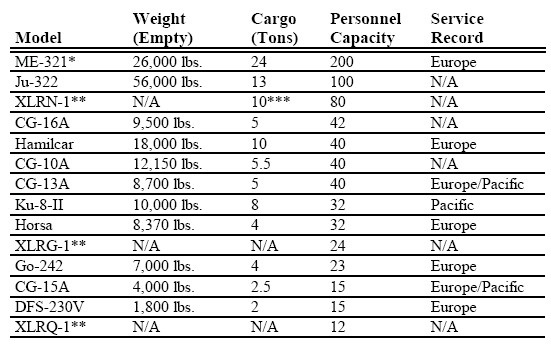
Figure 3. Second World War gliders suitable for contemporary service
Furthermore, Allied and Axis ingenuity pulled off some of the most simple, yet extraordinary innovations in terms of braking systems, crash-protection, an aerial retrieval system, and jet-assisted take-off (JATO) that still has an essential role to play. Whereas portable and compact off-the-shelf technology developed for civilian and defense applications during the Cold War exist that add minimal weight and can be reversed engineered into the fuselage to bridge the gap between those problems solved and those remaining after the military discontinued interest. These include: night vision goggles, global positioning satellite (GPS) receivers, video guidance systems, composite materials, etc. Still, the trick to constructing the gliders within budget at a low-cost per unit and ensuring delivery on schedule is to award all contract and sub-contract work only to companies possessing intimate knowledge on the day-to-day manufacturing process of civilian gliders. The reason is simple. Companies in this field are 50 years ahead of the traditional military-industrial complex in terms of technology and design. Second World War Innovations Braking System ‚Ä" An ad hoc braking system invented by the Germans in 1940 helped achieve a minimal landing distance during operations confined to target areas restricted geographically. Experiments found that barbed wire wrapped beneath the fuselage solved the dilemma. Later adaptations of this method involved the use of a tailhook, (similar to an anchor) burrowing into the earth upon landing. An alternative method the Germans developed for landing on short, unprepared fields involved the installation of automatic braking rockets situated on the nose assembly. The subsequent backwards thrust created by the activation of the rockets allowed a glider to come to a halt on an LZ only 35 yards long. The super-secret "Credible Sport" short take off and landing aircraft conceived for a second rescue attempt of the American hostages in Iran (and its existence only made public 18 years later in 1997) applied the braking rocket idea.
Crash Protection ‚Ä" The ‚ÄúGriswold Nose‚ÄĚ developed in 1943 was a steel battering ram incorporated onto the exterior of a glider‚Ä(tm)s nose. The degree of protection offered by this device allowed the occupants to survive collisions with natural and man-made obstacles with minimum loss of life. Complimenting it was the ‚ÄúCorey Skid‚ÄĚ a curved segment of laminated wood affixed underneath the cockpit that prevented the glider from flipping over during landings on soft terrain and protected the fuselage from punctures. Both proved an effective combination in saving numerous lives during airborne assaults over France, Holland, and Germany. Aerial Retrieval System ‚Ä" Known as the M-80 Glider Pick-Up Mechanism, an aircraft flying overhead could retrieve a fully loaded glider from the stationary position. Mounted to the exterior of an aircraft, the M-80 used the ‚Äúfishing rod and reel‚ÄĚ principle by means of a boom to ensnare the glider‚Ä(tm)s tow line suspended between two poles. Originally used by the U.S. Postal Service in the late 1930s for rural mail pick-up, the M-80 demonstrated its practicability for glider retrieval in both Europe and Asia by medevacing the wounded from the frontlines. JATO‚Ä" A heavy-cargo glider faced a predicament: it demanded sufficient thrust to get airborne as quickly as possible, in some cases, up to 4,000 feet of runway to obtain the necessary speeds for it and the tow aircraft to lift off. The installation of ejectable rocket motors under the wings, a technique also developed by the Germans, provided the necessary thrust at modest g forces (under 2g‚Ä(tm)s) considered acceptable for human tolerance. Modern Innovations Night Vision ‚Ä" What Second World War glider pilots lacked in terms of a night vision capability, they made up with skill, determination, and bravery (not to mention fear) in carrying out exploits in pitch darkness where there was little margin to compensate for errors or ill-fortune. However, through the miniaturization of electronics and enhanced all-weather magnification, the current generation of portable night vision goggles offers a degree of safety and accuracy for executing a twilight landing. GPS ‚Ä" With an array of satellites encircling the globe in various orbits, hand-held receivers can compute exact geographic locations to the nearest meter. In practical terms, this means a safe touch down in a tight LZ. A precision landing GPS system in service with some civilian airports uses a series of fixed antennas installed at a designated LZ which transmits approach coordinates to incoming aircraft with onboard GPS receivers. U.N. military observers or forward air controllers (FACs) outfitted with a portable version of this system could position it before the arrival of GPS-equipped gliders to permit round-the-clock precision landings in any environment and climate. Video Guidance Systems ‚Ä" Used to direct unmanned aerial reconnaissance vehicles, gliders outfitted with similar equipment could serve as a remotely piloted CDS (controlled from the tow aircraft or ground-based FACs). Early NASA space shuttle flight trials proved the idea is feasible: glide tests performed by the shuttle Enterprise in the late 1970s included a ‚Äúhands off‚ÄĚ maneuver with the orbiter on autopilot while it descended from 8,000 to 3,000 feet under the control of a ground-based microwave guidance system. Composite Materials ‚Ä" Light-weight, but hard-wearing tubular components not prone to disintegrating under excessive fatigue and stress (i.e., titanium, used in prosthetic arms and legs, or carbon fiber alloys), would constitute the structural frame of the fuselage. Detachable Kevlar- based bullet-proof body panels or insulation could reinforce the interior at points where personnel and cargo are most vulnerable to small-arms fire. The composition of the exterior components depends upon whether the model of glider selected for service used the traditional canvas on the frame or all-wood method. As mentioned earlier, the failure to immediately recover expended gliders from the battlefield rendered many permanently unusable because the canvas exterior deteriorated in the wind, rain, and humidity. Preventative measures could entail using a synthetic water- and wind-proof material such as Gore-Tex, commonly used in the manufacture of rugged outdoor clothing, to encapsulate the fuselage. Another alternative is to update the design using a fiberglass exterior, as used in contemporary civilian models, which may improve aerodynamics with less weight.
Crash Protection ‚Ä" To overcome the shock of landing, a cargo-restraint system developed for the "Credible Sport" aircraft should be given consideration for inclusion as a standard feature. Intended for a compliment of 150 passengers, this special pallet incorporated aft-facing seats that would give ‚Äúimpact support‚ÄĚ rated at 9g‚Ä(tm)s on touch down. Adapting this system to those gliders mentioned above for possible reintroduction would improve upon passenger survivability and comfort during aerial retrieval.
Other Features: A wide range of portable add-on options is feasible: commercial air bags, bulletproof plexiglas, drag parachutes, and inflatable flotation devices to enable emergency amphibious landings.
Other Advantages From several vantage points, beneficial side-effects are thus obtainable with the introduction of the glider. As an effective and cheaper alternative to contracting out multi-million dollar helicopter and cargo planes, gliders would pay dividends in the form of lower annual fuel and maintenance expenditures as U.N. budget allocations decrease. If you refer to the comparison in Figure Four, adopting an off-the-shelf design such as the German ME-321 that had a payload capacity exceeding the C-130H/J cargo aircraft means the latter could tow two or three of the former in a single sortie (400 to 600 aid workers or 48 to 72 tons of supplies) thanks to its light-weight construction. If the C-17, C-141B, or C-5B serves as the accompanying tow aircraft, the greater engine thrust of these jet transports could possibly convey more than three ME-321s at once, thereby multiplying the overall lift capability while halving the financial outlay. Jet-glider tow combinations have yet to be verified with military versions, but the Space Shuttle, which is also part glider, did conduct trials. From August to October 1977, the Space Shuttle Enterprise conducted five free flight tests with glide release occurring from atop a Boeing 747 at altitudes ranging from 17,000 to 24,000 feet and executing turns under no power.

Figure 4. ME-321/C-130H comparative data
Furthermore, glider familiarization training for UNHCR and NGO personnel should cost little since instruction deals primarily with the procedures of bracing oneself for a landing. In addition, there are ample numbers of glider pilots worldwide who pursue soaring as a competitive sport and could be contracted out to serve with a mission. These individuals are an adventurous lot and may find the prospects of employment for what they do best in a hazardous environment tempting; there would be little doubt over their skill and training since the U.N. would get the best in the field. During the Second World War, soaring champion John Robinson assisted the U.S. Army Air Corps in writing the 30-hour instructional course that trained the initial cadre of glider pilots and became the standard for every one of the 6,000 recruits graduated from the program.
In a Class by Itself
Whether in single or tandem tows gliders can be pre-stocked and prepositioned, something cargo aircraft or helicopters cannot duplicate. Low cost per unit makes this possible. This requires a more detailed explanation. The sole function of transport aircraft and helicopters is to load, shuttle, and unload personnel and material. With multi-million dollar price tags paid for courtesy of the taxpayer, both cannot loiter for any length of time on the ground as "hangar queens." Thus, neither can serve as a pre-stocked and prepositioned cache for either payload because both are high-priority platforms requisitioned and deployed on a daily basis in a variety of support roles that overtax a finite fleet with a different cargo manifest for each sortie. Delivering aid by an intercontinental or intra-theater airbridge in the initial stages of a Complex Emergency therefore demands preparation of detailed aircraft movement and loading timetables by the contributing country that owns the transports. These plans must further take into account the transit time for sufficient airlifters to arrive from various points of origins. Though pre-rigged equipment pallets facilitate a rapid response, it takes time to properly load an airlifter in a configuration that efficiently makes maximum use of the entire cargo bay. Furthermore, if discrepancies in the flight manifest exist unforeseen delays may arise and the airlifter may not ready be for immediate loading ‚Ä" again, a time consuming process, especially when coordinating responsibilities between countries that do not share a common language. Thought should be given to the establishment of regionally-prepositioned, self-deployable "emergency response packages" or ERPs, containing several hundred pre-stocked heavy-, medium-, and general-purpose gliders. ERPs would be co-located on property covering many acres that has support infrastructure (runways, hangars, and control towers) already in place such as derelict air force bases (AFBs); an initiative that may find acceptance with nations experiencing military downsizing and soliciting investment proposals for the reutilization of these facilities.
This would go along way in reducing the pressure on overcrowded active AFBs and allow for the concentration of combat aircraft where and when needed in an emergency. Allied Force illustrated this problem when the U.S. Air Force could not locate idle bases in the Balkans to serve as reinforcement holding units for newly deployed fighter and bomber wings. Though, until perspective host nations tabled a formal memorandum of intent to earmark such facilities, active NATO or U.S. air bases would have to do in the interim. Figures Five and Six represent select AFBs suitable as homes for ERPs distributed on an international and domestic basis by region.
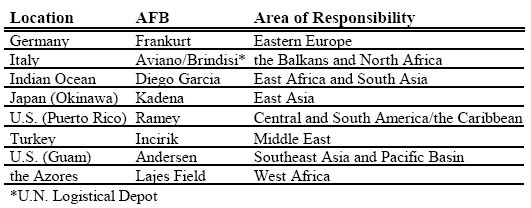
Figure 5. Potential sites for ERPs configured to international complex emergencies

Figure 6. Potential sites for ERPs configured to domestic complex emergencies, U.S. as model Housed in hardened temperature-controlled hangars next to the runway ready to deploy each glider in an ERP would contain a minimum of 10 to 24 tons of one or more of the following: Meals Ready to Eat (MREs) or Humanitarian Daily Rations (HDRs), medical kits, tents, plastic bedding mats, blankets, bottled water, generators, and cold-weather clothing.
Empty gliders would also be set aside for to ferry aid workers. To handle and contain single or multiple crises (a maximum of one major and two minor) in a region, ERPs would contain on-site at least 36,000 tons of food, enough to feed a maximum of 500,000 people for 90 days; comparable stockpiles of supplies would augment this total. Days, if not weeks, could be shaved off the estimated time of arrival of aid in-theater via this method because pre-stocked gliders eliminate the proverbial middleman ‚Ä" the loadmaster ‚Ä" from the planning cycle. UNHCR logisticians no longer have to consider, ‚Äúhow many hours to pack the goods,‚ÄĚ rather, ‚Äúhow many tow aircraft can an airbase logistically support, receive, and launch at A complex emergency scenario involving an ERP would look something like this. At the onset of a crisis, support trucks would preposition the gliders next to the flight line according to a pre-determined layout either functional or organizational. UNHCR and NGO personnel would marshal at a holding area and marry up with their designated gliders. As tow aircraft land, each would taxi up to an assigned serial of gliders where technicians would fasten and inspect the tow cables and then transit to the flight line for departure, a procedure that should last no longer than one to two hours on the ground, unless the tugs need to refuel. Once airborne, the glider convoy would proceed to a release point conducive towards safeguarding powered airlift assets from unnecessary risk and enhancing a rapid reaction response. Since glider release can occur a significant distance away from the target area, a reduced threat exists from hostile ADA or fighter interceptors across an unfriendly border, as air traffic controllers may never pick up the tow aircraft‚Ä(tm)s radar signature. The advantage of a distant release also means fuel consumption is minimal and the tow aircraft can return to its staging area earlier to linkup with the next set of gliders already prepped for follow-on landings. Under its own control, the ERPs would glide to and land in areas typical for DPs to gather: remote border sites or deep into an interior where road networks are beyond repair, inadequate, or non-existent; selection of the LZ coordinates would be determined by DP congregation patterns identified using remote sensing imagery. After unloading is complete, the UNHCR and NGOs could turn the fuselages over to DPs as temporary shelters until retrieved or depending on on-site circumstances (infectious diseases or the need for fuel) burn the glider; again, simple components and low-cost per unit make this possible. Follow-on glider landings ‚Ä" ‚Äúemergency support packages‚ÄĚ or ESPs ‚Ä" would deploy workshops, field kitchens, mobile army surgical hospitals (with the fuselages serving as a makeshift surgery or recovery ward), and sanitation and water purification teams to construct permanent DP camps. For DPs in need of specialized medical care, evacuations by glider are possible by aerial retrieval.
Once the situation on the ground has stabilized and aid starts flowing from rehabilitated port, rail, and airfield facilities, the gliders can be retrieved, restocked, and repositioned for the next crisis. One recovery aircraft can retrieve multiple gliders in a single sortie, due to the latter having an inherent light-weight fuselage stripped of intricate avionics, engines, extensive wiring, fuel, oil, and lubricants. By daisy-chaining the gliders together, like a computer network, with high-tension cable the recovery aircraft can swoop down and snatch the ‚Äúglider train.‚ÄĚ As this airborne convoy approaches an airfield, the recovery aircraft would make separate passes to allow each glider pilot to initiate release and land. Since a glider requires fewer man-hours for assembly and routine upkeep, diagnostic tests and preventative maintenance would stress certifying the structural integrity of the fuselage as airworthy before its next deployment.
Costs for ERPs could be minimized if undertaken as a joint project with the U.N. (procuring the gliders) and say, the U.S. Department of Department (donating or leasing the airbase) and NGOs or other international organizations purchasing the materials to pre-stock the gliders and providing the pilots to maintain and fly them. The establishment of ERPs could also lead to better coordination among aid groups (to prevent overlapping) in doling out tasks if detailed contingency plans developed before the outbreak of a crisis spell out what organizations are paired up with what serial of gliders; their order of departure; and, their assigned responsibility once on the ground: surveying and marking out camp perimeters, building temporary infrastructure, in-processing DPs, medical attention, food distribution, and sanitation.
Other Useful Roles
Though the focus of this paper has dealt with the use of the glider for Complex Emergencies it can handle a wide spectrum of contingencies defined as OOTW. Peacekeeping/Non-Combatant Evacuation (NEO) ‚Ä" In support of North Atlantic Treaty Organization (NATO) and U.N.-sponsored operations, glider landings and retrievals can quietly reinforce, resupply, rotate, or evacuate contingents besieged in an enclave without alerting the warring factions or subjecting overland convoys to sectarian fighting, bureaucratic entanglements, ambushes, hijackings, mines, checkpoints, or its passengers becoming human shields. Gliders played a similar tactical and strategic role in the Second World War for reinforcing and evacuating besieged garrisons, American and German. Bearing this in mind, incidents of genocide in Srebrenica and Zepa may have been thwarted had the United Nations Protection Force (UNPROFOR) Commander had an ace up his sleeve, unbeknownst to the Bosnian Serb Army, for secretly reinforcing these and other U.N.-designated safe-areas. Still, if UNPROFOR‚Ä(tm)s position became untenable, ‚Äúblack‚ÄĚ gliders could have landed at night and evacuated by aerial retrieval the most isolated or threatened contingents (and civilians in danger) as well as recover sensitive equipment. To do otherwise, NATO forces would have been hard-pressed to successfully conduct a NEO of the 24,000 peacekeepers scattered throughout Bosnia-Herzegovina through traditional points of entry and departure: ports, ;top:16015;left:108">airfields, and frontier crossings, a scenario that was on the desks of contingency planners in 1995. As a former UNPROFOR intelligence section chief related to the author: The ugly little open secret was that such an operation could not have been conducted...without leaving behind major end items of equipment ‚Ä" something none of our major allies was willing to do...The population as well as the government always took careful note of UNPROFOR troop movements and would quickly have realized if something out of the ordinary had been planned...The Bosniacs, I am quite certain, were prepared to stage demonstrations in front of U.N. compounds or along routes...Obviously, UNPROFOR/NATO troops would have been forced to physically remove the civilian demonstrators...It would have been too difficult for the force to get in ‚Ä" let alone help UNPROFOR fight its way out. Imagine a [river] crossing operation being conducted under [winter] combat conditions...The British and French would have been forced to send their reinforcement units through the Bosnian Dinaric Alps [from the ports of] Split and Ploce to reach...Sarajevo.
Arms Control and Monitoring and Verification ‚Ä" Instead of relying on aircraft and helicopters provided by the host nation under investigation for transportation quick response teams of weapons, border, election, and human rights monitors deployed by glider could arrive without delay or hassles. The use of double or triple tows by a single aircraft, (also furnished by the U.N.) can facilitate the landing of teams at multiple sites to conduct surprise or scheduled on- site inspections. The stealth of the glider also offers the possibility these teams could catch a nation without warning in the act of covering up evidence of weapons of mass destruction or ethnic cleansing; this inherent trait would have given the U.N. or the Organization for Security and Cooperation in Europe the capability to slip a clandestine survey team from the International War Crimes Tribunal into Kosovo to document atrocities and contact internal DPs right under the nose of the Serb internal security apparatus if necessary.
Biological and Chemical Terrorism ‚Ä" Pre-stocked with vehicle and individual detection and decontamination kits, gliders could offer civilian and military special response teams the opportunity to land in urban or rural areas suspected of undergoing a chemical attack and inoculate and give first aid to casualties. Planners do not have to give thought to decontaminating the fuselage upon completion of the task: again, low-cost per unit makes it disposable and can be burned on the spot ‚Ä" an economic benefit not afforded to transport planes or helicopters.
Hostage Rescues/Prisoner Snatches ‚Ä" A soundless, low-level glider approach in hostile airspace, especially in a nighttime operation, can inflict a state of paralysis and psychological shock, including paranoia, upon an adversary‚Ä(tm)s economic, social, military, and political infrastructure. For example, in the motion picture, Escape from New York, the protagonist infiltrates his objective by landing a miniature glider ‚Ä" the ‚ÄúGullfire‚ÄĚ ‚Ä" atop the World Trade Center in an attempt to rescue the President. Fictional as this account is, more plausible scenarios are possible based on historical fact: the rescue of Italian fascist dictator Benito Mussolini and the attempted capture of Yugoslav partisan leader Josef Broz Tito. In modern day terms this means special operation forces (SOFs) could swoop down on the safe-houses of indicted war criminals, like Radovan Karazdic, Ratko Mladic, and Slobodan Milosevic whose bodyguard would be caught off balance by such an assault, and apprehend them. Civilian casualties and collateral damage would be limited and the media reaction favorable, unlike the NATO Stabilization Force's run-in with a low-level Serb suspect in July 1997 that ended in a botched arrest on a street corner with the individual shot dead. Without overemphasizing the point too much, had the glider served as the platform of choice for similar scenarios involving SOFs (Iran, Panama, and Somalia) the final tally in casualties for each operation may have been different.
Conclusion: Any Takers? One final thought comes to mind. If gliders have a purpose in supporting Complex Emergencies and OOTW someone would have already thought of it? The answer to such a question comes down to a disclosure made by American army officer in 1943 assigned to the command responsible for conducting field trials on the glider. His remark is telling and still accurate: ‚Äú...one of our basic troubles has been the failure to properly evaluate this new weapon from the topside down.‚ÄĚ This disclosure explains why the glider is perhaps the only category of equipment in modern military history discarded after an exceptional combat record overseas. Though to reiterate, there are still worthwhile roles for the glider should the international community, whether collectively or individually, wish to rethink the utility of these silent wings for use in the next millennium. Remember, it is fashionable these days to go ‚Äúretro‚ÄĚ and acquire the accouterments of an earlier, in some ways, more imaginative era for contemporary use and some countries appear to be drawing that conclusion too.
Windows of opportunity like this always demand two participants: a master and an apprentice. The master is the visionary who opens his or her mind to an object's potential while the apprentice must come full circle before doing the same. When you consider the problem of the UNHCR and NGOs continuing to rely on expensive and ineffective means of delivering aid while operations and maintenance accounts dwindle and Complex Emergencies multiply the usefulness of exploiting the glider becomes clear.
Steven Torrisi is a freelance military analyst who has worked in the past for the Lester B. Pearson Canadian International Peacekeeping Training Center (PPC) and the Institute for Defense and Disarmament Studies (IDDS). While at the PPC, he served as an Assistant Associate Editor of Peacekeeping and International Relations and participated in Spirited Flight ‚Äė98, a NATO CPX. He is also co-editor of the book Eyewitnesses to Peace ‚Ä" Letters from Canadian Peacekeepers. During his time at the IDDS he analyzed the potential export market for tanks for a conference sponsored by the Brookings Institute. Mr. Torrisi holds an MA in International Relations from United States International University and a BA in History from Monmouth University.
Notes
Normally,‚ÄĚ according to defense journalist Francis Tusa: prolonged truck convoys ‚Ä" whose speed is set for the slowest vehicle ‚Ä" move at about 20km per hour, with a stop of 10 minutes per hour and a rest period of 1 hour after every 4 of travel. On this basis [in Bosnia], movement from Saravejo [along poorly maintained winding roads] to [the port of] Ploce [a distance of some 126 miles] would take of about 17 hours; Tuzla to the coast [about 294 miles], 30 hours. Tusa‚Ä(tm)s calculation was without taking into other considerations that delay or complicate humanitarian aid deliveries: occupying and securing port, rail, and air facilities or traversing routes held or contested by regular or paramilitary units belonging to or allied with the warring factions. The occupation of and standoff at Pristina Airport, the only airport in Kosovo, by Russian troops illustrated this problem; until recently, the UNHCR has had to exclusively rely on road-bound aid convoys; in Bosnia, this method accounted for nearly 75 percent of all aid deliveries. Attempts by to secure land routes can quickly bog down a relief effort, even with the assistance of armed peacekeepers. In 1993, UNPROFOR undertook Operation Lifeline to secure a proposed convoy route from the UNHCR warehouse in Metkovic on the coast through to the Muslim-controlled interior. Refusing to grant a safe conduct pass, the paramilitary Croatian Defense Council (HVO) blew up two bridges along the route near the city of Mostar. Twenty-four after UNPROFOR engineers repaired the span of one of the bridges, the HVO again sank it. See Francis Tusa, Haunted by Past Retreats, Armed Forces Journal International, October 1995, p. 27. General Accounting Office, Humanitarian Intervention: Effectiveness of U.N. Operations in Bosnia, GAO/NSIAD-94-156BR, (Washington D.C.: GAO, April 1994), pp. 18, 26.
The glider traces its origins to Greek fable of Daedalus and his son Icarus. According to legend, King ;top:18583;left:108">Minos imprisoned father and son in a labyrinth on the isle of Crete. Having secretly fashioned wings made out feathers and wax Daedalus and Icarus escaped their imprisonment by gliding over the prison wall. Captivated by the experience of flight, Icarus ignored his father‚Ä(tm)s advice to soar low over the water until they reached safety in Sicily. Instead, Icarus flew higher until the temperature of the Sun melted his wings, and plunged into the sea and drowned. Attempting to turn myth in reality, successive generations of proverbial Daedaluses determined to fly instead went to their deaths. Several centuries passed before Leonardo Da Vinci‚Ä(tm)s detailed anatomical studies of humans and birds confirmed the futility of man‚Ä(tm)s earlier attempts to fly vis-a-vis arm-powered wing-flapping mechanisms. Compensating for the inadequacies attributed to the human physique, Da Vinci conceived of a flying wing incorporating a system of cables and pulleys to harness the kinetic energy derived from briskly moving the arms and legs; modern-day hang gliders are nothing more than derivatives of these sketches. Gerald M. Devlin, Silent Wings, (New York: St. Martin‚Ä(tm)s Press, 1985), pp. 1-2.
German inventor Otto Lilienthal turned Da Vinci's theory into reality four centuries later as he flew a single-wing glider off a Berlin hillside in 1891. A mechanical engineer by trade, Lilienthal had earlier published Bird Flight as the Basis of Aviation, a culmination of 10 years of research which essentially upheld Da Vinci‚Ä(tm)s findings. Over the next several years, Lilienthal carried out 2,000 glides in a vision quest, that ultimately cost him his life, to duplicate the dexterity of a bird; constant refinements in design gradually extended flight time, distance, and altitude. Further experimentation discovered that an individual could effect turning maneuvers using the prevailing winds as propulsion if one shifted their weight in the direction they wished to travel. Ibid., p. 4 Ibid. p. 16.
Specifications required the glider must land a combat-ready formation or cargo on short, uncultivated fields no longer than 75 yards, and unit cost must not exceed 7,500 Reich Marks; the equivalent of manufacturing 10 parachutes. Milton Dank, The Glider Gang, (New York: J.B. Lippincott Company, 1977), p. 22.
This force numbering less than a hundred captured a force ten times it size within a period of three hours; estimates for taking the fortress by a ground assault predicted a six-month siege costing 6,000 casualties before capitulation.
By 1946, the U.S. Army disbanded eight of 11 glider infantry regiments, a separate glider infantry battalion, and seven of 11 glider field artillery battalions. The U.S. War Assets Administration declared gliders surplus and the public immediately purchased all excess stocks for $75 each, (original unit cost: $15-25,000) not for the aircraft itself but for the lumber content in its five shipping crates enough to build a small ranch-style house. In post-war Great Britain, the Glider Pilot Regiment, after returning from occupation duty in Palestine, saw its strength decrease to only a headquarters and training squadron plus two tactical squadrons. By 1950, a single squadron remained, and the Royal Air Force (RAF) discontinued new intakes of pilots; a year later it abandoned the program and reassigned crews to powered aviation units. Not until 1957 did the British Army officially disband the regiment. Devlin, op. cit., pp. 374-375. Shelby L. Stanton, World War II Order of Battle, (New York: Galahad Books, 1991), various pages.
High-velocity drops means what it says. U.S. Army regulations for this method specify building for each bundle a CDS designed to survive a high-speed impact. One configuration for packing foodstuffs suggests using some lightweight foods to cushion other heavier foods. For example, six layers of MREs or HDRs are placed on the bottom followed by one layer of canned meat, and then one layer of biscuits placed on top. All eight layers are packed on a shipping pallet (with a base consisting of a three-quarter to one-inch board of plywood wrapped in five layers of energy-absorbing material (cardboard honeycomb)) and held together by plastic wrap. It is then placed in a cargo bag rigged with a stabilizing parachute. Trimming the edges of parachute canopies can reduce drag at high-altitudes and permit cargo pallets to float directly downward. Using this method in Bosnia permitted an average of 85 percent of the bundles to land within a mile of the target, yet civilians still faced the danger of ambush and injury as they made their way to the drop zone (DZ). A free drop is a descriptive term, and a makeshift alternative, for showering single packets of foodstuffs upon population centers without the use of parachutes or energy-absorbing materials. It entails placing 40 individual boxes of MREs or HDRs in a large cardboard box pre-cut at stress points (to weaken its load bearing capacity) and held together by webbing. As the box exits the cargo bay in flight a static line attached to the lengths of the webbing elongates and the ties break as the box hits the stream of air driven aft by the propellers causing it to break apart and scatter the contents to the ground. There are drawbacks despite being inexpensive: free drops can deliver only 480 foodstuffs in each CDS compared to 768 for a high-velocity drop. Furthermore, this method could spark a riot in the streets as people fight for every individual packet that lands or if residents claim ownership for all packets that fall on their property, especially if that property covers several acres, as is the case in many rural farms. Also, a percentage may never reach the intended recipients if soil (sand and dirt) and dense terrain features (mountains and forests) camouflage a packet the size of an eight-and-a-half by eleven piece of paper made of dark brown (MREs) or tan/yellow (HDRs) plastic wrapping. See Captain Brian L. Williams, CW3 Ken K. Studer, and CW2 Nancy E. Studer ‚ÄúOperation Provide Promise: The Airdrop Phase,‚ÄĚ Quartermaster Professional Bulletin, Autumn 1993. Captain Stephen R. Davis, ‚ÄúEmerging Technology in Airdrop Operations,‚ÄĚ Quartermaster Professional Bulletin, Autumn 1997. Obtained electronically from www.lee.army.mil/quartermaster.
Another alternative, the low-altitude parachute extraction system is no better as it subjects delicate equipment and supplies to damage or destruction from the suction produced when pulled out of a cargo aircraft moving hundreds of miles per hour. Furthermore, this hazardous maneuver puts a multi-million dollar aircraft in danger of crashing if not properly executed in a non-permissive environment.
The recent emergency airdrop of anti-cancer drugs to a scientist temporarily stranded at the Amundsen- Scott South Pole Station would have been an ideal setting for using cargo gliders in a life-threatening situation. James E. Mrazek, The Glider War, (London: Robert Hale & Company, 1973), p. 231.
Debriefing Conference ‚Ä" Operation Neptune, August 1944, p. 9. Obtained electronically from the U.S. Army Military History Institute Digital Library at http://carlisle-www.army.mil/cgi-bin/usamhi/DL/showdoc.pl? docnum=32. Military gliders had a 1:10 glide ratio compared to 1:22 for its civilian counterpart during the Second World War; in free flight, this meant that for every 10 feet the glider flew forward its altitude decreased by a foot. James E. Mrazek, Fighting Gliders of World War II, (London: Robert Hale & Company, 1977), p. 24.
The Luftwaffe‚Ä(tm)s first (and only) experiment of this tactic in combat occurred on the Russian Front in 1943 when a dive-glider assault on the besieged citadel of Velikye Luki safely delivered seven anti-tank guns inside its perimeter. Airborne Operations - A German Appraisal, Pub 104-13, (Washington D.C: Center for Military History, 1989), p. 53. Glider serial post-landing tables from the after-action report for the 82nd Airborne Division during Operation Market-Garden "the airborne invasion of Holland" noted the following landing statistics: Gliders: 155 used, 98 intact, 31 damaged, 11 destroyed, and 15 missing; Personnel: 1,153 okay, one killed, 12 wounded, and 75 missing; Jeeps: 27 serviceable, 15 unserviceable; Trailers: 17 serviceable, 7 unserviceable; Artillery pieces: 13 serviceable, four unserviceable. Mrazek, The Glider War, op. cit., pp. 293-294. Appendix: Table B, C, D, and E. Ibid., pp. 159-160. Of all the locations, Burma is perhaps the best example for illustrating the flexibility of the glider in a role commensurate with the requirements of Complex Emergencies. Under Operation Thursday, carried out in 1944, gliders assigned to the 1st Air Commando Group landed engineers and almost 67,000 pounds of construction equipment 165 miles behind Japanese lines at night. Within 24 hours, the engineers began erecting a forward airfield in the jungle with a 5,000-foot runway and medevaced the wounded to India by aerial retrieval. One least known, but noteworthy accomplishment from this forgotten theater, that echoes with overtones for contemporary application involved the ferrying of 2,216 pack mules and horses by glider; records indicate most were docile passengers, very few had to be shot by handlers in flight ‚Ä" a safety precaution in case any tried to kick the fuselage apart. In similar fashion, farm animals can be landed to repopulate flocks decimated by those characteristics associated with a Complex Emergency: weather, famine, plague, and war. There is one ignominious stain upon its service record for an event in July 1944 reminiscent of ethnic cleansing. Located at the foothills of the French Alps, the village of Vassieux served as an important hub for clandestine airdrops to the Resistance on the plateau of Vercors in southern France. A preemptive glider raid by Waffen-SS troops used scorched earth tactics to raze the village and wipe out its civilian inhabitants. Successive landings nearby did the same to other communities in an effort to neutralize Resistance groups, and their civilian base of support, poised to ambush the German 19th Army in the event of an Allied airborne and amphibious landing along the French Riviera. Mrazek, The Glider War, op. cit., pp. 110-28. Devlin, op.cit., pp. 141, 386. James Lucas, The Last Year of the German Army, (London: Arms and Armor Press, 1994), pp. 150- 154. Mrazek, The Glider War, op.cit., p. 268. Terrain and climate data from the Central Intelligence Agency World Factbook 1991-1992, (Washington D.C.: Brassey's, 1993), various pages. Airborne Operations - A German Appraisal, op.cit., p. 12. Mrazek, Fighting Gliders of World War II, op.cit., various pages. This test-bed design intended for landing in a Tehran soccer stadium made use of a modified C-130 Hercules transport aircraft incorporating anti-submarine and air-to-air missile rocket motors positioned around the cockpit and under the wings to halt the aircraft. Nick Cook, "How 'Credible Sport' made SuperStol a reality," Jane's Defense Weekly, 9 March 1997, p. 18. Airborne Operations - A German Appraisal, op. cit., p 53. Devlin, op. cit., pp. 125-126. Ibid., p. 116. "Precision landing by GPS set for take-off," Jane's Defense Weekly, 12 June 1996, p. 41. Kenneth Gatland, Space Technology, (New York: Harmony Books, 1981), p. 278.
Cook, op. cit., p. 21.
Soviet experiments in the early 1930s perfected the concept of the "glider train," for which it set a record by towing four gliders in a sausage-link configuration. Mrazek, The Glider War, op.cit., pp. 231-234. Gatland, op.cit., p. 278.
The were plans for a larger version of the ME-321 with a 60- to 70-ton cargo capacity but these never got off the drawing board. Aircraft data from Tom Clancy, Airborne: A Guided Tour of an Airborne Task Force, (New York: Berkley Books, 1997), p. 161. Mrazek, The Glider War, op.cit., p. 36.
Another enhancement that can financially pay off for the UNHCR as well as NGOs is to do what the British Glider Pilot Regiment did when it lacked adequate support personnel to assemble gliders: cross-train the pilots as mechanics. Ibid., p. 85. For the hangars to accommodate the quantities of gliders envisioned in this scheme, space-saving technology such as folding components would have to be incorporated into the fuselage. Between one-sixth to one-third of the total stockpile ‚Ä" 6-12,000 tons ‚Ä" the equivalent of 250 to 500 fully loaded ME-321s ‚Ä" would be pre-stocked and ready for instantaneous deployment. The food calculation is based on U.S. military figures for MREs/HDRs prepositioned in the Balkans prior to the Albanian diaspora from Kosovo. Figures obtained electronically at www.fas.org/man/dod-101/ops/sustain_hope.htm
Operation Turkey Buzzard conducted during the Second World War already validated the feasibility of an intercontinental or intra-theater glider airbridge depicted in the scenario above. Conceived by the RAF Air Transport Command in 1943 the plan entailed towing a manned glider loaded with vaccines destined for Russia, and, aircraft, radio, and engine parts from Canada to England, a distance of some 3,500-miles. The success of this five-leg, 28-hour experimental flight turned the theory of a transatlantic glider ‚Äútrain‚ÄĚ service into reality as a tactical and strategic alternative to moving men and material by naval convoys. With the success of Turkey Buzzard the RAF went on to tow 30 Horsa gliders from England to Tunisia a record-setting distance of 2,400 miles with just one stopover. Dick Illingworth, ‚ÄúThe Angle of the Dangle,‚ÄĚ Airforce, January 1996, pp. 14-15. Mrazek, The Glider War, op.cit., pp. 267-268.
A 1994 Newsweek article recounted an interesting anecdote of an overland journey by the Danes to reinforce a U.N. enclave in Bosnia in October 1993: 11 Leopard [medium] battle tanks...set off from Denmark...to the besieged town of Tuzla where a Nordic U.N. battalion was trying to secure the airport; Serbian leaders had given their OK. But once the 45-ton tanks crossed over into the former Yugoslavia, the Serbs reneged and demanded $1 million for road repairs and customs fees. ‚ÄúAnd we were stupid enough to pay,‚ÄĚ says a Norwegian logistical officer involved in the tank deployment. Instead of heading to Bosnia, the tanks were forced to a U.N. supply depot outside Belgrade. There they stayed for 97 days, hostage to the Serbian bureaucracy. Finally, the blue helmets gave up and proceeded on what is being called "The Long March" a retreat by train out of Serbia through Hungary, Austria, and Italy. From there a cargo ship hired by the British took the tanks down the Croatian coast to Split. See Tom Post, et.al., ‚ÄúBlues for the Blue Helmets,‚ÄĚ Newsweek, 7 February 1994, p. 22.
Operation Repulse organized in the midst of the 1944 German winter Ardennes offensive due to a lack of parachute containers and para-packing units in the European Theater of Operations, ferried by glider a replacement field hospital accompanied by four surgeons to the American 101st Airborne Division encircled at Bastogne. The initial serial of 11 gliders landed inconspicuously and unscathed within this tight defensive pocket; subsequent waves had to evade flak from anti-aircraft artillery. Although least known of the contributions towards ending the siege, Repulse resupplied the 101st with 106,291 pounds of cargo at a decisive point in time when surrender was the only other alternative. The Germans mounted similar relief efforts on the Russian Front. At the siege of Kholm in January 1942, cargo gliders landed on the frontlines to deliver ammunition and equipment to its 3,500 defenders; as the pocket shrank, village streets literally turned into LZs. Moreover, as German control of the Russian and Balkan Fronts receded during late 1943 through 1944, gliders helped evacuated men and material from the Crimea, Sardinia, Corsica, Rhodes, Crete, and Greece. Mrazek, The Glider War, op.cit., pp. 224-229,261.
An earlier U.N. supervised withdrawal from Srebrenica in April 1993 turned tragic when deficient planning failed to provide adequate logistics for the withdrawal of several hundred DPs. Consequently, the evacuation degenerated into a melee as DPs rushed for the minimal allotments of space available in the convoy, crushing to death some of their fellow citizens. Major Brian R. Layer, Some Principles of Convoy Operations in Operations Other Than War, First Term AY-93-94, (Fort Leavenworth, Kansas: School of Advanced Military Studies-United States Army Command and General Staff College, 17 December 1993), p. 11. Lieutenant-Colonel John Sray, USA to Steven A. Torrisi, 7 February 1996. Correspondence in the possession of the author.
Operation Bunghole proved in 1944 such clandestine operations feasible when gliders were the first Allied aircraft to land on Yugoslav soil since the 1941 invasion and accomplished what propeller-driven aircraft failed to do: deposit the Soviet Military Mission seconded to Tito in German-occupied territory. The rendezvous point for this was a snow-blanketed valley located 100 miles inland at the foothills of the Dinaric Alps between Sarajevo and Zagreb. Hazardous meteorological conditions plagued the insertion force of three gliders as it approached the Dalmatian coast at an altitude of 8,000 feet. Geographic landmarks and partisan signal fires though, recognized upon tow release some five miles from the objective, permitted the pilots to plot their landing trajectory and pin-point the location of the target area, located 4,000 feet above sea level. The presence of three feet of soft snow at that altitude enabled the gliders to rapidly decelerate on an LZ reported to be only 20 feet in length. Operation Freshman, attempted in Norway in 1942 involved landing commandos to attack the Norsk Hydro Plant in southern Norway to terminate its production of heavy-water, a necessary component in atomic weapons research. Heavy snowstorms, an inoperable navigation beacon, mistaken LZs, and ice on the wings was responsible for wrecking the sabotage force of two gliders. On orders from Hitler the SS summarily executed the survivors. Though ending in tragedy, it lends credence to the fact there is also a role for the glider, a peaceful one, with inspectors from the International Atomic Energy Commission. Mrazek, The Glider War, op.cit., p. 271. Mussolini's 1943 rescue, Operation Oak, from the Campo Imperatore Hotel atop the summit of the Gran Sasso located in the Abbruzzi Mountains of central Italy is a textbook example of the versatility of a glider. Otto Skorzeny, Hitler's unconventional warfare expert, undertook the assignment of freeing the fascist dictator from house arrest. Ruling a frontal assault out of the question since a cable car controlled access from the valley below to the crest and the altitude precluded a parachute drop Skorzeny opted for a glider assault. Despite four out of 12 glider tow lines prematurely releasing en route and Skorzeny altering the choice of the LZ on approach when the flat alpine meadow turned out to be a ski run, his commandos landed 15 to 20 yards from the resort‚Ä(tm)s entrance. The entire rescue took less than four minutes and resistance was non-existent from the 250 surprised Italian Carabineri (police) billeted in the hotel. James Lucas, Kommando-German Special Forces of World War II, (New York: St. Martin‚Ä(tm)s Press, 1985), pp. 99-100. In terms of the caliber of troops involved and the meticulous detail in its planning, Operation Knights Move, the 1944 Nazi plan for snatching Tito from his mountain stronghold in western Bosnia-Herzegovina was as one appraisal phrased it, a surgical strike of ‚Äúsuperior grade.‚ÄĚ Intending to quietly swoop down on the mouth of Tito‚Ä(tm)s cave headquarters in the Drvar Valley two companies of Waffen-SS glider infantry instead found themselves in the middle of ambush sprung upon landing. Historical accounts attest the Luftwaffe is to blame for this compromise in operational security. Earlier, the Luftwaffe advertised the impending assault by dropping two companies of parachutists to seize and cordon off a nearby village to thwart partisan interference with the gliders scheduled to arrive in the second wave. This tactical error in judgment permitted the mobile partisans to preempt the glider landings with delaying tactics as Tito escaped unmolested. Ibid., pp. 103-26.
SFOR Joint Press Conference Transcript Sarajevo, 11 July 1997, (Belgium: North Atlantic Treaty Organization). Obtained electronically from www.nato.int.
Operation Eagle Claw, (1980-Iran) The disaster at Desert One that killed eight U.S. servicemen did not have to happen had SOFs staged a series of glider landings at a remote location on the Turkish-Iranian border and then set out to infiltrate Tehran undetected to secure the release of the American hostages. Furthermore, instead of parachuting in a Ranger company to seize and hold the Manzarieh Airfield (35 miles south of Tehran) for the fly-out as the plan envisioned, SOFs could then have moved the freed hostages to a second staging area to join up with another cache of gliders co-located earlier by a different team and exfiltrate the area by aerial retrieval. Operation Just Cause, (1989-Panama). Apprehending indicted drug smuggler and dictator Manuel Noriega quickly with gliders from the roof of his stronghold "the Commadencia" may have eliminated the need for a full-scale invasion and occupation of the Panama isthmus and a subsequent man-hunt ending in an 11-day standoff at the Papal Nunciature. Operation Restore Hope, (1992-Somalia) Army Rangers could have quietly and quickly snatched General Mohammed Farrah Aideed from his Mogadishu fiefdom by a deliberate crash-landing in his compound and not fallen prey to an ambush that left 18 dead, 84 wounded, and downed two helicopters. Remarks attributed to a Colonel Joshua Dalbey, Chief of Staff, USA Airborne Command, Devlin, op. cit., p. xiii.
In the United States, studies are currently underway regarding the potential of giant transatlantic airships, similar to those of the 1930s, to serve as heavy transports for tanks, armored vehicles, and artillery. Nick Cook; "Giant airships: shifting the load of the future",Jane's Defense Weekly, 28 October 1995, p. 4.
APPENDIX
WWII U.S. Army Air Force Glider Aerial Retrieval System
Compiled by Leon B. Spencer, former WWII Glider Pilot
The architects of the U.S. Army Air Forces (USAAF) glider program determined in the spring 1942 that the large troop and cargo carrying gliders under development were simply too expensive to be abandoned after one combat mission. The cheapest unit price for a 15-place CG-4A was $15,580, while some companies charged much more. The fields and pastures in which gliders landed were usually too small and the terrain too uneven for a [powered] plane [with wheeled landing gear] to land and retrieve the gliders. Another means of recovery had to be found. To find an answer to their problem the Air Force turned to Richard C. duPont, a 1930s national glider soaring champion and the president of All American Aviation of Wilmington, Delaware. Several years earlier, DuPont's company had developed an aerial retrieval system to pick up U.S. Postal Department mail pouches from the ground by an aircraft on the fly, and had demonstrated to U.S. Air Corps officials at Wright Field, Ohio, on 18 July and 22-28 September 1941 that aerial retrieval of gliders was feasible.
The aerial retrieval of objects from the ground was not new in aviation. The marines were using a rudimentary aerial pickup system as early as 1927. The system was simple but functional. A wire with a weight on the end was trailed behind a surplus World War I de Havilland single-engine D.H. 4 biplane. As it flew over the ground station the trailing wire engaged a rope loop suspended between two poles to which was attached a leather pouch, probably containing dispatches.
In 1939, Richard duPont teamed with Dr. Lytle S. Adams, a dentist/inventor from Morgantown, West Virginia, and formed the All American Aviation Company in Wilmington, Delaware, duPont's hometown. Dr. Adams had designed an aerial retrieval system in 1938 but lacked the financial resources to develop and market his product and needed a partner with money. Mr. duPont, a member of the wealthy E. I. DuPont family, was the perfect choice. Their new company performed a number of experiments with Adam's system and made some improvements. On 12 May 1939, All American began operating on a demonstration basis two mail routes extending from East Coast cities along strings of small towns through the Appalachian Mountains to Pittsburgh, Pennsylvania. The company used a specially equipped single-engine Stinson SR-10C monoplane to pick up U.S. Postal Service mail pouches on the fly at rural towns having no airport. To satisfy the requirements of the Postal Service All-American Aviation fitted its aircraft with the company's AAS-4 internal cable winch with a braking mechanism. A cable ran through guides to an external boom mounted on the fuselage and then to a hook at the end of the boom. The system functioned much like a fishing rod and reel. The pickup airplane would fly low (approximately 20 feet above the ground) over the pickup station and hook a nylon loop stretched between two poles approximately 12 feet above the ground. Just as the hook snagged the loop the pilot would pour on the power and climb away at a fairly steep angle, dragging the mailbag behind the plane on the cable. At the moment the hook made contact the winch would feed out cable to absorb the inertial energy of the pouch weight. The operator would then retrieve the pouch by rewinding the steel cable.
The aerial retrieval demonstrations conducted by AM July and September 1941 used the Model AAS-4 pickup winch installed in a company Stinson SR-10C high-wing monoplane. The Stinson successfully snatched a 500 pound gross weight "Midwest Utility" glider containing a weighted pilot dummy from the ground. Following the demonstrations, AM issued a report proposing that they could build a system to pick up heavier gliders.
During further tests in 1942, All American Aviation used the Stinson SR-10C to successfully snatch a two-place, Schweizer XTG-3 military training glider from the ground at Clinton County Army Air Field (CCAAF), Wilmington, Ohio. Mr. duPont himself piloted the glider. As a safety feature the company aircraft was equipped with cutting knives mounted in front of the wheels in the event that the tow rope should snag on them. During further demonstrations a propeller-less Piper Cub was successfully snatched from the ground. That same year glider aerial retrieval demonstrations were conducted at CCAAF with the larger and heavier 9-place Waco XCG-3 troop/cargo glider. A twin-engine, Douglas B-23 Dragon bomber equipped with the newly developed AAA Model 40 system was used as the pickup aircraft. Like duPont's Stinson, it too was equipped with cutting knives mounted forward of the landing gear. Colonel Frederick Dent, head of the Glider Branch at Wright Field, piloted the XCG-3 for the first test in December 1942. It proved successful. Army Air Force contracts to AM were let in 1942 to provide pickup equipment initially for training gliders, and finally for gliders weighing from 8,000 to 16,000 pounds. A new Model 80 heavy-duty pick up system was subsequently designed incorporating improved braking systems that made use of a "time delay" function where the first several drum rotations had a reduced braking force to allow the drum to accelerate without applying high cable loads, and then the final brake force was gradually applied until the preset line tension was established. Much of the credit for the successful development of the M-80 system belongs to the AAF's Captain Chester Decker, who first tested its military application and who taught its use at Laurinburg-Maxton AAB, North Carolina, to hundreds of power pilots.
Initial flight testing of the M-80 system was conducted at AAA's DuPont Airport in Wilmington, Delaware, in the first half of 1943, but subsequent primary testing was switched to CCAAF. An 1821 foot nylon tow rope, 15/16 inches in diameter, was initially used for the Waco CG-4A tests. One end of the tow rope was connected to the nose of the glider, while the other end was connected to a closed loop of nylon rope, 80 feet in circumference, which was draped over the top of two 12 foot stanchions spaced 20 feet apart and positioned ahead of and slightly to the right of the glider.
The use of tow ropes made of nylon fiber developed by the E. I. DuPont Company greatly enhanced glider "snatch pickups." This fiber, when woven into a rope, was elastic. It would stretch 25% to 30% of its length and thus absorb much of the shock as the glider became airborne. The rope would then return to its original length. Because of this characteristic, the average acceleration for pickup was only 7/10 of one G, which according to AAF Manual No. 5-17, lasted about 6.2 seconds. This is significant if you consider that pilots catapulted from an aircraft carrier experience 2 G's. The glider would usually become airborne in no more than 200 feet.
Twin-engined Douglas C-47 transports were the primary aircraft used to test the Model 80C pickup system. Several were retrofitted with the device for the tests. The M-80C Glider Pick-up Mechanism, as it was officially designated by the AAF, consisted of a controllable, motor-driven, energy absorbing drum containing 10003 feet of flexible 5/8" steel cable, twin pulleys, torque tube, hydraulic cylinder and explosive cable cutter controls. The mechanism was bolted to the floor on the left side of the cabin about six feet from the front bulkhead of the aircraft. The reel was equipped with friction clutch that could be adjusted for different glider weights and speeds. The amount of cable played out was directly proportional to the weight of the glider and the nature of the acceleration of the glider after the pickup. Under most circumstances the cable pay-out was usually less than 600 feet. The maximum designed load of the pick-up unit was 8,000 pounds.
Modifications evident from the outside of a C-47 included a plug-style access panel mounted within the aircraft's door frame and an adjustable, exterior mounted, 20-foot wooden arm on the left side of the fuselage that could be raised or lowered electrically. At the end of the arm was a polished steel hook. Steel cable from the energy absorbing drum was secured to the hook. In the stowed position, the hook, arm and cable assembly was secured to the fuselage forward of the cargo door. It was accessible through the open cargo door. The pole was held in a level position for takeoffs and landings, and was adjustable so it could be locked down at a 45 degree angle during glider retrieval. In addition to the normal crew of a pilot, copilot, crew chief and radio operator, the retrieval aircraft required a winch operator. The aircraft crew chief and radio operator assisted the winch operator if necessary. The winch operator's function was to properly set the pickup drum clutch snubbing adjustment, which was based on the glider's weight and the aircraft's proposed speed at the instant of the cable hook/ glider rope loop engagement. The drum manufacturer (General Aviation) provided a chart with recommended snubber settings for various glider weights/aircraft contact speeds, etc. The shock of the initial contact with the nylon rope was the critical moment that placed the greatest stress on the flexible steel cable. At the very instant of "snatch" the winch operator's judgment received its most critical test. A misjudgment could result in a broken cable and possible severe injury to the operator or damage to the aircraft, or both.
When retrieving a glider the tow plane approached the pick-up station at a 45 degree angle about twenty feet above the terrain at 130 to 145 miles per hour IAS, depending on the gross weight of the glider. At the moment the tow rope was snagged by the aircraft's trailing hook the winch drum began to feed out cable rapidly, then more slowly as the brake took effect. Some of the initial shock was absorbed by the unwinding cable and the elasticity of the nylon tow rope. In a matter of about seven seconds3 the glider would accelerate from 0 to 120 miles per hour lAS and would become airborne in as little as sixty feet. At the same time the extra weight of the glider slowed the tow plane to about 105 mph. Slowly, the cable drum braked to a full stop and then reversed. The glider, now 500 or more feet behind the tow plane, was slowly winched in to the tow rope hook.
In July 1943, Major Louis B. Magid, Jr., on the staff of the Airborne Command at Fort Bragg, North Carolina, tested the AAA glider retrieval system and its associated technique. In these tests a C-47 flying at 140 miles per hour snatched a glider off the ground Within seconds from the time the C-47's towhook seized the glider rope slung between two upright poles, the glider was in the air and flying at 120 miles per hour. Tests were also conducted with gliders equipped with skids only as take-off gear. Major Magid reported that the engines of the tow plane showed less strain during the pickup than during a conventional take-off.
While the year 1943 was one of great achievement for the aerial pickup technology, it was a sad year for the AAA Company because of the death of its founder, Richard C. duPont. He had accepted an assignment as a special assistant to the Army Air Force chief, General H. H. Arnold, in June 1943, and was tasked to oversee the Army's glider program. At March Field, California, on 11 September 1943, while flying aboard a Bowlus XCG-16 test glider it entered into a spin shortly after being released from the tow plane. DuPont bailed out, but his parachute failed to open fully and he was killed. He was awarded the Distinguished Service Medal by the AAF posthumously in recognition of his services to the war effort.
Once the aerial retrieval system became operational glider pilot students at the Glider Crew Training Center at Laurinburg-Maxton Army Air Base were required to participate in at least one snatch pickup as first pilot, and one as copilot. As the need for gliders became more acute at glider pilot training bases it was not uncommon for CG-4As to be snatched rather than shipped from the manufacturers' plants. This was frequently the case at the Ford Plant at Iron Mountain, Michigan; the Gibson Refrigerator Plant at Greenville, Michigan; and the Waco Plant at Troy, Ohio.
Glider snatch pick-up was employed by the USAAF in the European and China-Burma-India (CBI) theaters during World War II. Pick-up teams retrieved downed gliders from the battlefields of France, Burma, Holland and Germany. Extant records note that thirteen gliders were retrieved from Normandy, France, two hundred fifty-six (256) from Holland following Operation MARKET-GARDEN, and one hundred forty-eight (148) from Germany following Operation VARSITY.
On 21 June 1944, Captain Roy Sousley and ten other glider pilots from the 437th Troop Carrier Group were sent to Normandy to begin preparations for the retrieval of the gliders used in the invasion. Sousley had orders from Ninth Air Force to conduct a survey of the entire American airhead area and then send back to England a report on how many gliders could be retrieved by using the aerial snatch method. The results were far worse than anticipated. Every one of the Horsas and all but 13 of the 292 CG-4As were found to be either located in heavily treed fields inaccessible to the snatch plane, or damaged beyond repair by rough landings, German shelling, or vandals, some of them American Soldiers. The 13 CG-4As were snatched out of Normandy on 25 June and returned to England.
Reacting to pressure applied by General Arnold, who had been greatly displeased with glider recovery operations in Normandy and Southern France, General Brereton undertook a vigorous effort to retrieve as many gliders as possible from Holland. Between 25 September and 1 October, three repair teams of 150 glider mechanics each were sent to Holland to salvage the damaged American gliders that were scattered all over the liberated portions of that country. The weather during that period was horrible. On 17 October, a storm blew across Holland, wrecking 115 gliders that had been completely repaired and readied for aerial snatch pickup. By mid-December, when salvage operations ended, only 281 American gliders had been snatched out of Holland. .
On 22 March 1945, an historic MEDEVAC glider mission took place in Europe. Two CG-4As landed in a clearing near the Remagen, Germany bridgehead to evacuate twenty-five severely injured American and German casualties. Each glider was fitted with six stretchers suspended by nylon straps on each side of the cargo area. Once loaded the gliders were successfully snatched from their landing site by a C-47 transport and flown to a military hospital in France.
An Army nurse from the 816th Medical Evacuation Squadron, Lieutenant Suella V. Barnard (or Bernard), volunteered to accompany and care for the wounded enroute. She became the only nurse to participate in a glider combat mission during WWII.
A second high profile glider mission was carried out following the crash of a C-47 in Hidden Valley, New Guinea, on 13 May 1945. Two Paratrooper medics jumped at the crash site five days later to care for the injured survivors, two Soldiers and a WAC corporal while rescue plans were formulated. It was decided that the safest method of rescue was to land a CG-4A glider at site ten miles below the crash site and retrieve it by snatch pickup. On 20 May, Captain Cecil E. Walter, Jr. and eight additional Paratroopers jumped below the survivor's campsite to locate and clear a site for the glider to land. It took three trips to extract the survivors and the rescue team from the valley. This remarkable rescue mission is fully described in Colonel Edward T. Imparato's book, Rescue from Shangri-La, published in 1997 by Turner Publishing Company of Paducah, Kentucky.
Once the retrieval of a single glider was perfected experiments began at CCAAF to retrieve two gliders with a single tow plane. In this operation, two gliders were properly lined up with two separate tow ropes and two separate ground stations for holding each pickup loop. The C-47 tow ship picked up the first glider and then circled back and snatched the second glider. The difficulty in the double retrieval was the transfer of the first tow rope from the winch pickup cable to the normal tow point on the tail of the tow plane. This was necessary so the winch cable and pickup hook could be reset on the boom in order to pick up the second glider.
On the double pickup the following method was used to remove the first glider pickup loop from the hook and transfer it to the tow release on the tail of the C-47; First, one end of a doubled nylon rope was tied off to a tie down ring in the floor of the C-47. The cable winch then reeled the pickup loop near the door of the C-47. A gaff hook was used to insert the free end of the doubled line through the pickup loop and bring the free end of the doubled rope back into the door. The free end of the doubled rope was then hooked to the working end of a double block and tackle. The block & tackle was used to pull the pickup rope loop and pickup hook to the edge of the door of the C-47. The free end of the short doubled rope was secured to another tie down ring and the block & tackle removed. A pre-attached short tow rope running to the tow socket of the tow plane tail was connected to the loop and the pickup hook removed from the loop. To release the tow rope from the short double holding rope and allow the tow rope to go to the tow socket, the double rope was chopped through with a fire axe. The pickup hook was reset in the pickup arm and the second glider was picked up and towed on the winch cable. The procedure took less than fifteen minutes.
The C-47 for the first test was flown by Lt. Lee Jett, with Louie Winters as crew chief, and other CCAAF enlisted men handling the winch and associated operations. Lt. John Bryant piloted the first glider snatched, and Lt. Joseph Mollinary piloting the second glider.
See Attachments A through F for a pictorial view of the USAAF Glider Aerial Retrieval System.
Note:
1. The length of the tow rope was subsequently increased to 225 feet.
2. AAF Manual No. 50-17, Pilot Training Manual for the CG-4A Glider, Page 44, notes that the winch drum could accommodate 1,057 feet of 5/8" steel cable.
3. Some say as little as 3 seconds, while others say about 6 seconds. AAF Manual No. 50-17 shows about 6 seconds.
4. Some records say as many as 281.
5. In Colonel Young's book, Into the Valley, published in 1995 by PrintCom, Inc, Dallas, Texas, he states that it took 900 men two months to repair the gliders.
Source Data: The data was extracted from a number of sources:
(1) Gerard M. Devlin's book, Silent Wings, published in 1985 by St. Martin's Press, New York;
(2) Colonel Charles H. Young's book, Into the Valley, published in 1995 by PrintCom, Inc, Dallas, Texas;
(3) James E. Mrazek's book, Fighting Glider of World War II, published in 1977 by St. Martin's Press, New York;
(4) Charles L. Day's book, Silent Ones - WWII Invasion Glider Test and Experiment, published privately in 2001;
(5) AAF Manual 50-17, Pilot Training Manual for the CG-4A Glider, dated March 1945;
(6) AAF Manual 51-129-2, Pilot Training Manual for the C-47 Skytrain Aircraft, dated 15 August 1945;
(7) USAAF Handbook AN-01-25LA-l, Pilot's Flight Operating Instructions for Army Models C-46 Series Airplane, dated 15 December 1944.
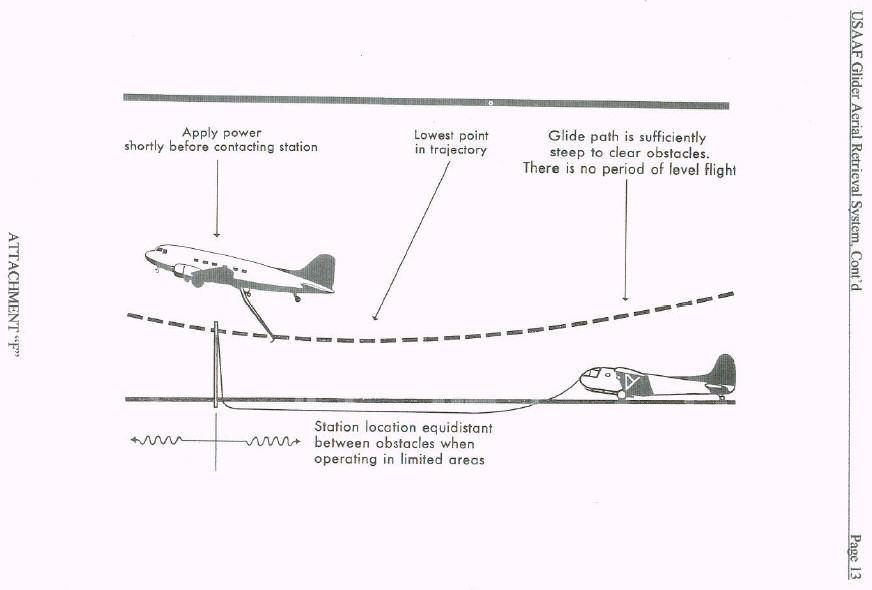
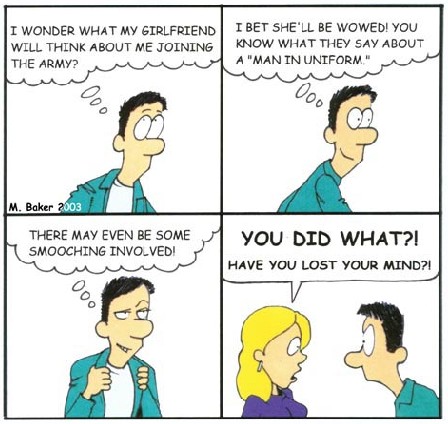
Want Pvt Murphy in your pocket?
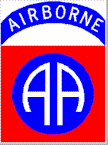
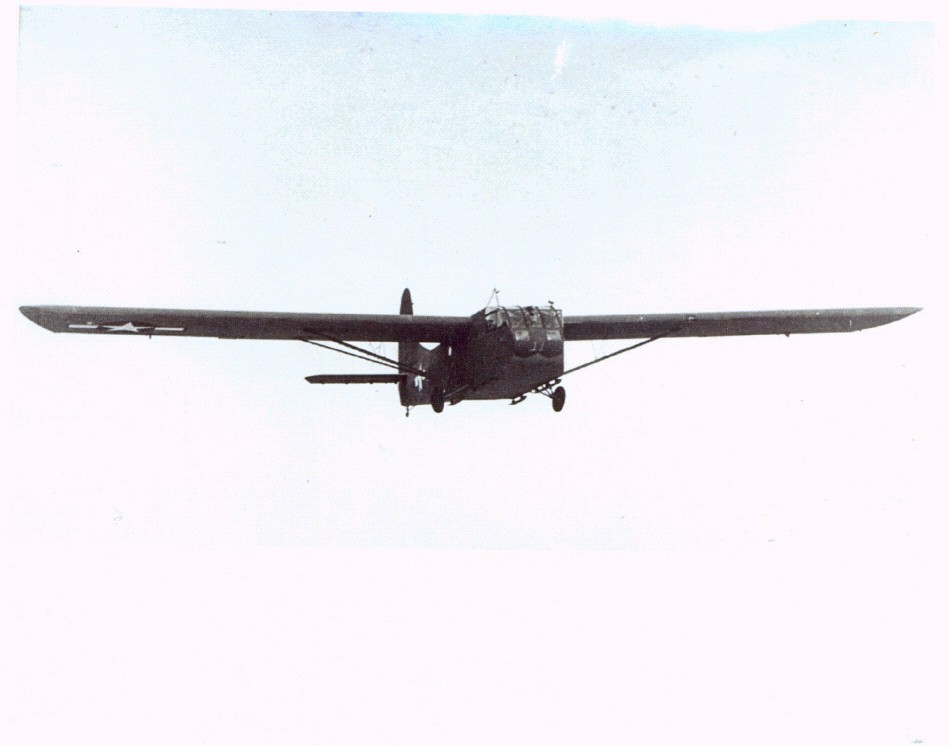
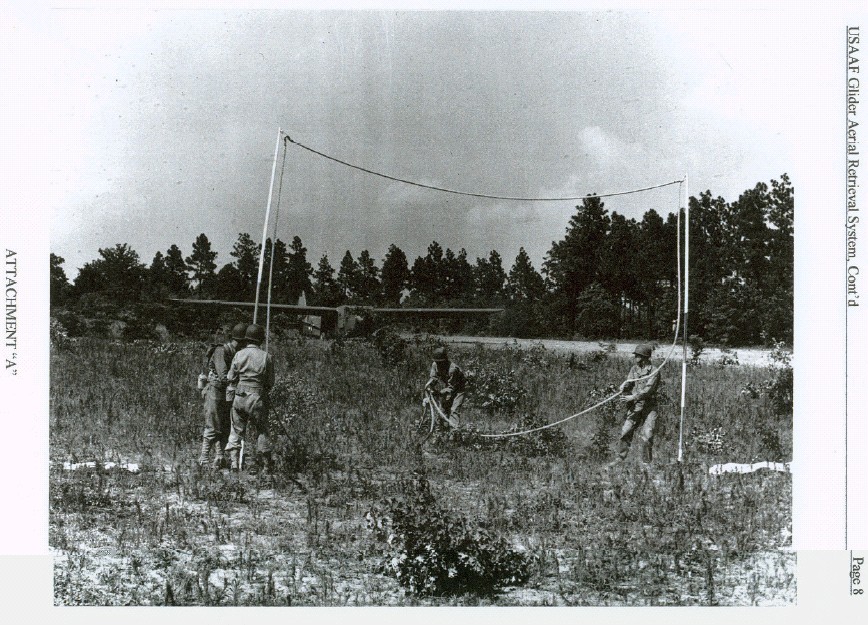
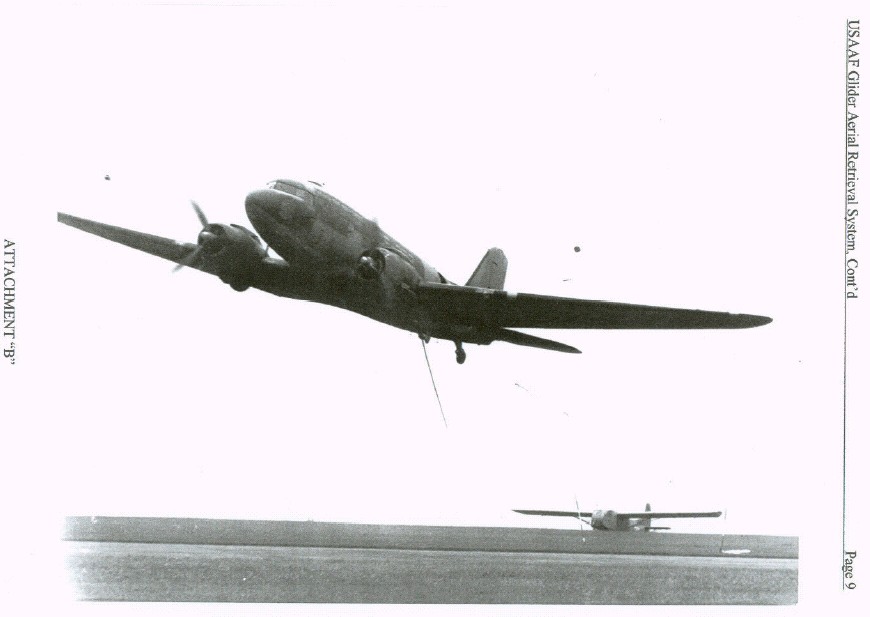
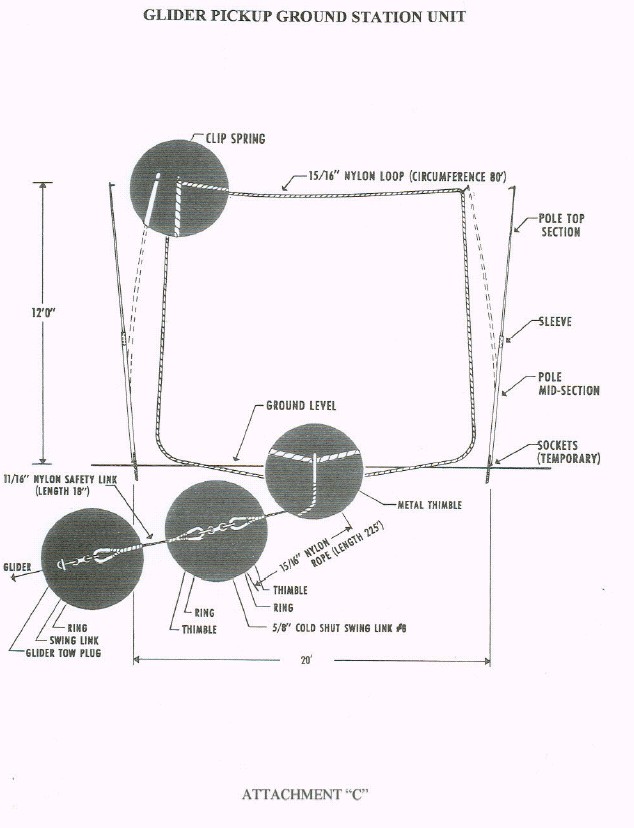
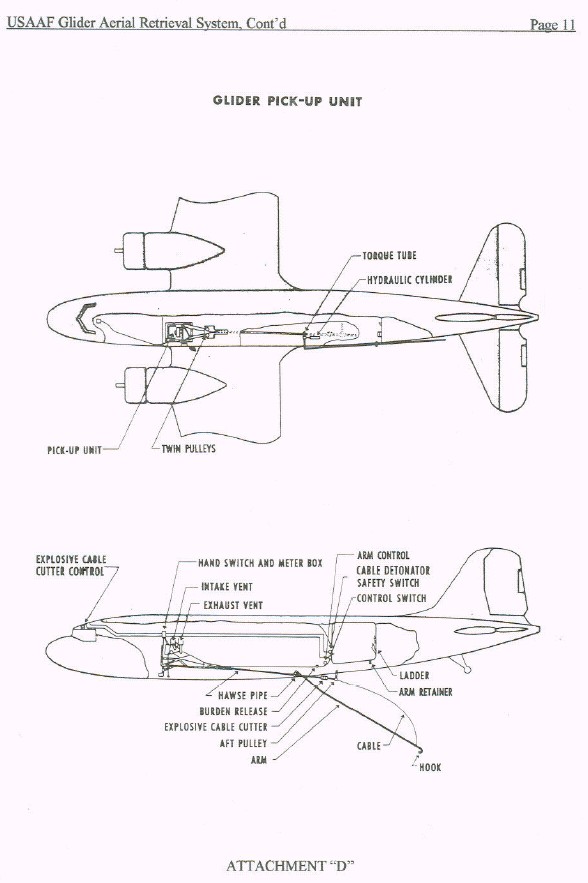
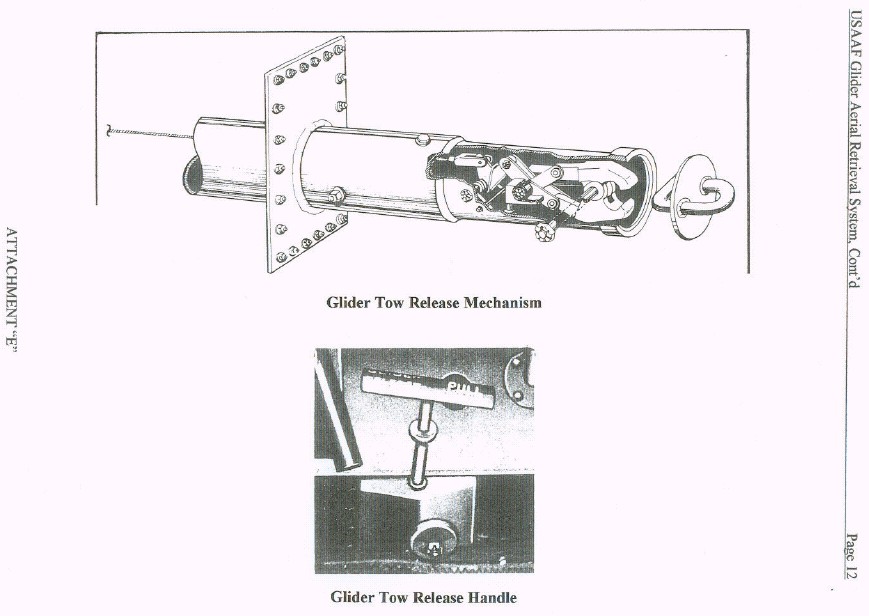
 Return to U.S. Army Airborne Equipment Shop
Return to U.S. Army Airborne Equipment Shop